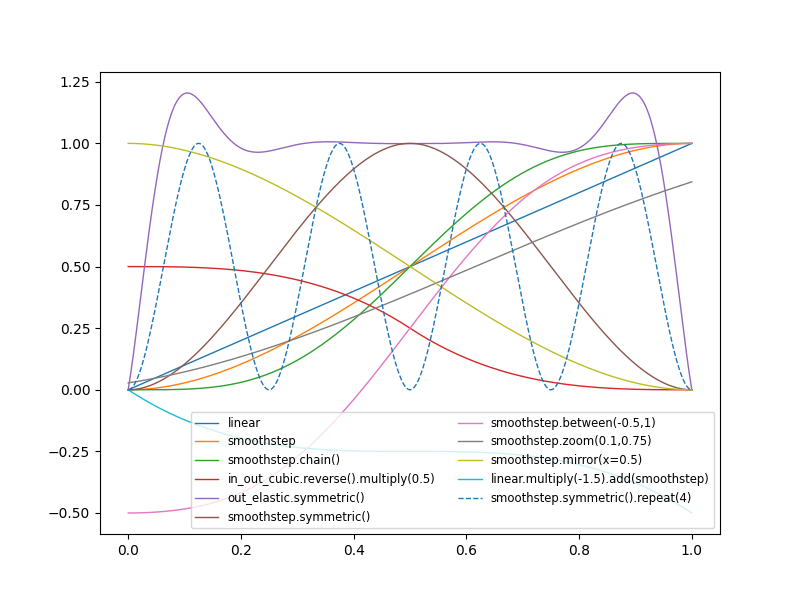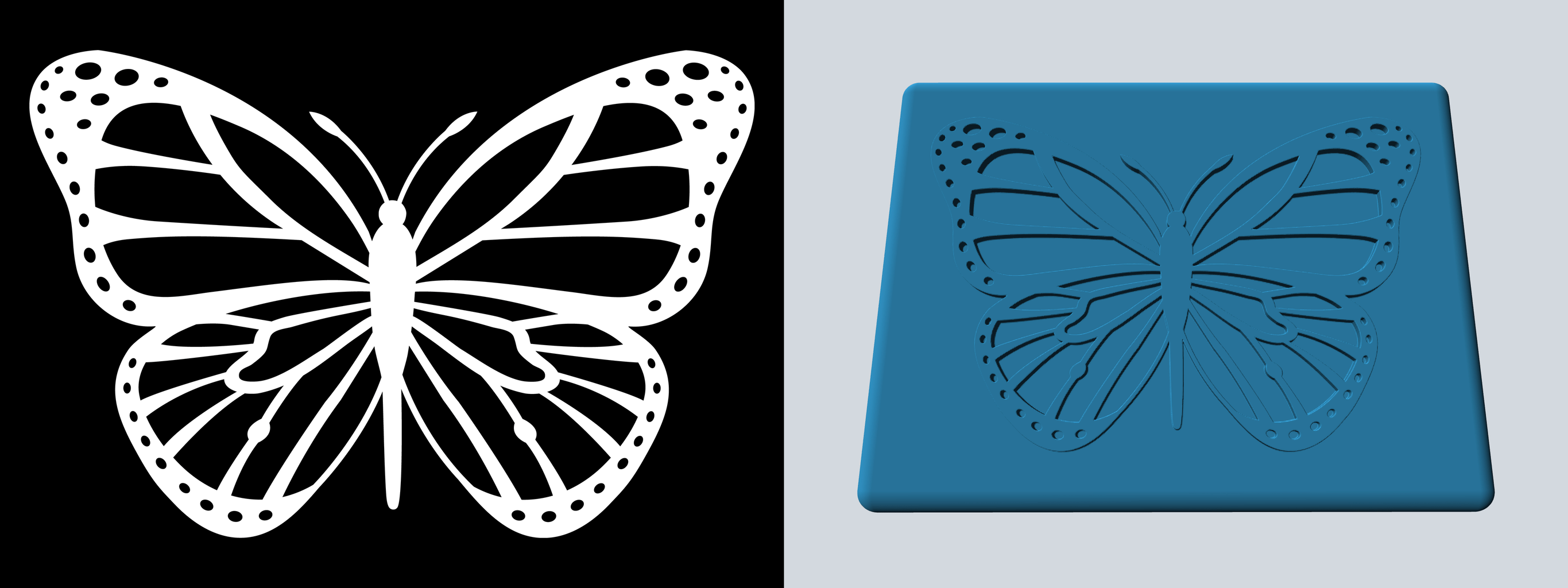Simple 3D mesh generation with Python based on signed distance functions
Project description
📢 Note
This is my fork of fogleman/sdf. This fork is available on GitHub (so it's clear where I forked it from) and on GitLab, where I'll do the deployments, automatic tests and docs at some point. See here for a an effective diff since forking.
📹 Video: My Talk OpenSCAD vs PythonSDF (🇩🇪 German) at the Tübix2023 Linux Day
I added so many things that it doesn't really make sense to just open a PR upstream. Probably I'll just maintain my own fork.
Documentation of the new features is sparse though... 😅
Here is a rough list:
sdf.easegot a huge revamp - easings can now be manipulated and combined easily:ease.linear.plot() # show what it looks like ease.Easing.plot(ease.linear, ease.in_cubic, ease.smoothstep) # show multiple for comparison 3 * ease.linear.symmetric + 1 # This makes a triangle starting at 1 and going as high as 4 in the center ease.smoothstep[0.2:0.8] # zoom into function ease.linear + ease.in_sine # add or multiply functions ease.linear.append(ease.in_cubic.reverse) # stitch functions together # etc, much more, try 'python -m sdf.ease' for a non-comprehensive overview- New objects:
- There's now
bezier()-curves! 🥳
- their width can even be modulated with an easing function (https://fosstodon.org/@nobodyinperson/110367790398144919)
- There's now
Thread()s 🔩
- just a twisted offset infinite cylinder, very nice to 3D print due to the smoothness
sphere(10)-Thread().dilate(0.4)makes a nice thread hole with toleranceScrew()with head for conveniencepieslice(): a vertically infinite pie slice, useful to cut out parts- New operations:
union(),intersection()anddifference()now support bothfillet=andchamfer=mirror()an object at an arbitrary point into an any directionstretch()an object from here to thererotate_stretch()an object to do a kind of partial rotary sweepshear()an object from between two points along a directionmodulate_between(): modify an object's thickness between two points with an easing functiontwist_between(): twist an object between two points with a variable rotation angle specified by an easing functionchamfercut(): cut a chamfer along a plane (a wrapper aroundmodulate_between())shell()can now also do inner and outer shell, not just around boundary Shape analysis (not very precise and reliable yet):.boundset al.: finding boundaries/closest surface points/intersections via optimization of the SDFvolume(): brute-force-approximate the volume Monte-Carlo-style- Many usability fixes here and there
save()is now properly interruptible, no more zombie worker threadssave()now optionally shows the mesh withpyvista(useful in Notebooks)- docstrings are shown properly in interactive Python shells
k()now creates a copy and doesn't modify the object itselfSome things on my TODO list:
- [ ] deleting this point from the README (impossible on mobile apparently)
- [ ] add tests!
- [ ] auto-generated sphinx documentation
- [ ] auto-generated examples with code besides renders
- [ ] importing SVGs 🤔
- [ ] exporting SVGs (with marching squares / contourplots for 2D SDFs)
- [ ] importing STLs 🤔
sdfCAD
Generate 3D meshes based on SDFs (signed distance functions) with a dirt simple Python API.
Special thanks to Michael Fogleman for initializing this codebase in GitHub:fogleman/sdf.
Special thanks also to Inigo Quilez for his excellent documentation on signed distance functions:
Example
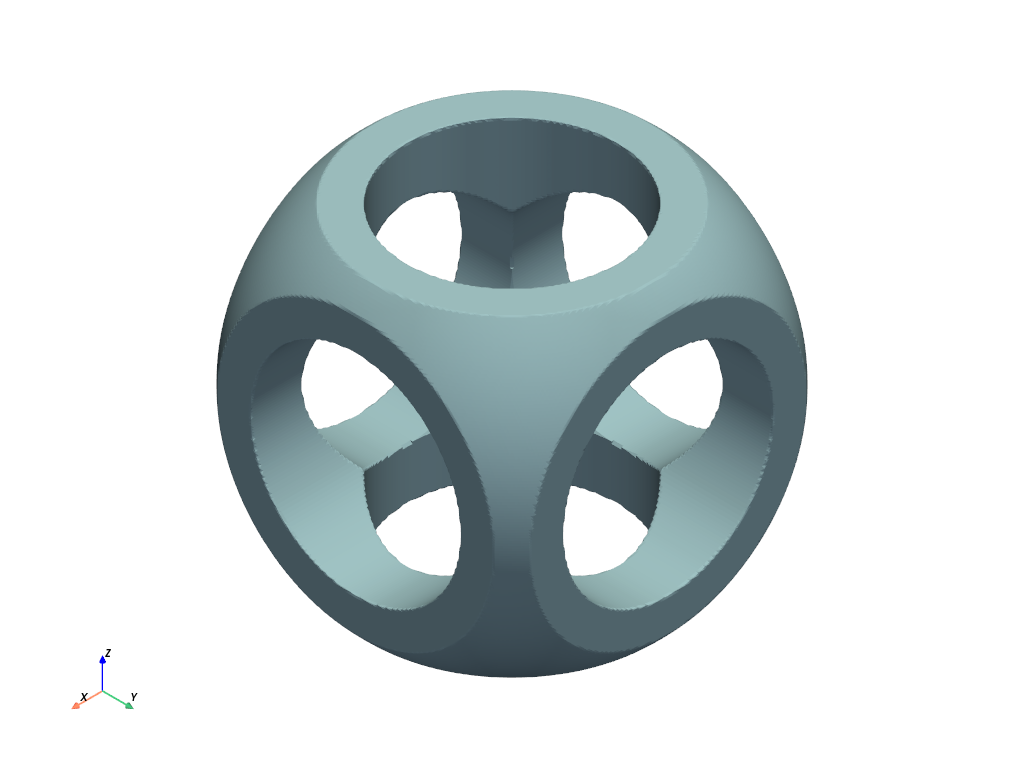
Here is a complete example that generates the model shown. This is the canonical Constructive Solid Geometry example. Note the use of operators for union, intersection, and difference.
from sdfcad import *
f = sphere(1) & box(1.5)
c = cylinder(0.5)
f -= c.orient(X) | c.orient(Y) | c.orient(Z)
f.save('out.stl')
Yes, that's really the entire code! You can 3D print that model or use it in a 3D application.
More Examples
Have a cool example? Submit a PR!
| gearlike.py | knurling.py | blobby.py | weave.py |
|---|---|---|---|
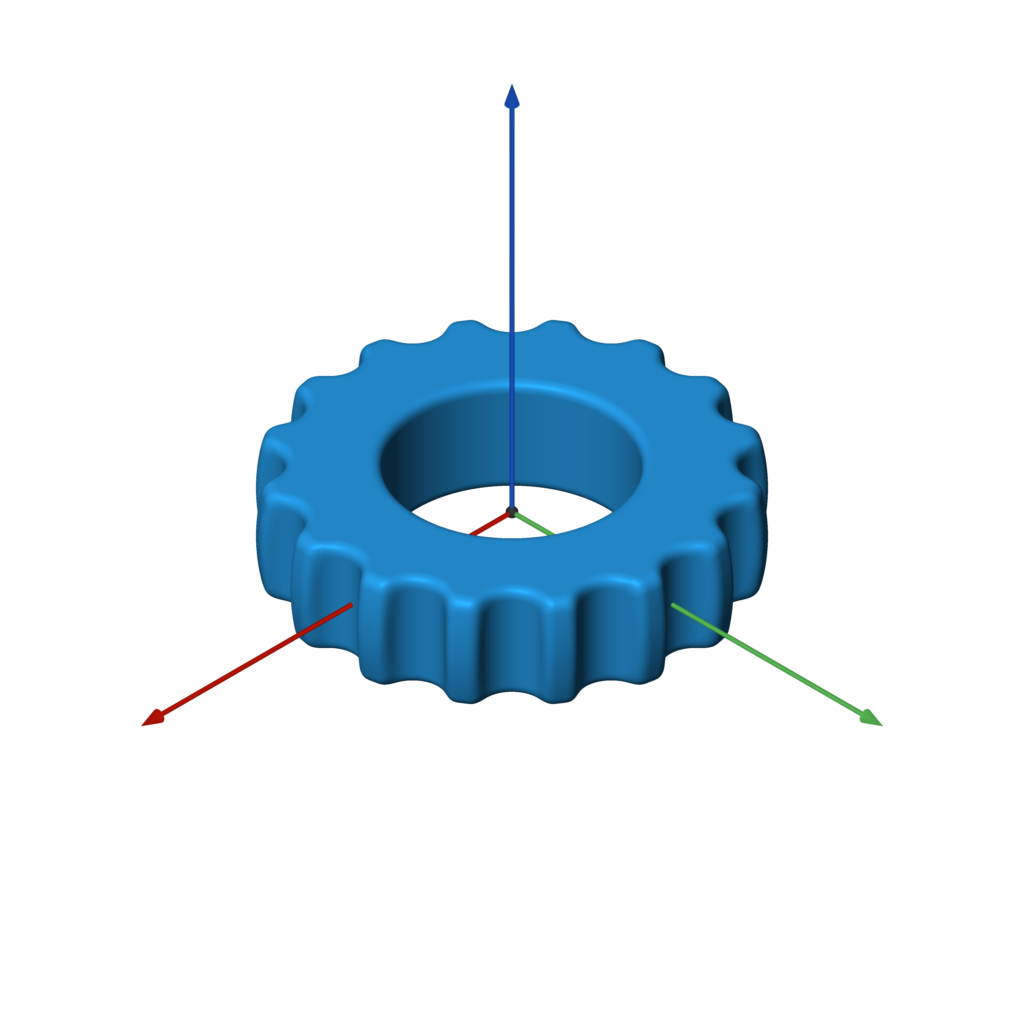 |
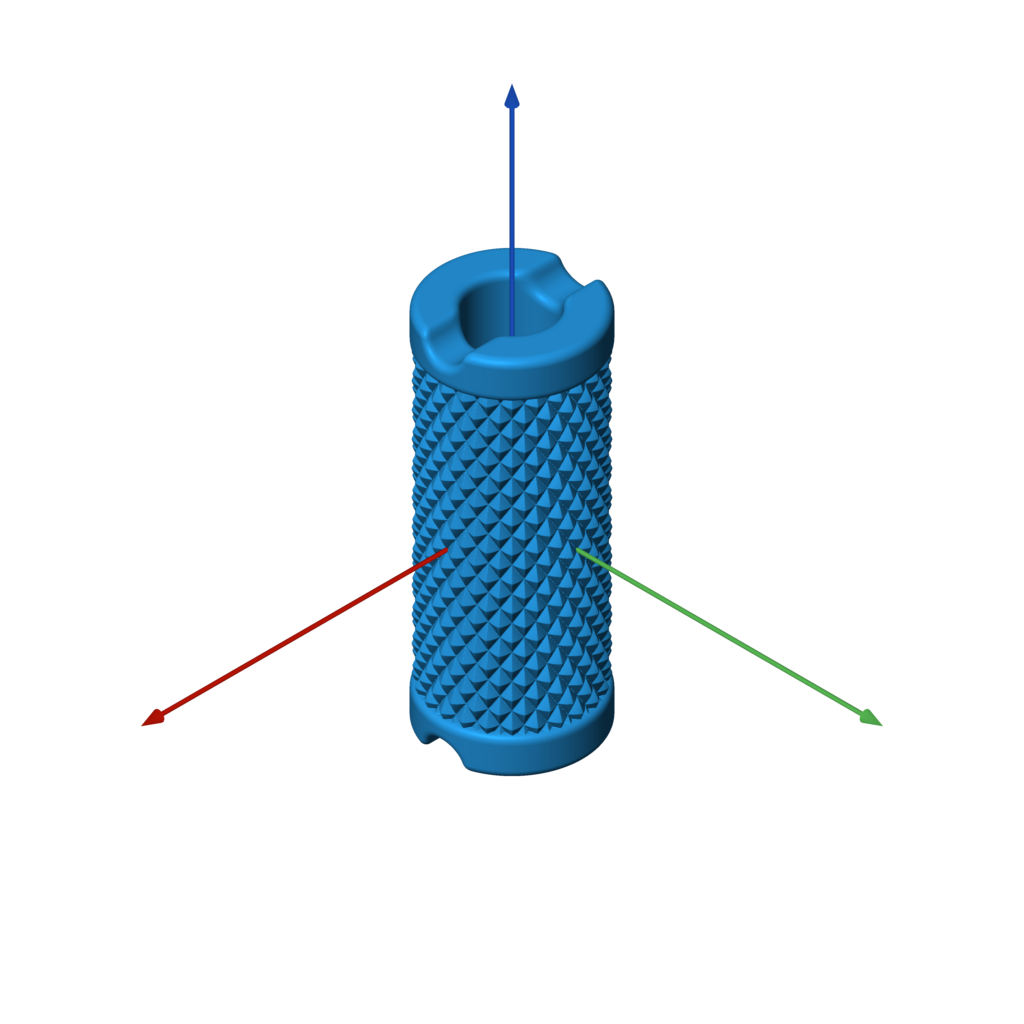 |
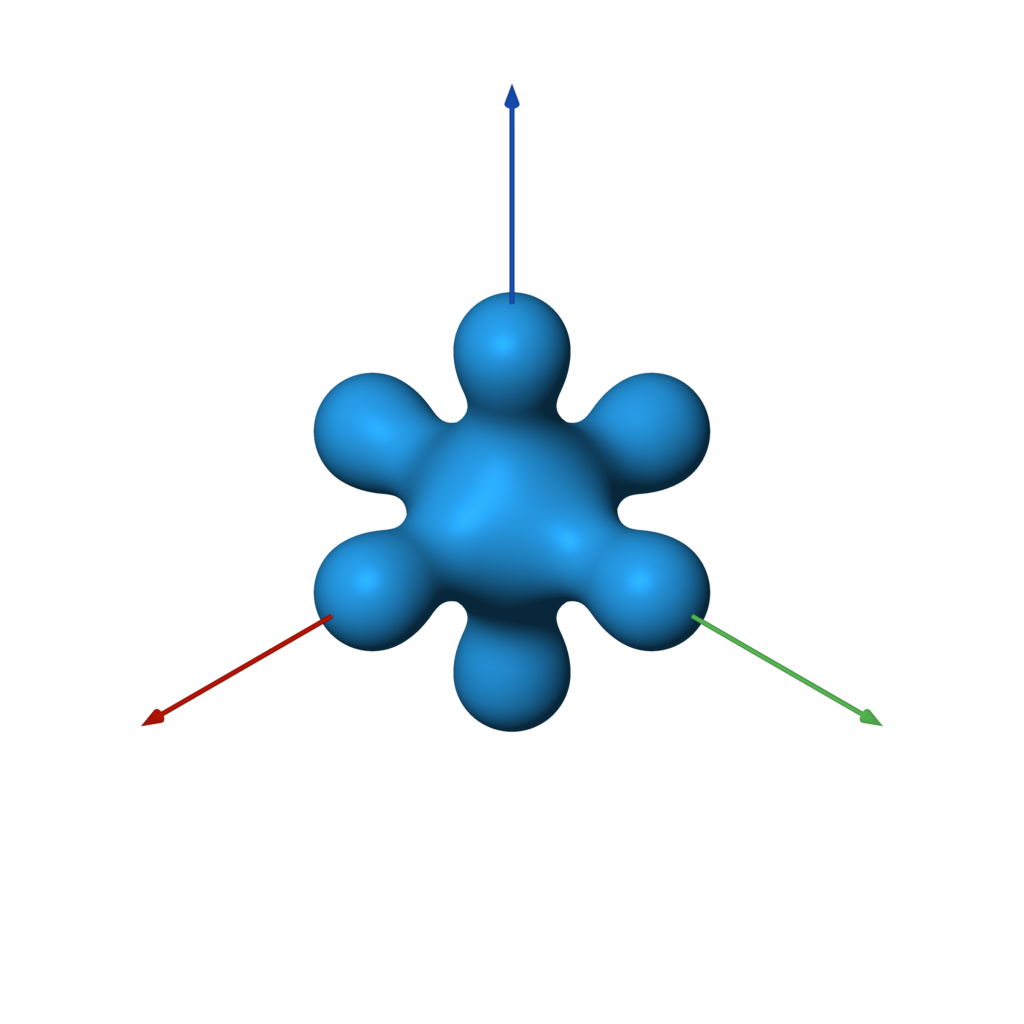 |
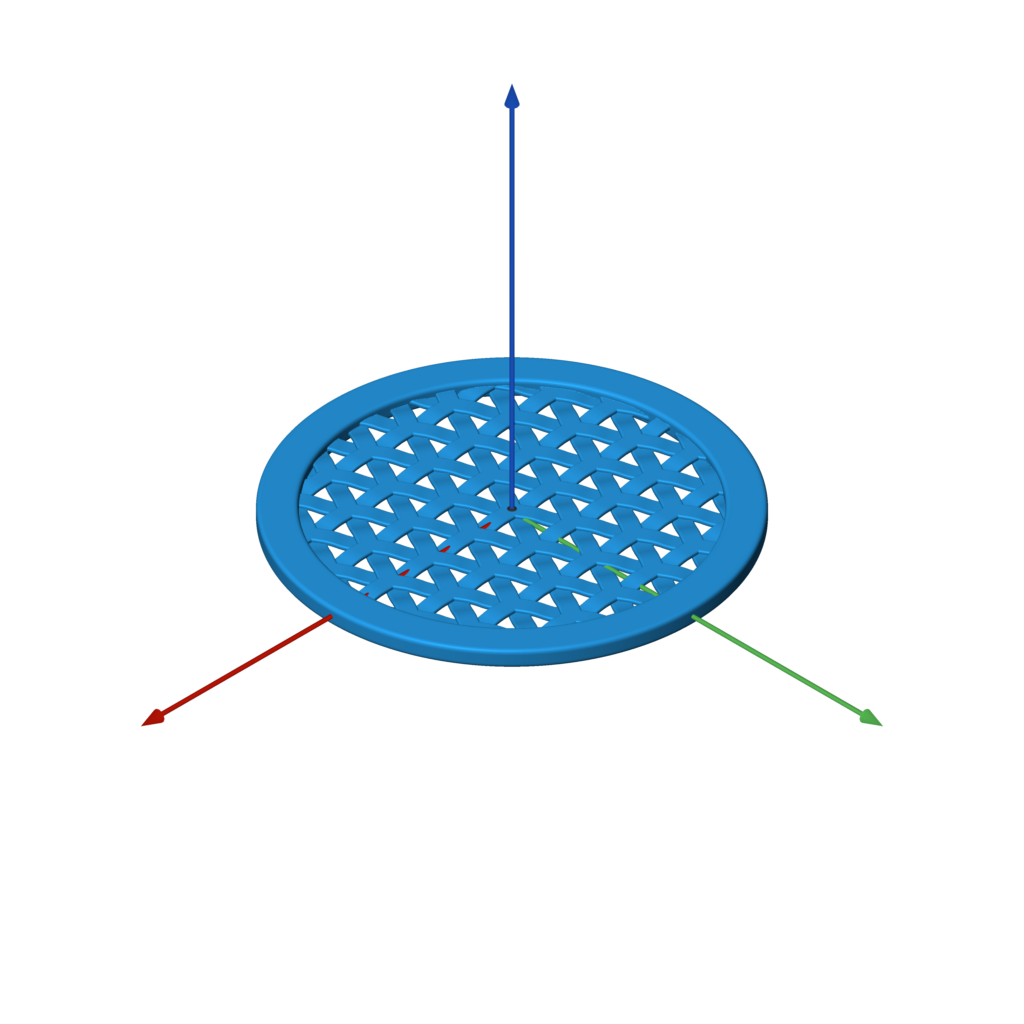 |
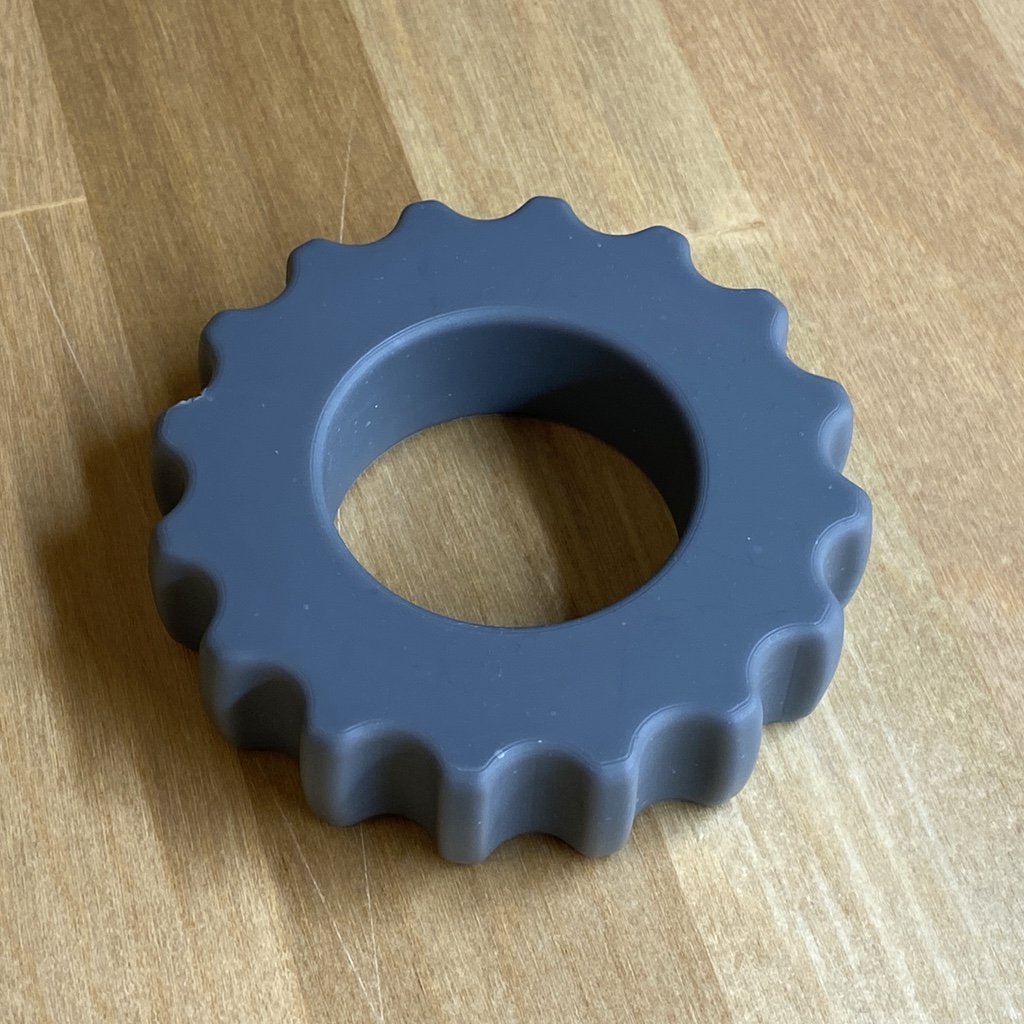 |
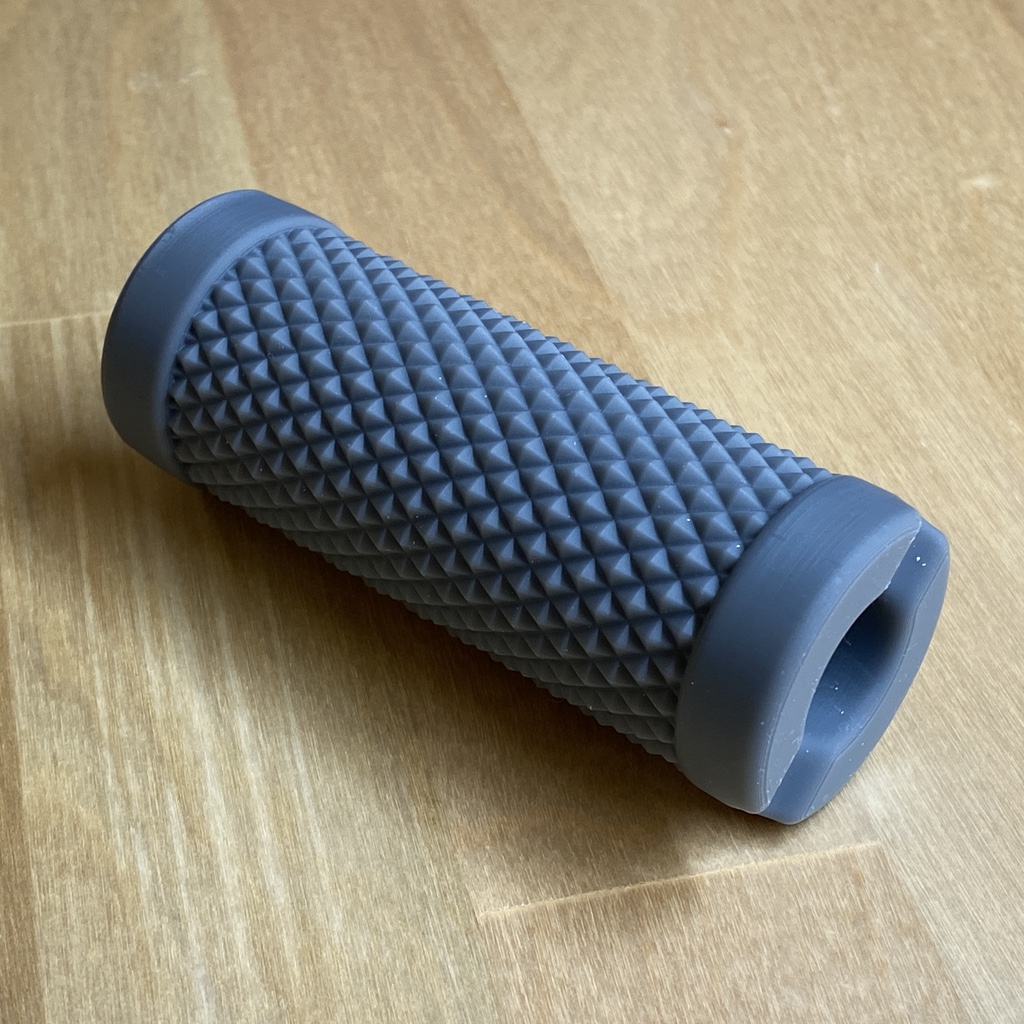 |
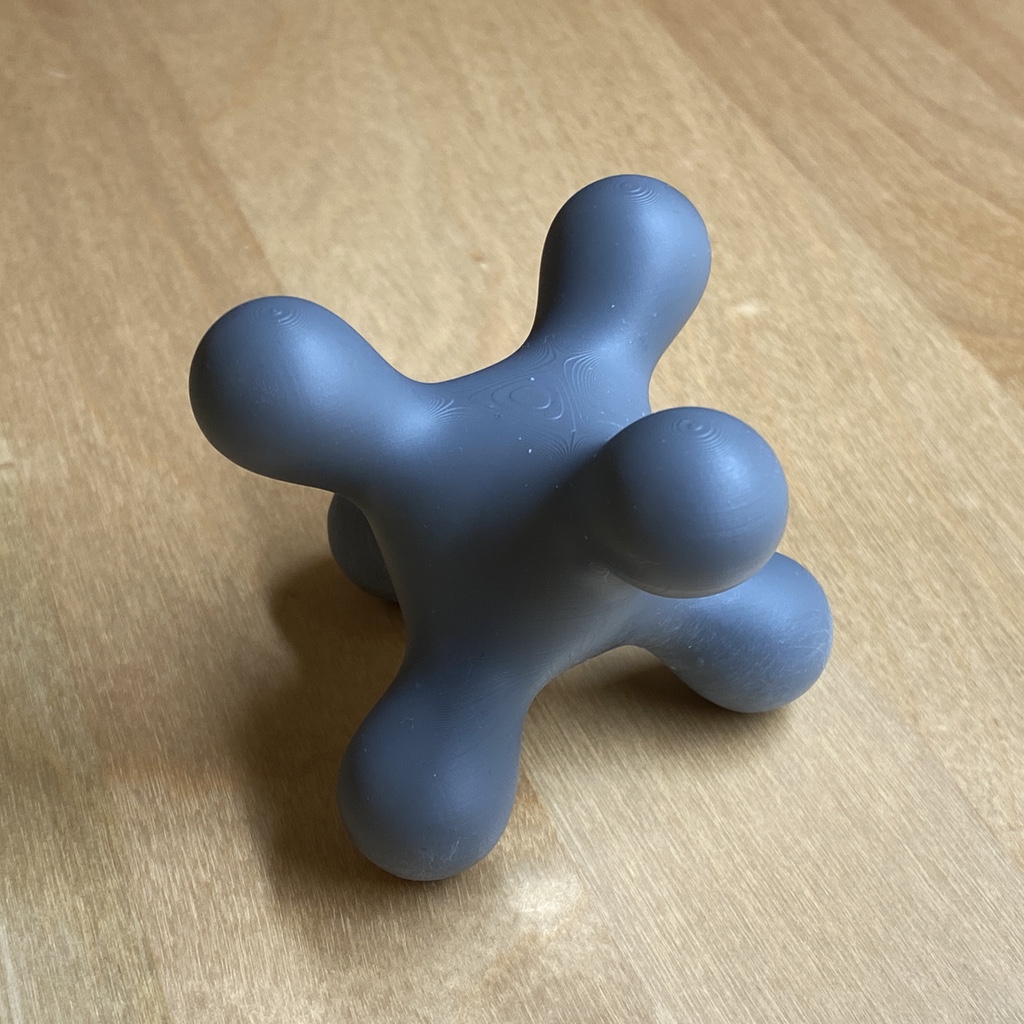 |
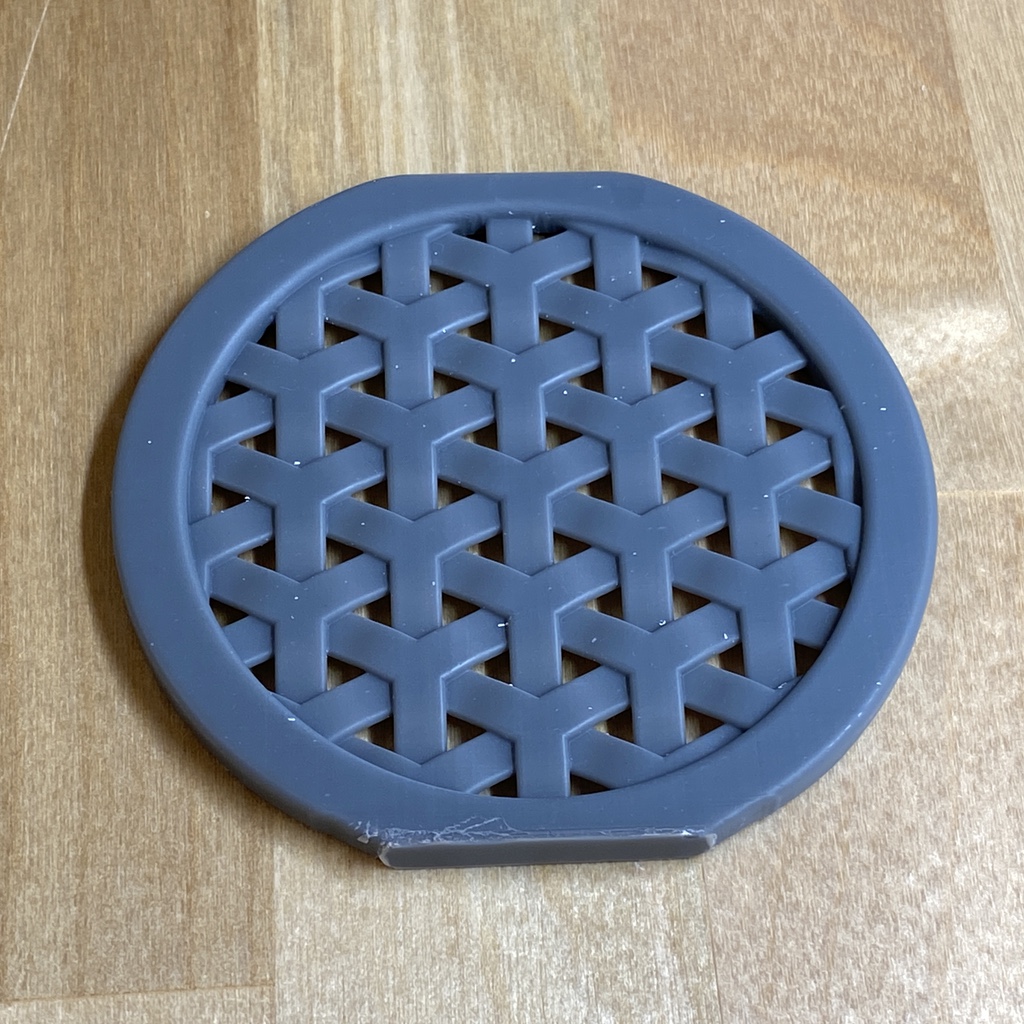 |
Requirements
Note that the dependencies will be automatically installed by when following the directions below.
- Python 3
- matplotlib
- meshio
- numpy
- Pillow
- scikit-image
- scipy
- (pyvista, trame, jupyter, ...)
📥 Installation
Quick install with pip:
# optionally make a virtualenv
python -m venv sdf-venv
source sdf-venv/bin/activate
# from PyPI: together with the dependencies to run within Jupyter
pip install 'sdfcad[jupyter]'
# latest development version
pip install 'sdfcad[jupyter] @ git+https://gitlab.com/nobodyinperson/sdfCAD'
# for headless operation
pip install git+https://gitlab.com/nobodyinperson/sdfCAD
To hack on:
git clone https://gitlab.com/nobodyinperson/sdfCAD
cd sdfCAD
poetry install --all-extras --with=dev
poetry shell # enter a shell in the virtual environment
Confirm that it works:
python examples/example.py # should generate a file named out.stl
File Formats
sdf natively writes binary STL files. For other formats, meshio
is used (based on your output file extension). This adds support for over 20 different 3D file formats,
including OBJ, PLY, VTK, and many more.
Viewing the Mesh
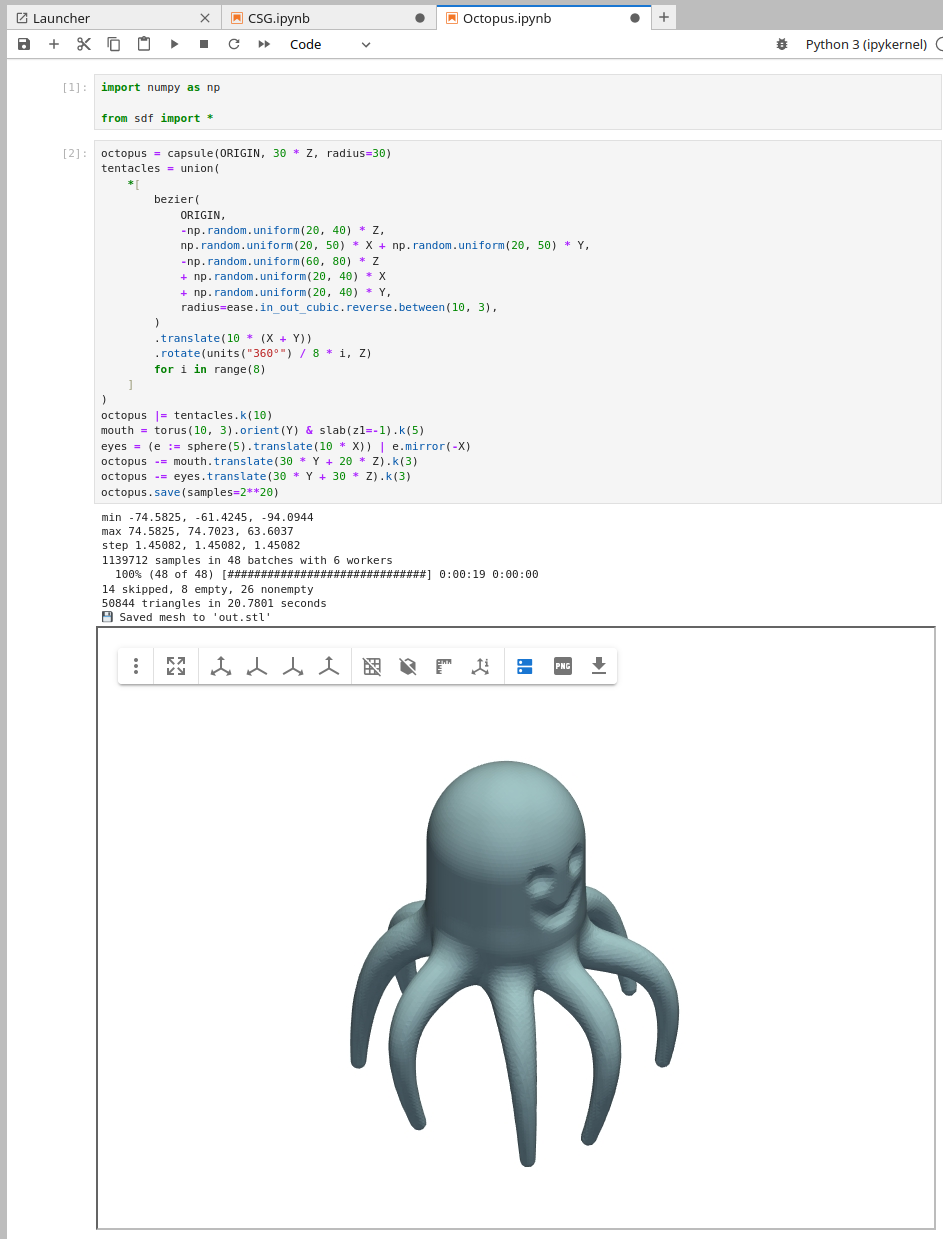
sdfCAD is best worked with in Jupyter Lab:
# launch jupyter lab, this should open your browser with Jupyter Lab
jupyter lab
Alternatively, you can just .save() your object and open the resulting file in your Mesh viewer of choice, e.g.:
- MeshLab
- OpenSCAD (
save(openscad=True)creates a.scadfile you can open. OpenSCAD can also auto-reload if the file changes.) - Michael Fogleman's meshview
API
In all of the below examples, f is any 3D SDF, such as:
f = sphere()
Bounds
The bounding box of the SDF is automatically estimated. Inexact SDFs such as non-uniform scaling may cause issues with this process. In that case you can specify the bounds to sample manually:
f.save('out.stl', bounds=((-1, -1, -1), (1, 1, 1)))
Resolution
The resolution of the mesh is also computed automatically. There are two ways
to specify the resolution. You can set the resolution directly with step:
f.save('out.stl', step=0.01)
f.save('out.stl', step=(0.01, 0.02, 0.03)) # non-uniform resolution
Or you can specify approximately how many points to sample:
f.save('out.stl', samples=2**24) # sample about 16M points
By default, samples=2**18 is used.
Tip: Use the default resolution while developing your SDF. Then when you're done, crank up the resolution for your final output.
Batches
The SDF is sampled in batches. By default the batches have 32**3 = 32768
points each. This batch size can be overridden:
f.save('out.stl', batch_size=64) # instead of 32
The code attempts to skip any batches that are far away from the surface of the mesh. Inexact SDFs such as non-uniform scaling may cause issues with this process, resulting in holes in the output mesh (where batches were skipped when they shouldn't have been). To avoid this, you can disable sparse sampling:
f.save('out.stl', sparse=False) # force all batches to be completely sampled
Worker Threads
The SDF is sampled in batches using worker threads. By default,
multiprocessing.cpu_count() worker threads are used. This can be overridden:
f.save('out.stl', workers=1) # only use one worker thread
Without Saving
You can of course generate a mesh without writing it to an STL file:
points = f.generate() # takes the same optional arguments as `save`
print(len(points)) # print number of points (3x the number of triangles)
print(points[:3]) # print the vertices of the first triangle
If you want to save an STL after generate, just use:
write_binary_stl(path, points)
Visualizing the SDF
The save() method automatically shows the object with pyvista if available (e.g. when you installed with the jupyter extra as described above).
# Turn automatic plot visualization off with this:
sphere().save(plot=False)
In Jupyter, you can try switching the backend between client (faster) or server (slower but probably more reliable).
import pyvista as pv
pv.set_jupyter_backend("client")
# or pv.set_jupyter_backend("server")
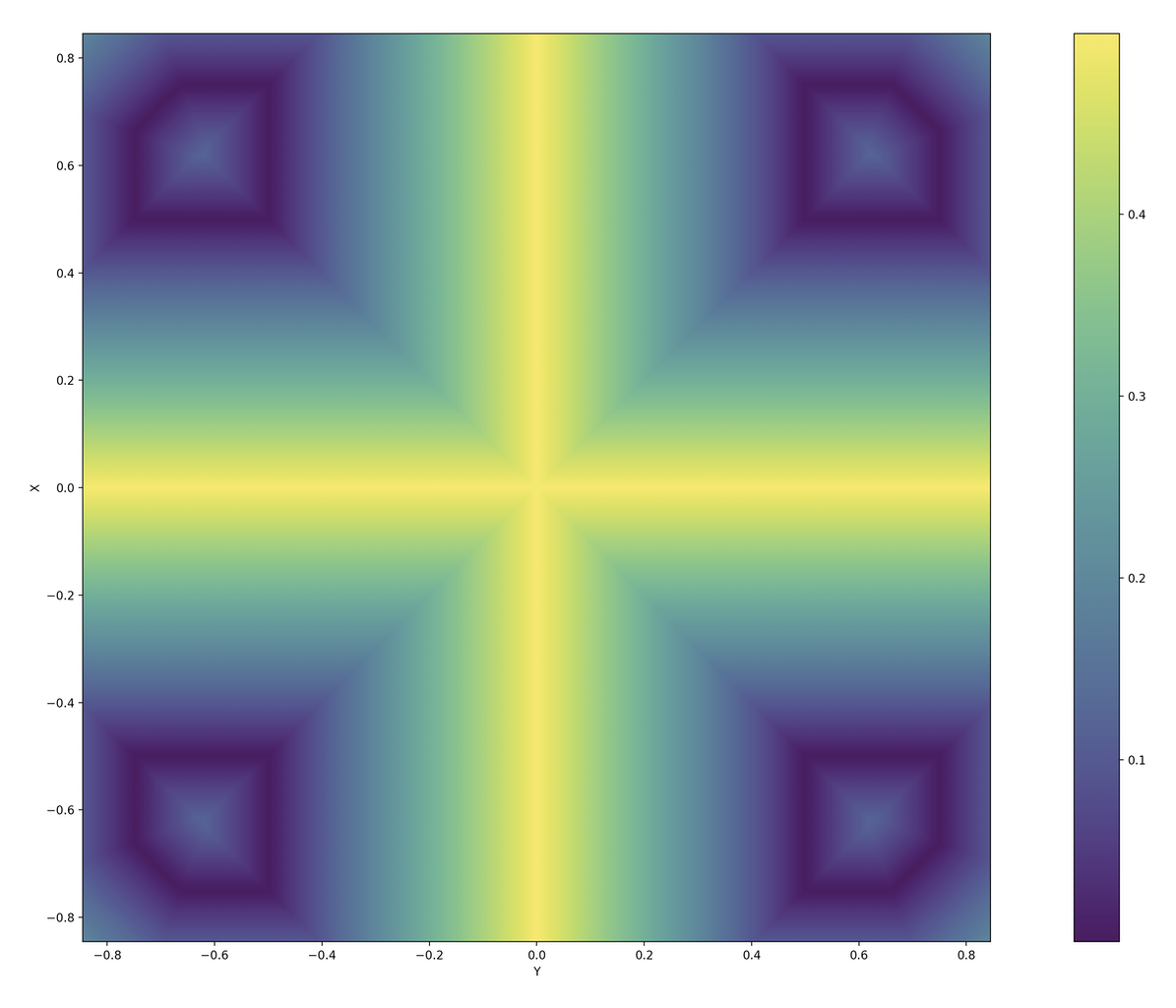
You can plot a visualization of a 2D slice of the SDF using matplotlib. This can be useful for debugging purposes.
f.show_slice(z=0)
f.show_slice(z=0, abs=True) # show abs(f)
You can specify a slice plane at any X, Y, or Z coordinate. You can also specify the bounds to plot.
Note that matplotlib is only imported if this function is called, so it
isn't strictly required as a dependency.
How it Works
The code simply uses the Marching Cubes algorithm to generate a mesh from the Signed Distance Function.
This would normally be abysmally slow in Python. However, numpy is used to evaluate the SDF on entire batches of points simultaneously. Furthermore, multiple threads are used to process batches in parallel. The result is surprisingly fast (for marching cubes). Meshes of adequate detail can still be quite large in terms of number of triangles.
The core "engine" of the sdf library is very small and can be found in
mesh.py.
In short, there is nothing algorithmically revolutionary here. The goal is to provide a simple, fun, and easy-to-use API for generating 3D models in our favorite language Python.
Files
- sdf/d2.py: 2D signed distance functions
- sdf/d3.py: 3D signed distance functions
- sdf/dn.py: Dimension-agnostic signed distance functions
- sdf/ease.py: Easing functions that operate on numpy arrays. Some SDFs take an easing function as a parameter.
- sdf/mesh.py: The core mesh-generation engine. Also includes code for estimating the bounding box of an SDF and for plotting a 2D slice of an SDF with matplotlib.
- sdf/progress.py: A console progress bar.
- sdf/stl.py: Code for writing a binary STL file.
- sdf/text.py: Generate 2D SDFs for text (which can then be extruded)
- sdf/util.py: Utility constants and functions.
SDF Implementation
It is reasonable to write your own SDFs beyond those provided by the built-in library. Browse the SDF implementations to understand how they are implemented. Here are some simple examples:
@sdf3
def sphere(radius=1, center=ORIGIN):
def f(p):
return np.linalg.norm(p - center, axis=1) - radius
return f
An SDF is simply a function that takes a numpy array of points with shape (N, 3)
for 3D SDFs or shape (N, 2) for 2D SDFs and returns the signed distance for each
of those points as an array of shape (N, 1). They are wrapped with the
@sdf3 decorator (or @sdf2 for 2D SDFs) which make boolean operators work,
add the save method, add the operators like translate, etc.
@op3
def translate(other, offset):
def f(p):
return other(p - offset)
return f
An SDF that operates on another SDF (like the above translate) should use
the @op3 decorator instead. This will register the function such that SDFs
can be chained together like:
f = sphere(1).translate((1, 2, 3))
Instead of what would otherwise be required:
f = translate(sphere(1), (1, 2, 3))
Remember, it's Python!
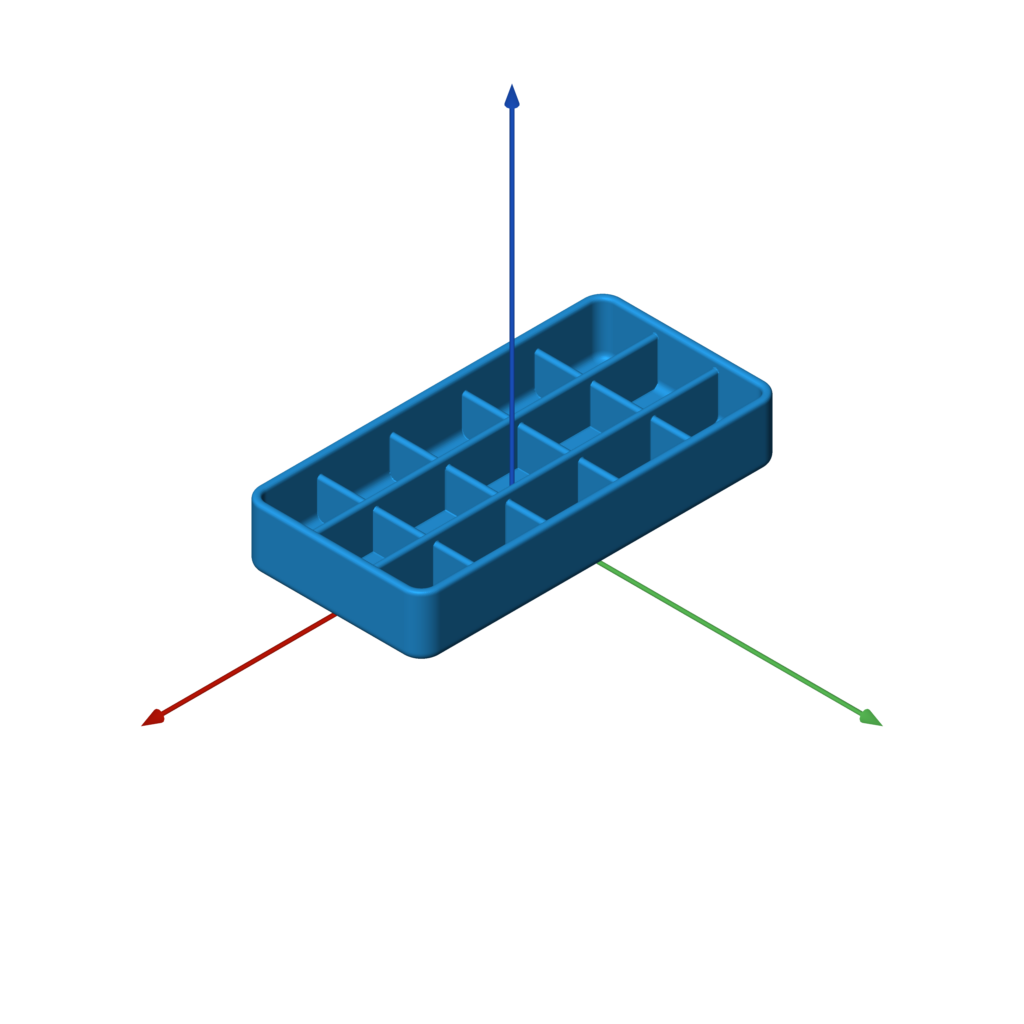
Remember, this is Python, so it's fully programmable. You can and should split up your model into parameterized sub-components, for example. You can use for loops and conditionals wherever applicable. The sky is the limit!
See the customizable box example for some starting ideas.
Easings
Many transformations in sdfCAD take an optional easing parameter e.
This is a scalar function that takes an input between 0 and 1 and output another scalar, typically also between 0 and 1.
For convenience, there are many predefined easing functions available, the most important ones probably being ease.linear and ease.smoothstep.
Easings can be scaled, added, multiplied, chained, zoomed, etc. to customize them.
An easing function can be plotted via its plot() method (e.g. ease.in_out_cubic.plot())
Here is an example of some operations:
ease.Easing.plot(
ease.linear,
ease.smoothstep,
ease.smoothstep.chain(),
0.5 * ease.in_out_cubic.reverse,
ease.out_elastic.symmetric,
ease.smoothstep.symmetric,
ease.smoothstep.between(-0.5,1),
ease.smoothstep[0.1:0.75],
ease.smoothstep.mirror(),
-3*ease.linear + ease.smoothstep,
)
Function Reference
3D Primitives
sphere
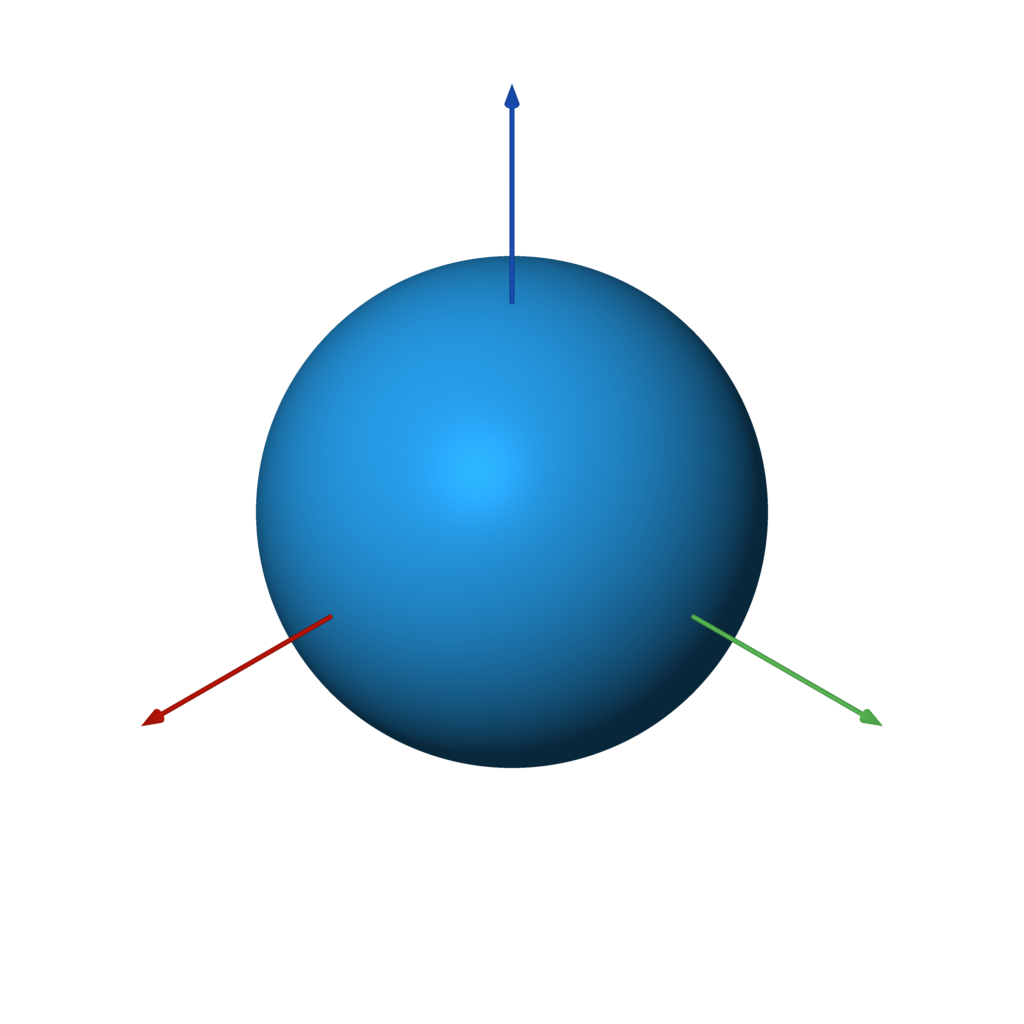
sphere(radius=1, center=ORIGIN)
f = sphere() # unit sphere
f = sphere(2) # specify radius
f = sphere(1, (1, 2, 3)) # translated sphere
box
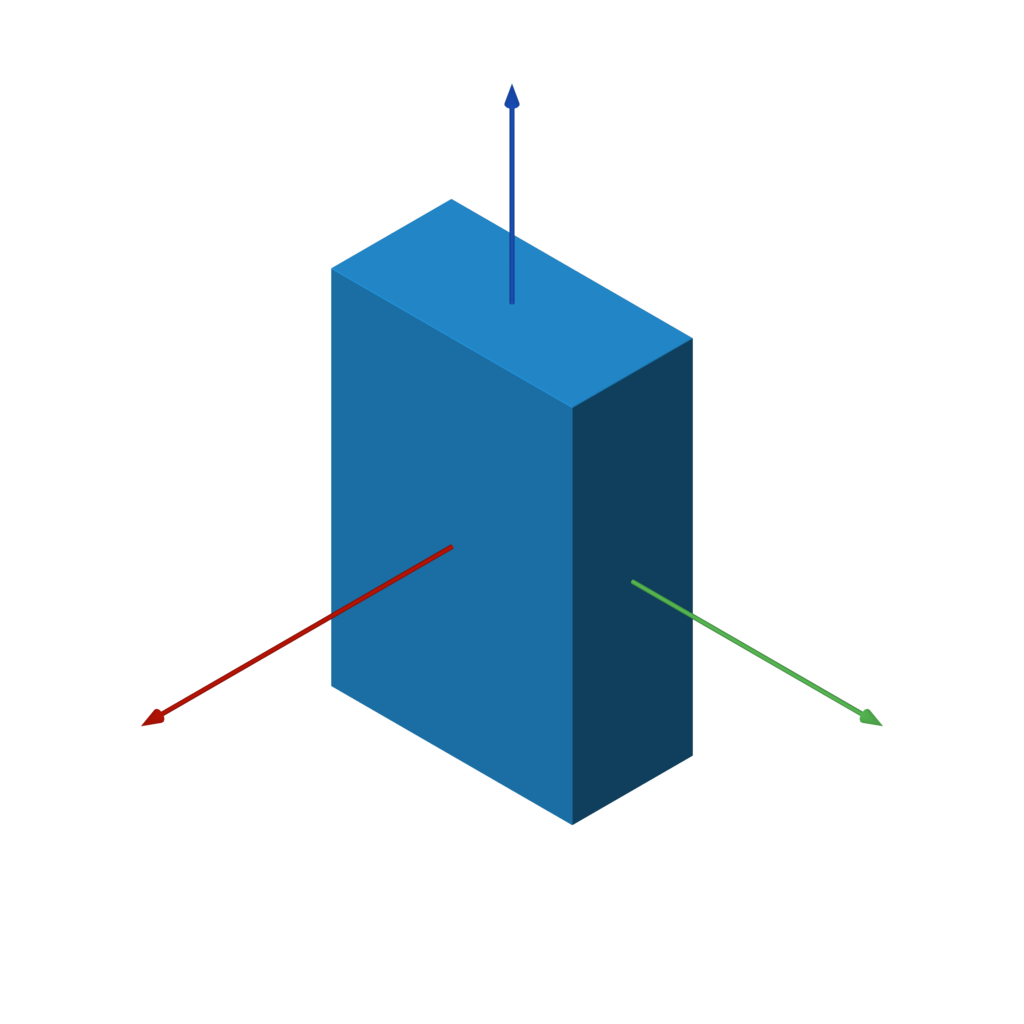
box(size=1, center=ORIGIN, a=None, b=None)
f = box(1) # all side lengths = 1
f = box((1, 2, 3)) # different side lengths
f = box(a=(-1, -1, -1), b=(3, 4, 5)) # specified by bounds
rounded_box
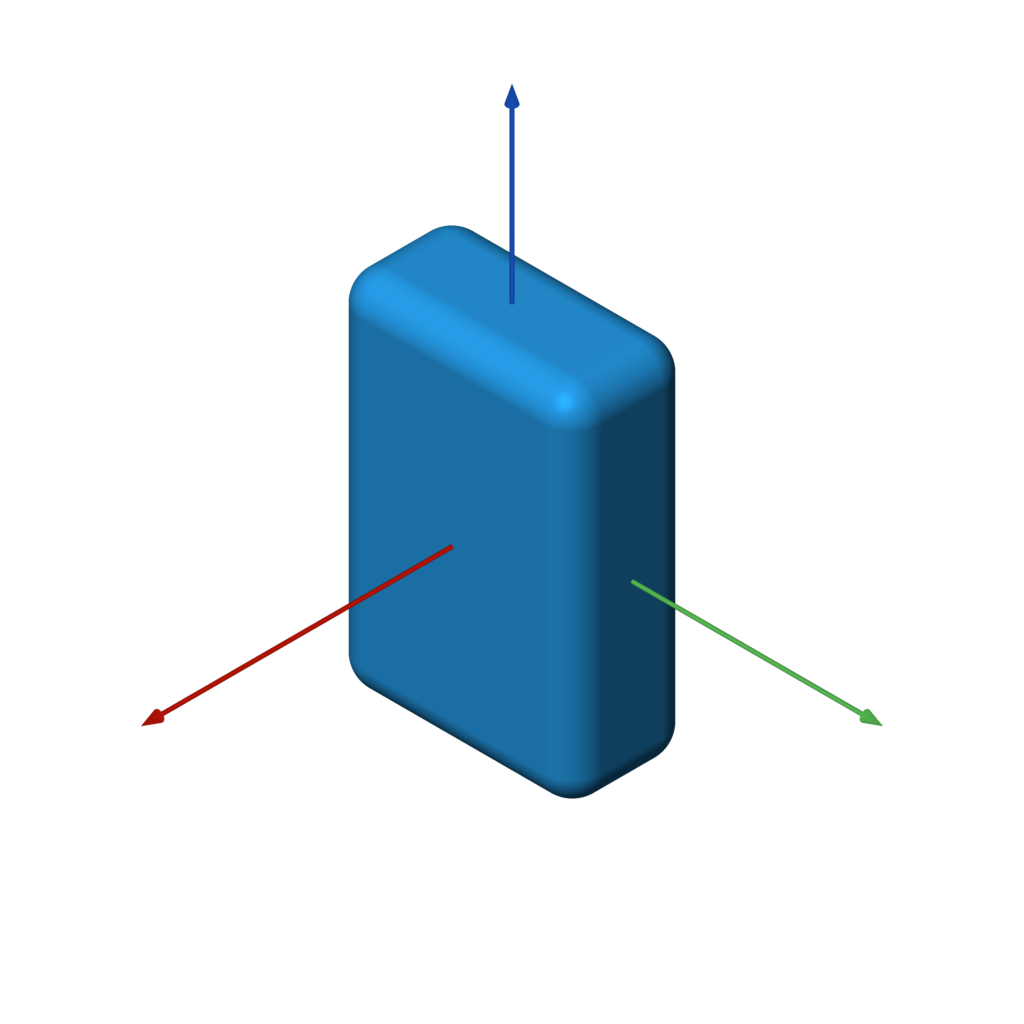
rounded_box(size, radius)
f = rounded_box((1, 2, 3), 0.25)
wireframe_box
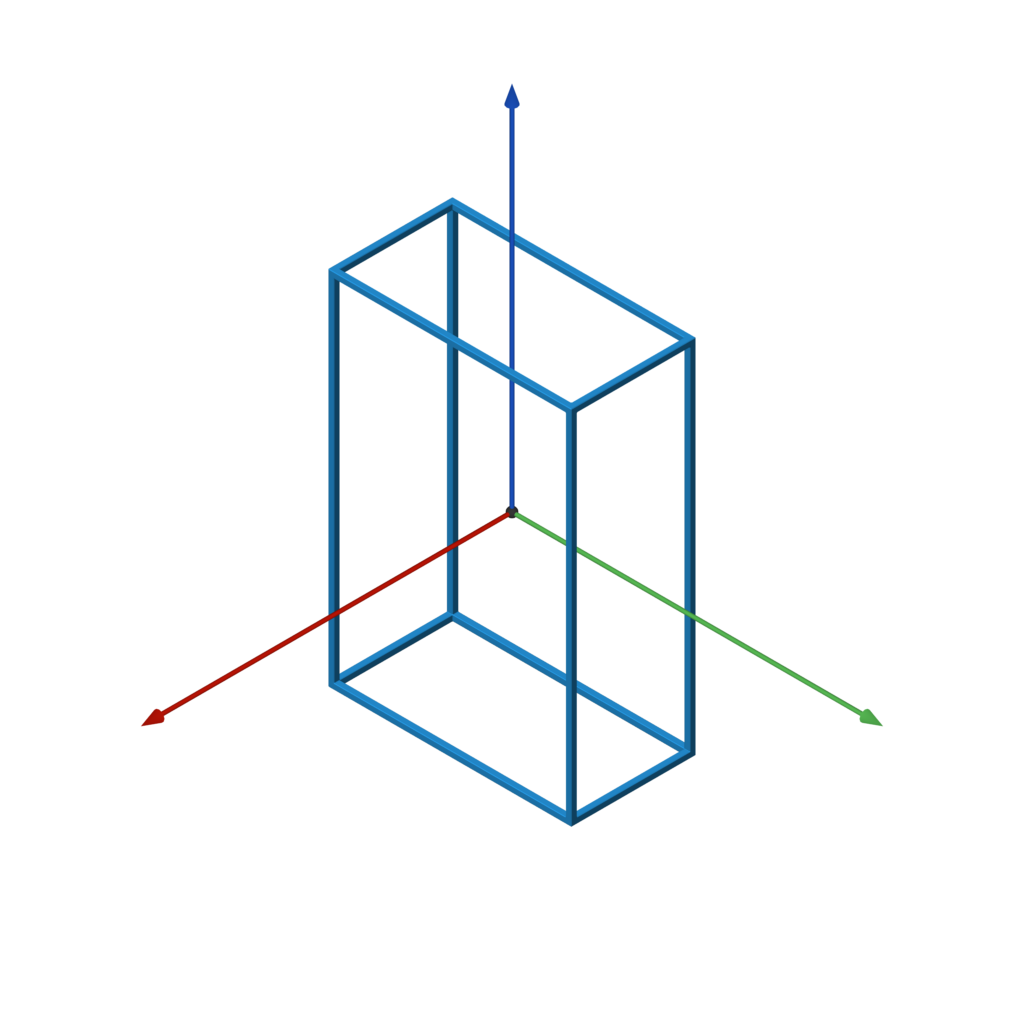
wireframe_box(size, thickness)
f = wireframe_box((1, 2, 3), 0.05)
torus
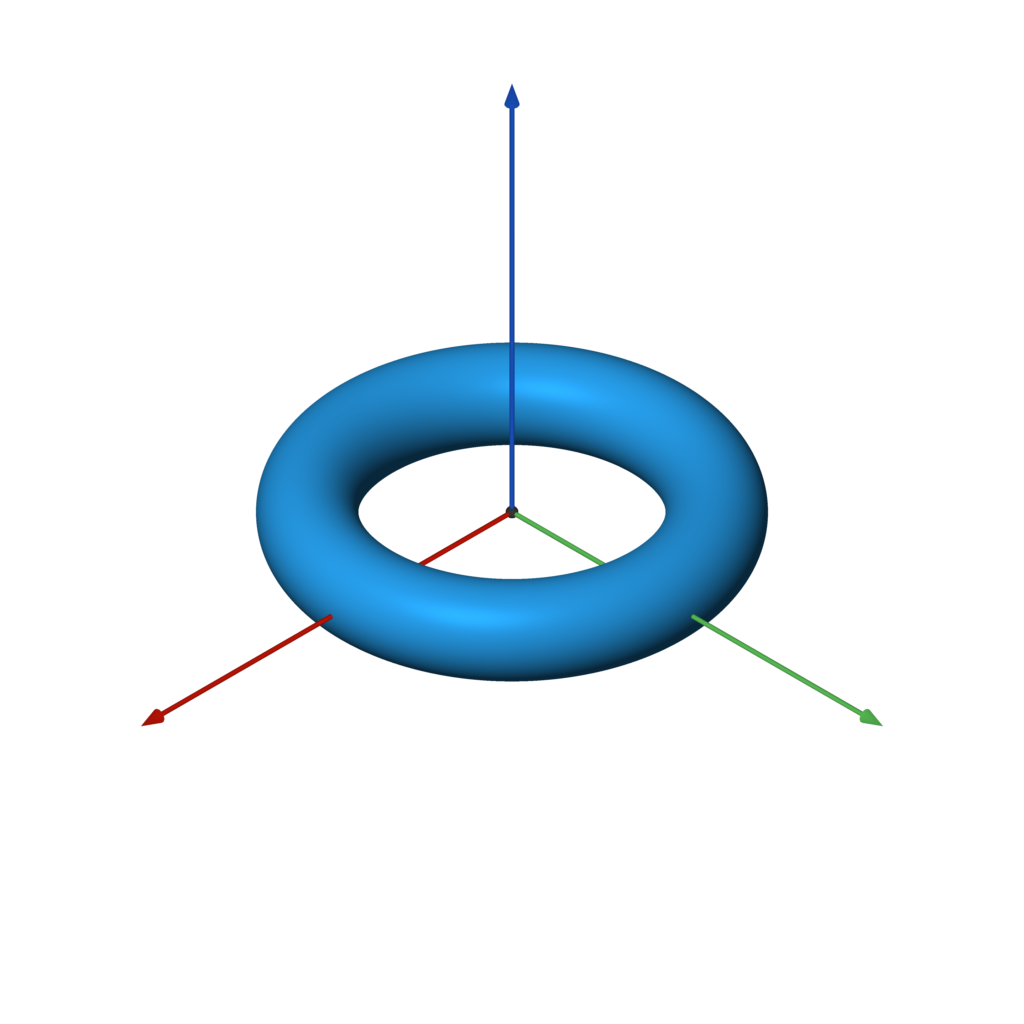
torus(r1, r2)
f = torus(1, 0.25)
capsule
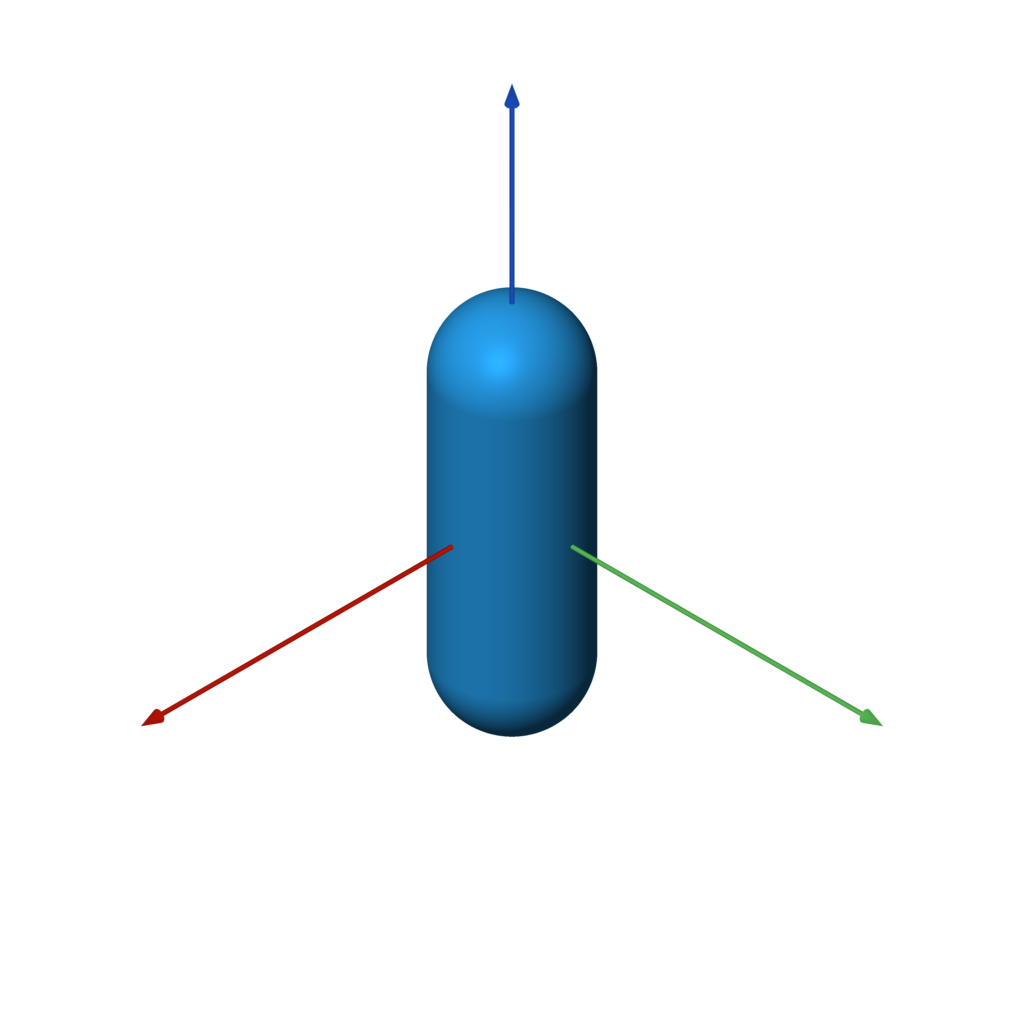
capsule(a, b, radius)
f = capsule(-Z, Z, 0.5)
capped_cylinder
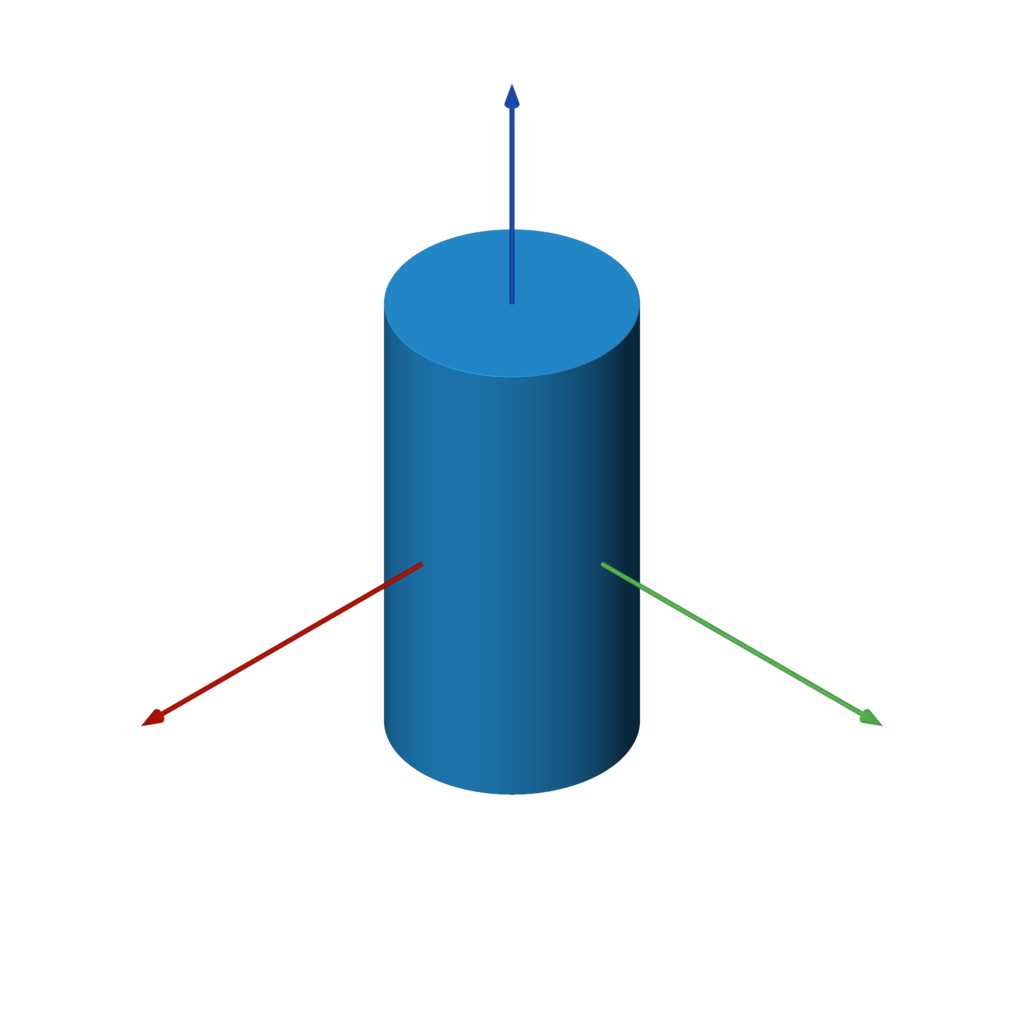
capped_cylinder(a, b, radius)
f = capped_cylinder(-Z, Z, 0.5)
rounded_cylinder
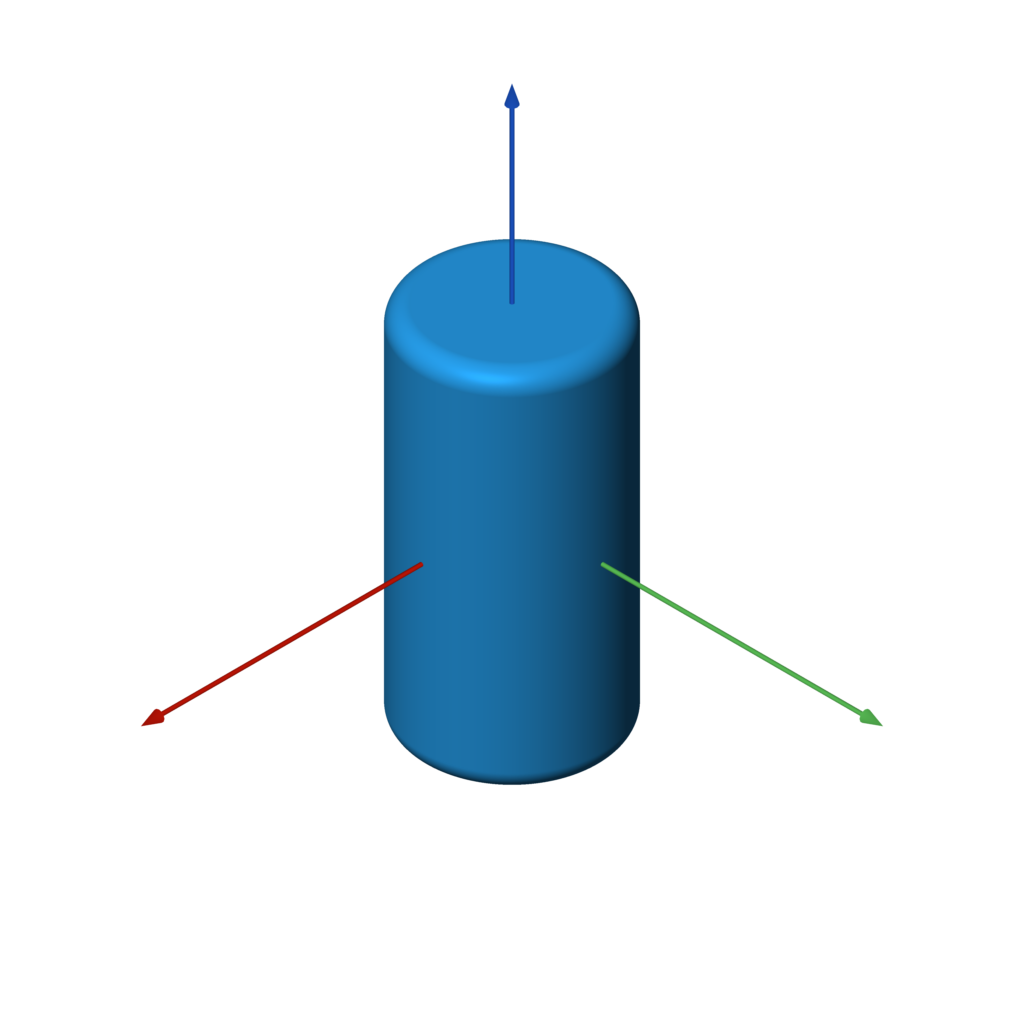
rounded_cylinder(ra, rb, h)
f = rounded_cylinder(0.5, 0.1, 2)
capped_cone
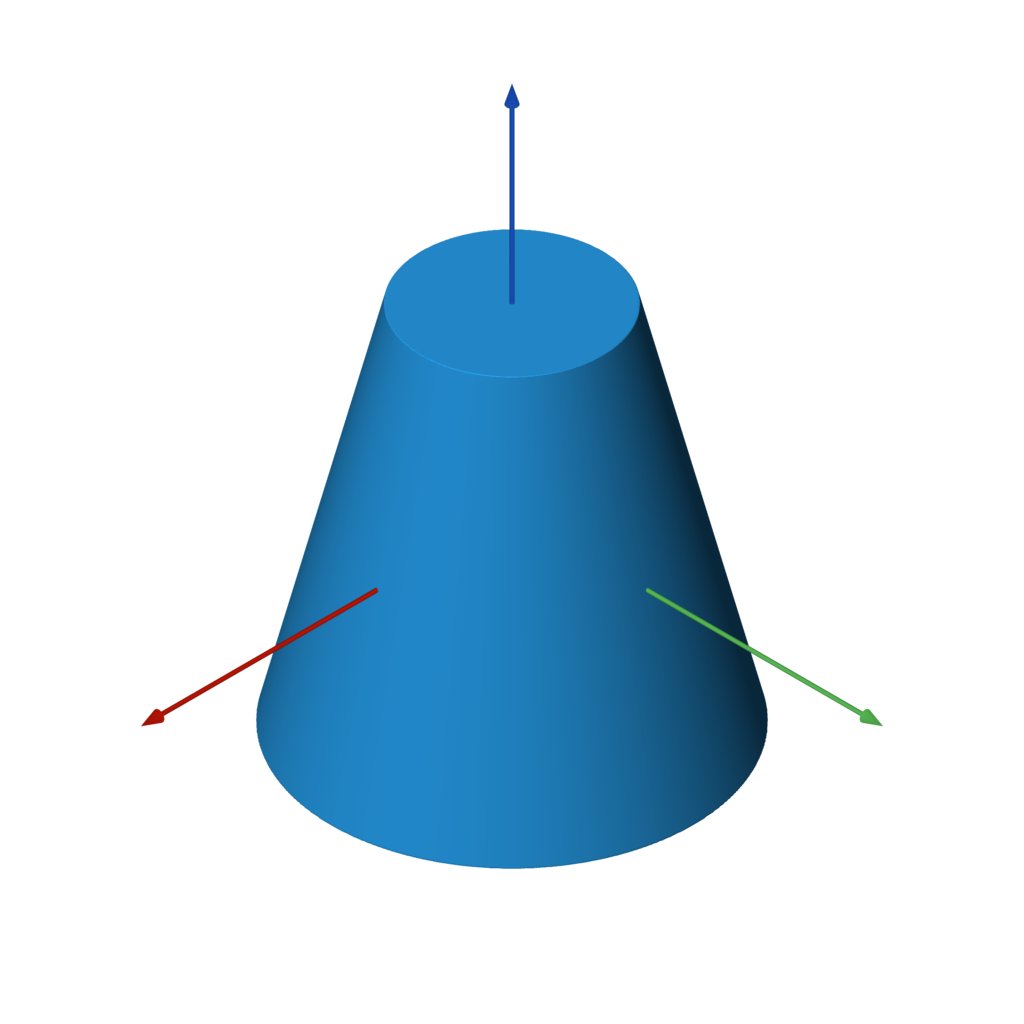
capped_cone(a, b, ra, rb)
f = capped_cone(-Z, Z, 1, 0.5)
rounded_cone
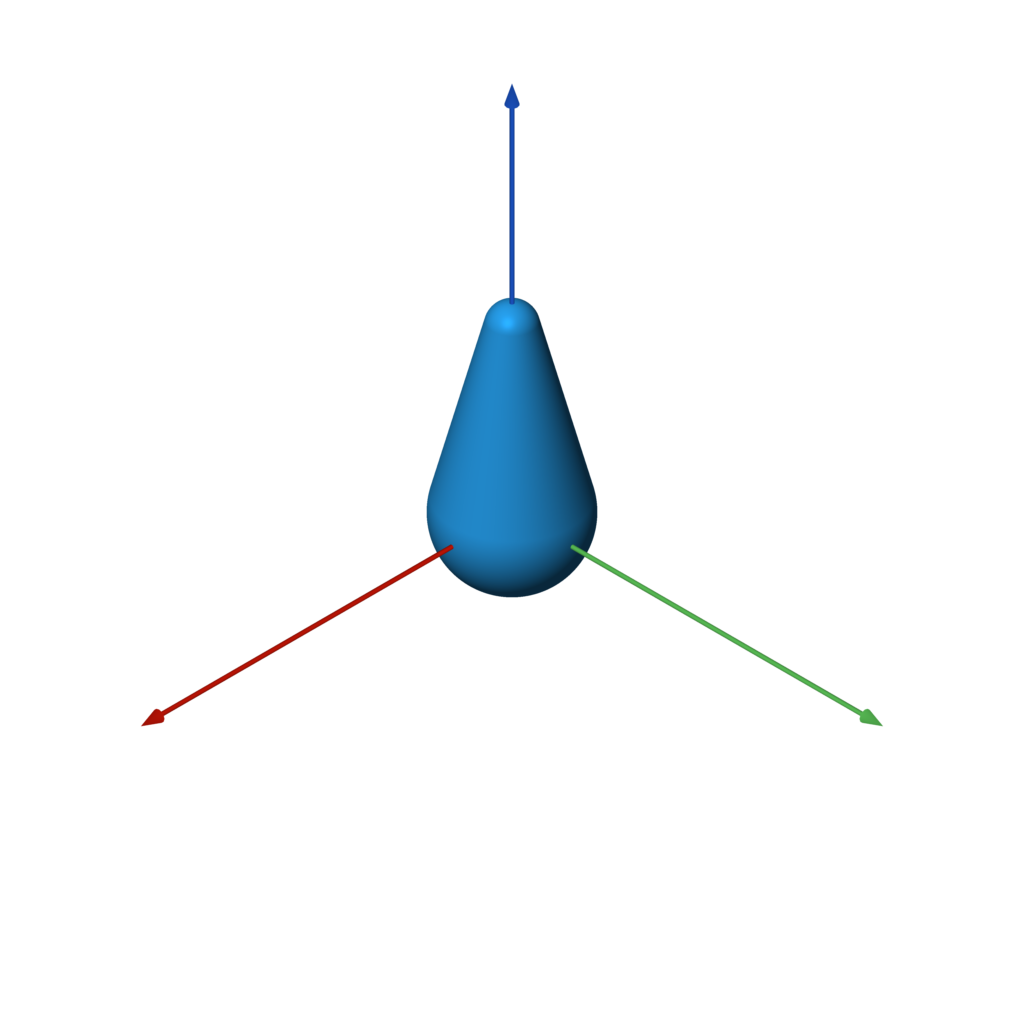
rounded_cone(r1, r2, h)
f = rounded_cone(0.75, 0.25, 2)
ellipsoid
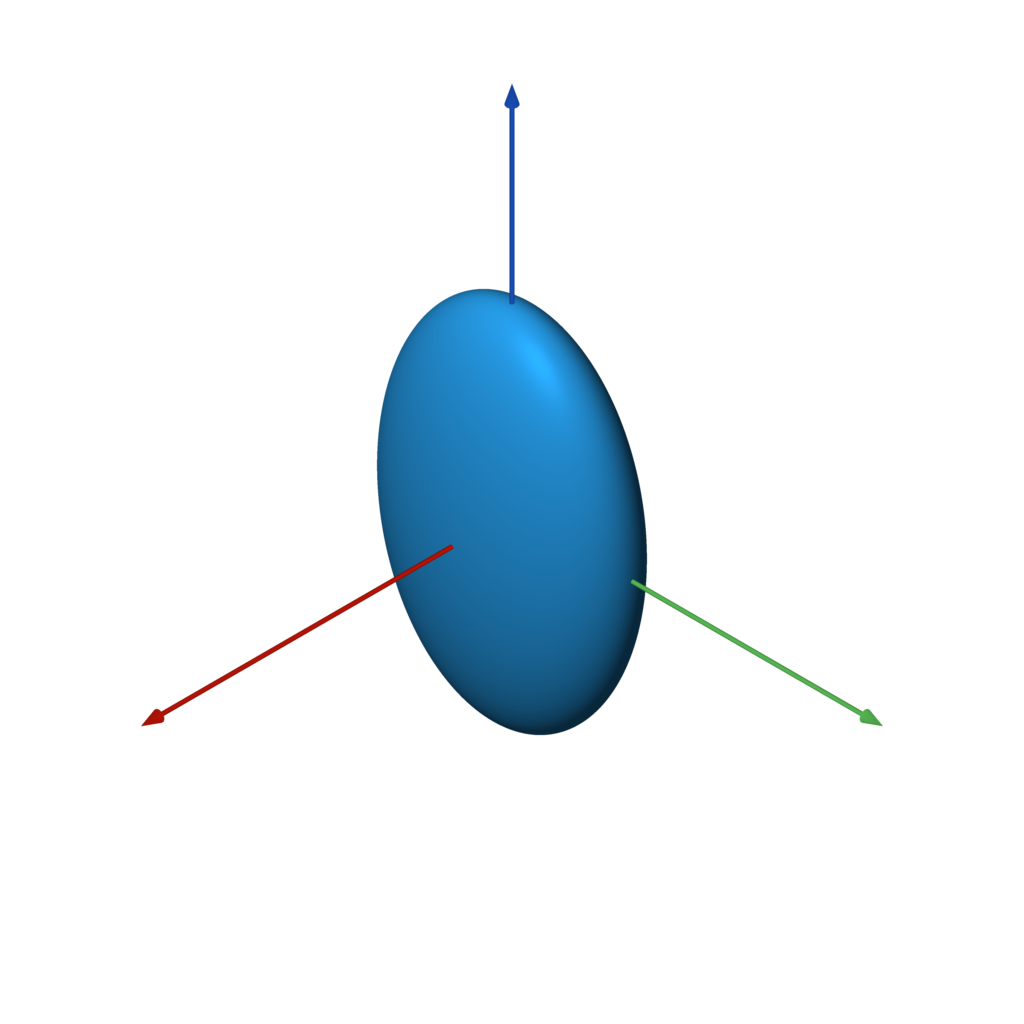
ellipsoid(size)
f = ellipsoid((1, 2, 3))
pyramid
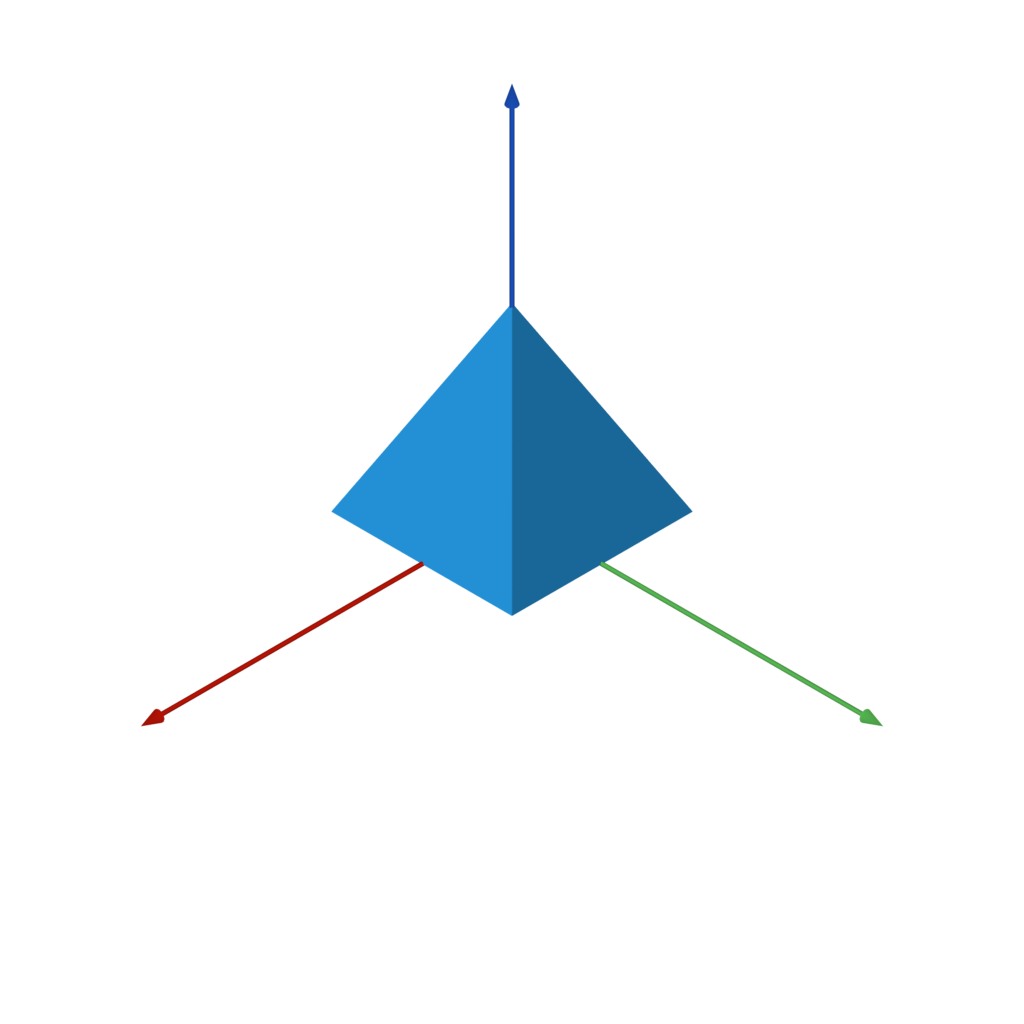
pyramid(h)
f = pyramid(1)
Platonic Solids
tetrahedron
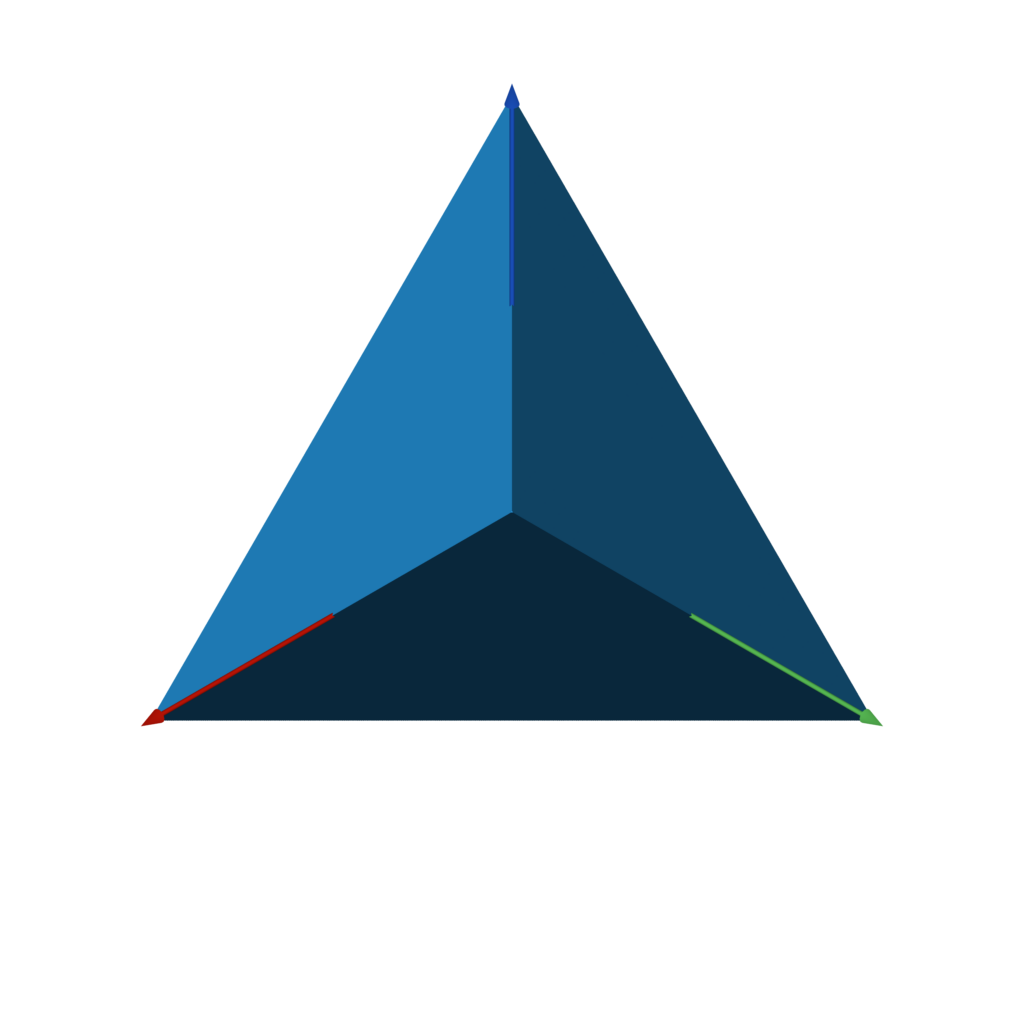
tetrahedron(r)
f = tetrahedron(1)
octahedron
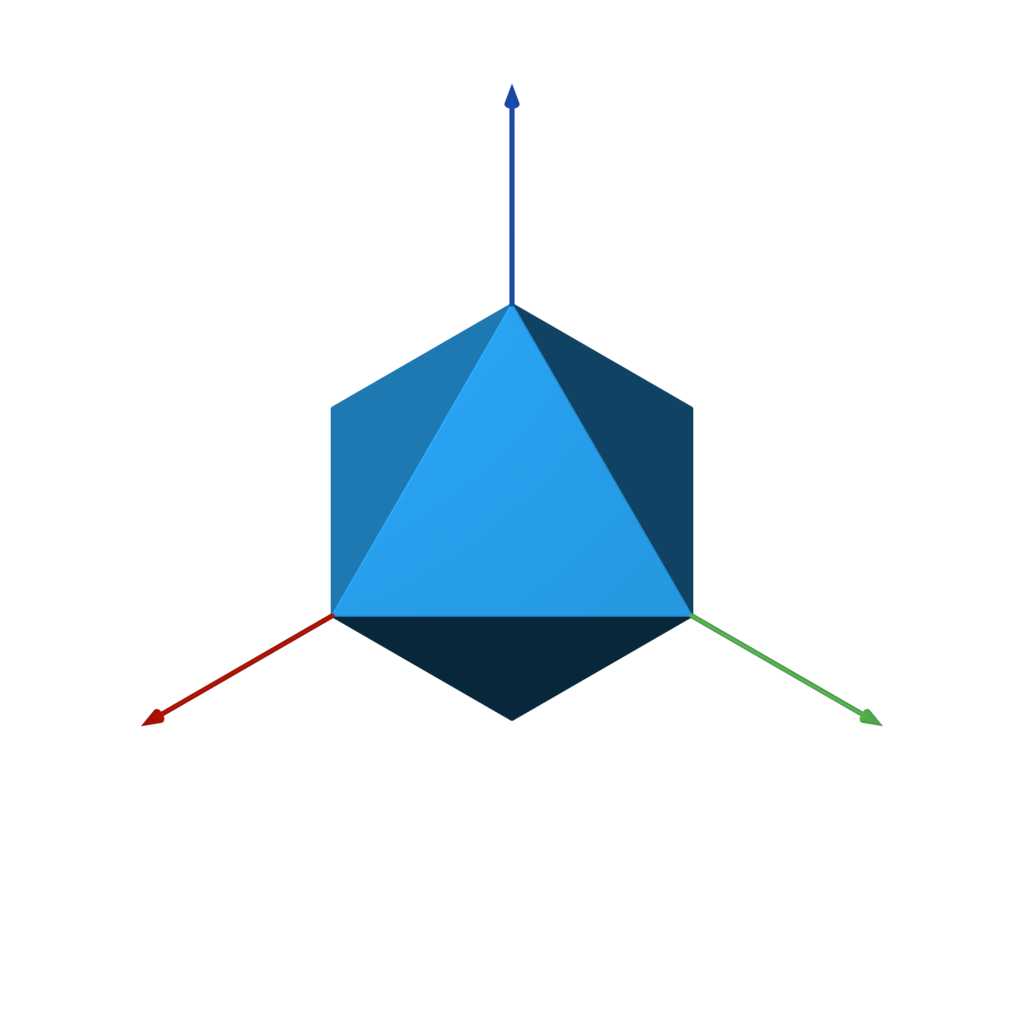
octahedron(r)
f = octahedron(1)
dodecahedron
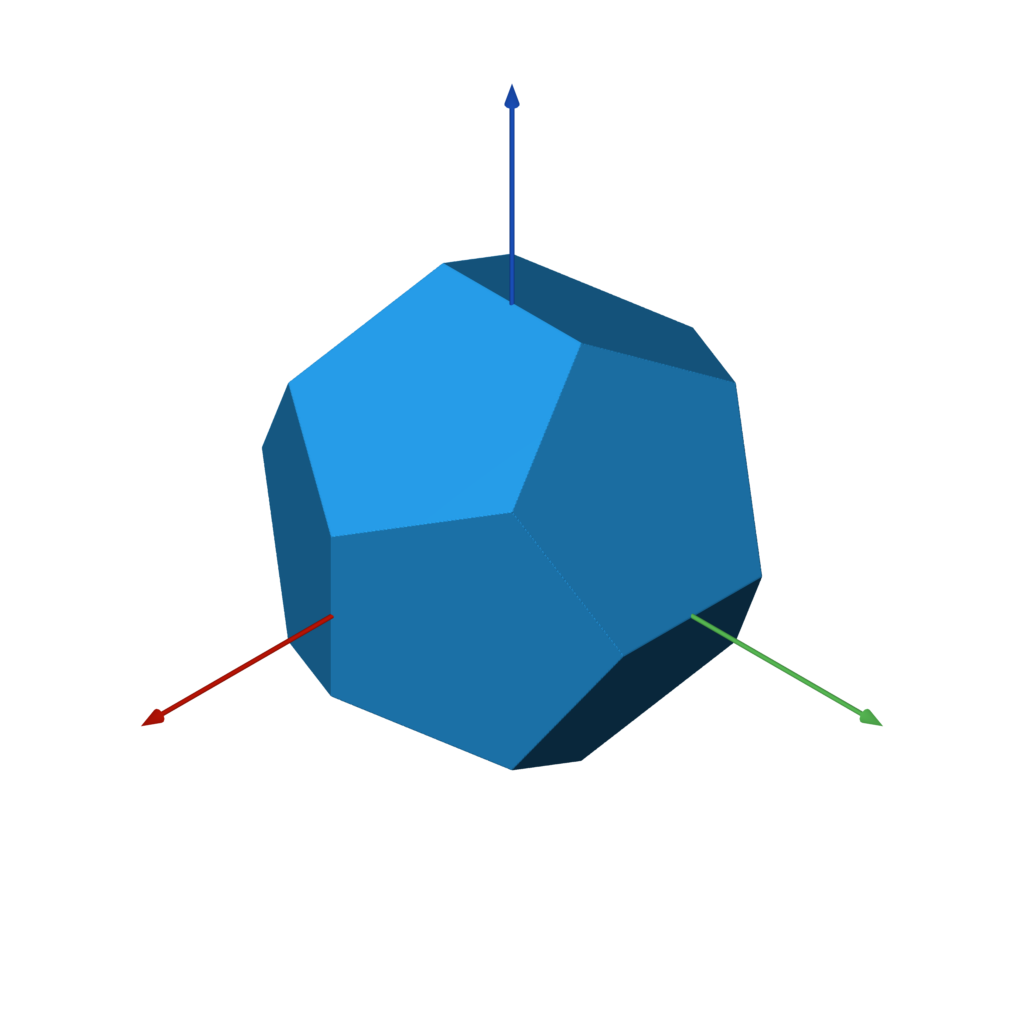
dodecahedron(r)
f = dodecahedron(1)
icosahedron
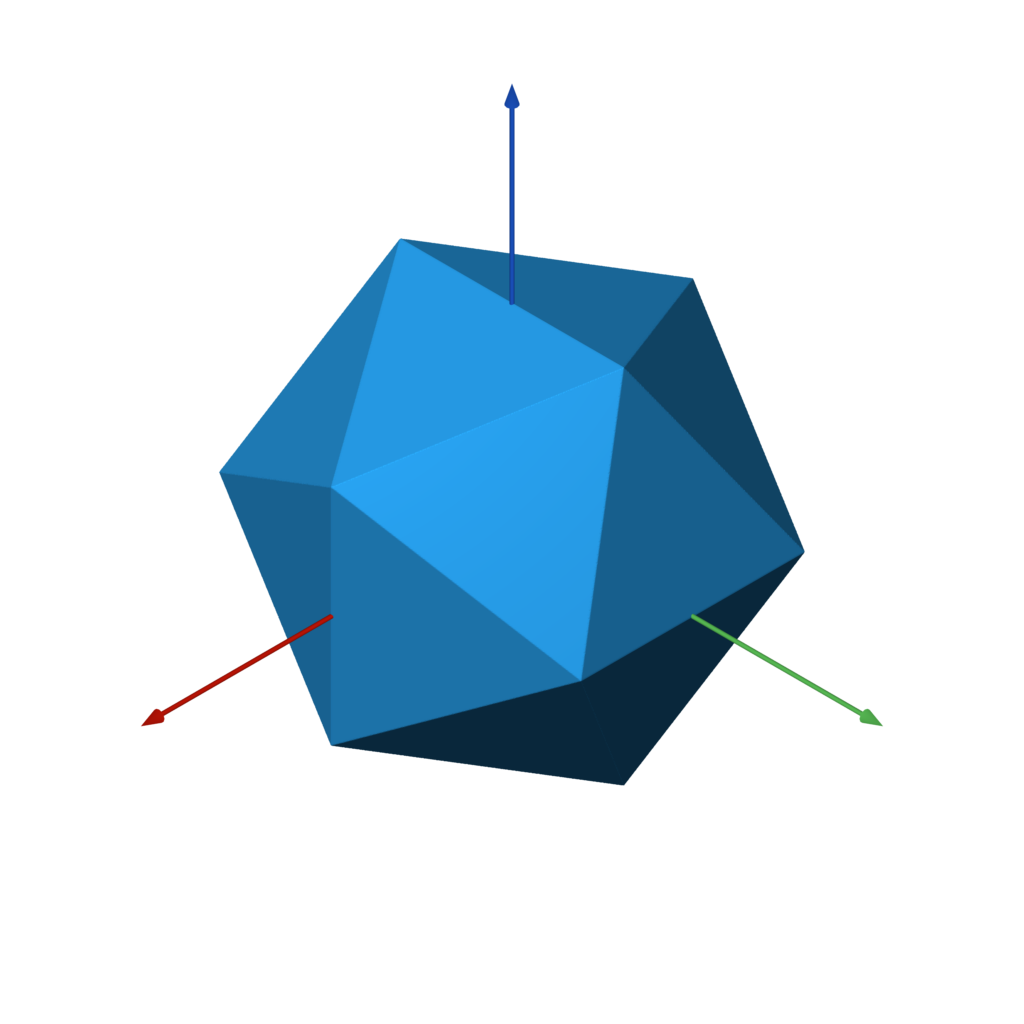
icosahedron(r)
f = icosahedron(1)
Infinite 3D Primitives
The following SDFs extend to infinity in some or all axes. They can only effectively be used in combination with other shapes, as shown in the examples below.
plane
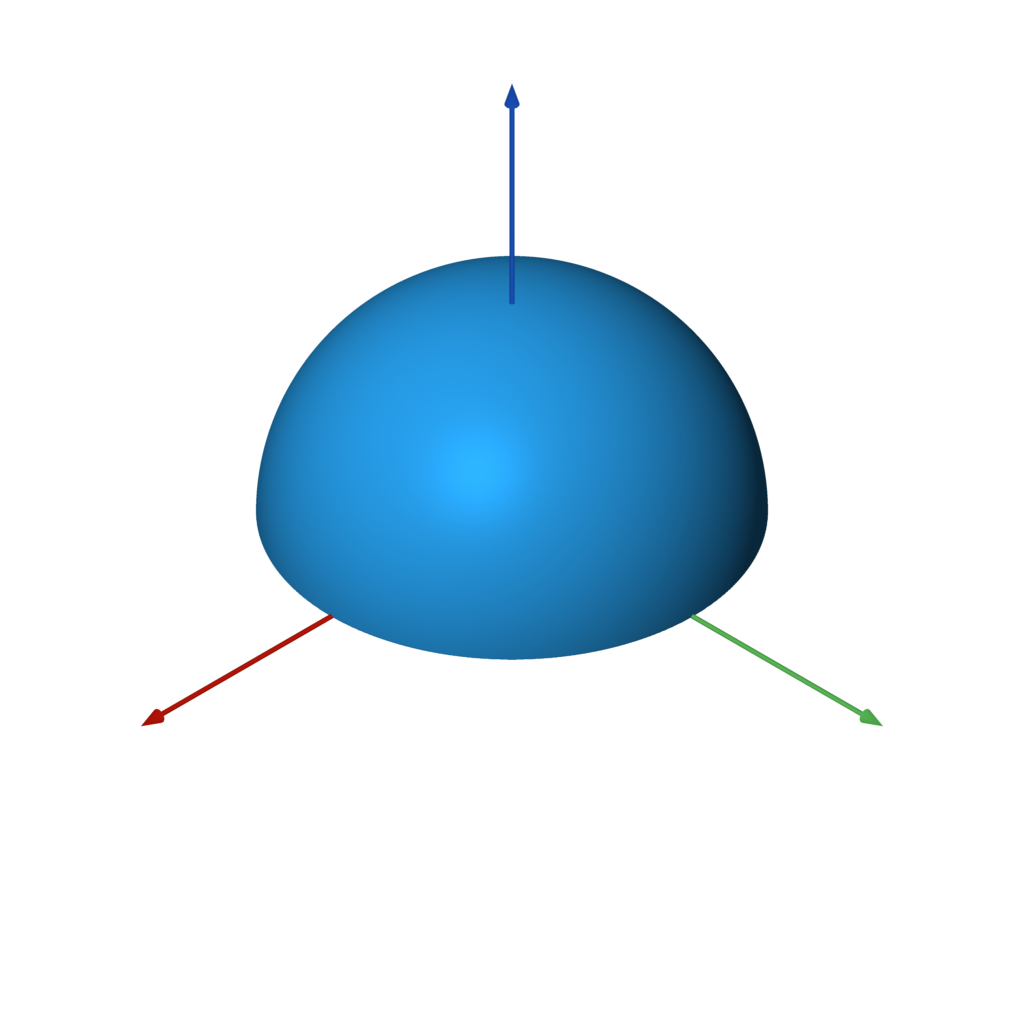
plane(normal=UP, point=ORIGIN)
plane is an infinite plane, with one side being positive (outside) and one side being negative (inside).
f = sphere() & plane()
slab
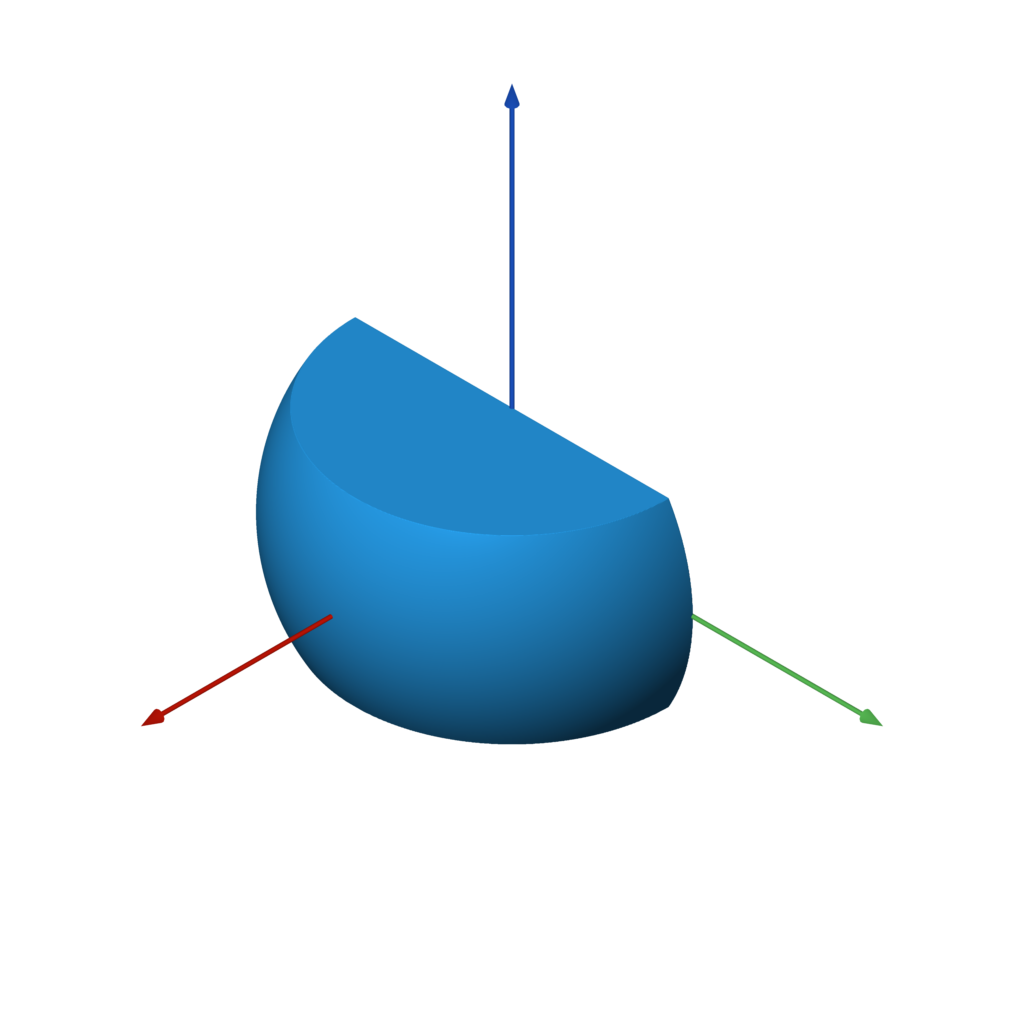
slab(x0=None, y0=None, z0=None, x1=None, y1=None, z1=None, r=None)
slab(dx=None, dy=None, dz=None) # symmetric version
slab is useful for cutting a shape on one or more axis-aligned planes.
f = sphere() & slab(dz=1, x0=0)
cylinder
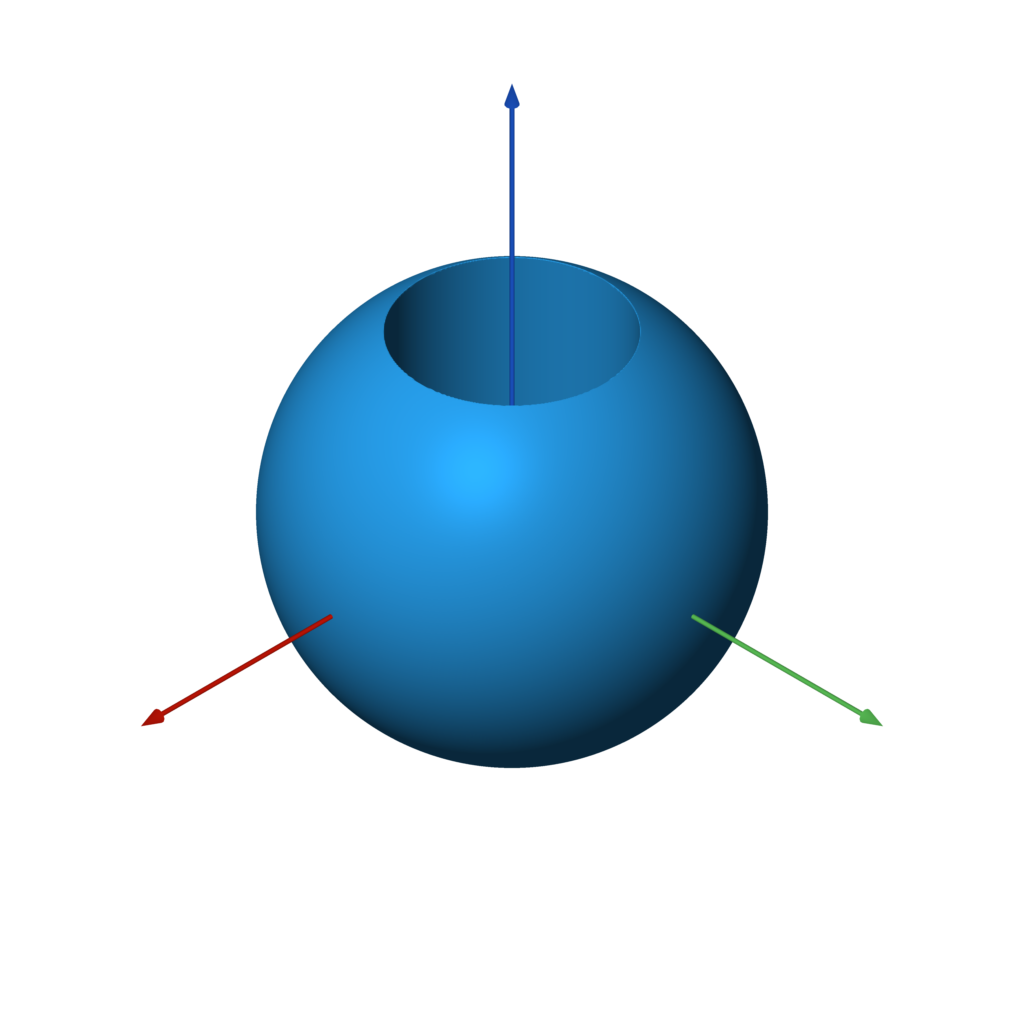
cylinder(radius)
cylinder is an infinite cylinder along the Z axis.
f = sphere() - cylinder(0.5)
Text
Yes, even text is supported!
text(font_name, text, width=None, height=None, pixels=PIXELS, points=512)
FONT = 'Arial'
TEXT = 'Hello, world!'
w, h = measure_text(FONT, TEXT)
f = rounded_box((w + 1, h + 1, 0.2), 0.1)
f -= text(FONT, TEXT).extrude(1)
Note: PIL.ImageFont,
which is used to load fonts, does not search for the font by name on all operating systems.
For example, on Ubuntu the full path to the font has to be provided.
(e.g. /usr/share/fonts/truetype/freefont/FreeMono.ttf)
Images
Image masks can be extruded and incorporated into your 3D model.
image(path_or_array, width=None, height=None, pixels=PIXELS)
IMAGE = 'examples/butterfly.png'
w, h = measure_image(IMAGE)
f = rounded_box((w * 1.1, h * 1.1, 0.1), 0.05)
f |= image(IMAGE).extrude(1) & slab(z0=0, z1=0.075)
Positioning
translate
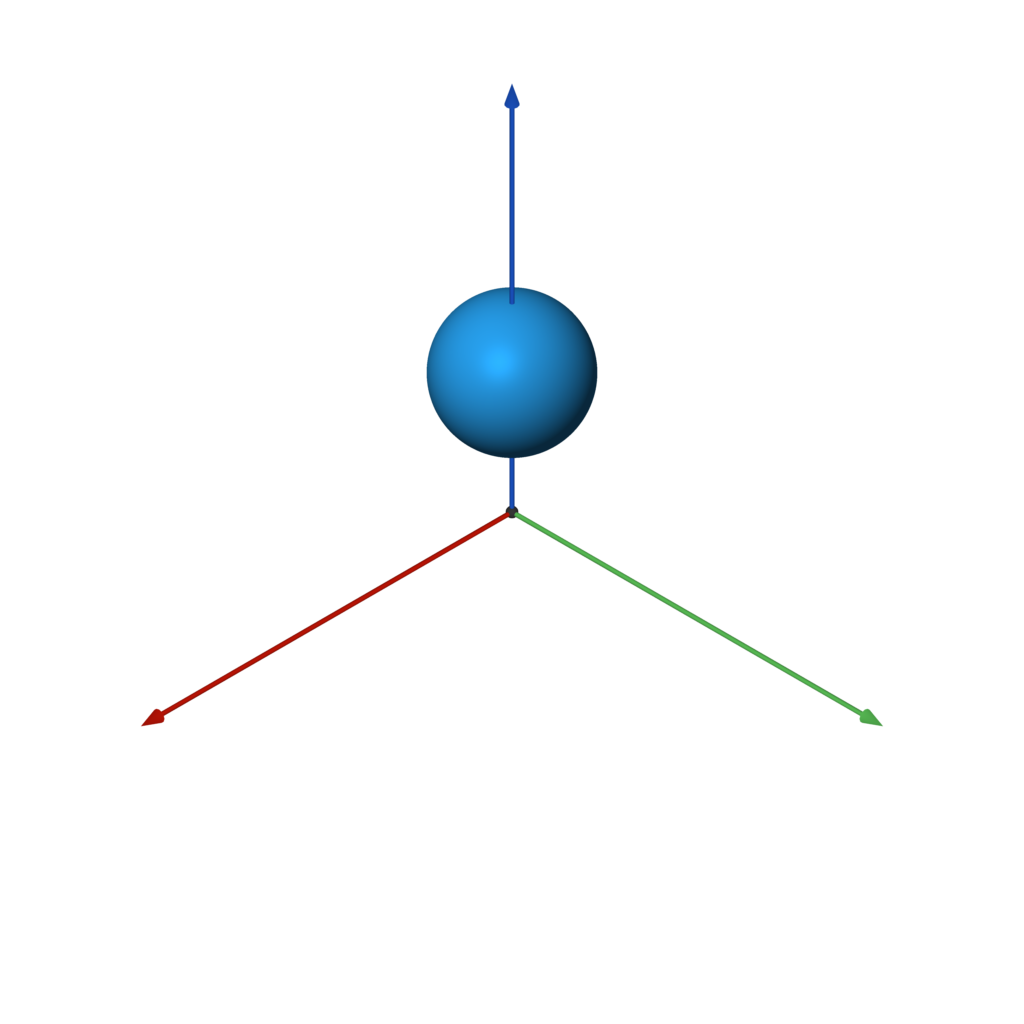
translate(other, offset)
f = sphere().translate((0, 0, 2))
scale
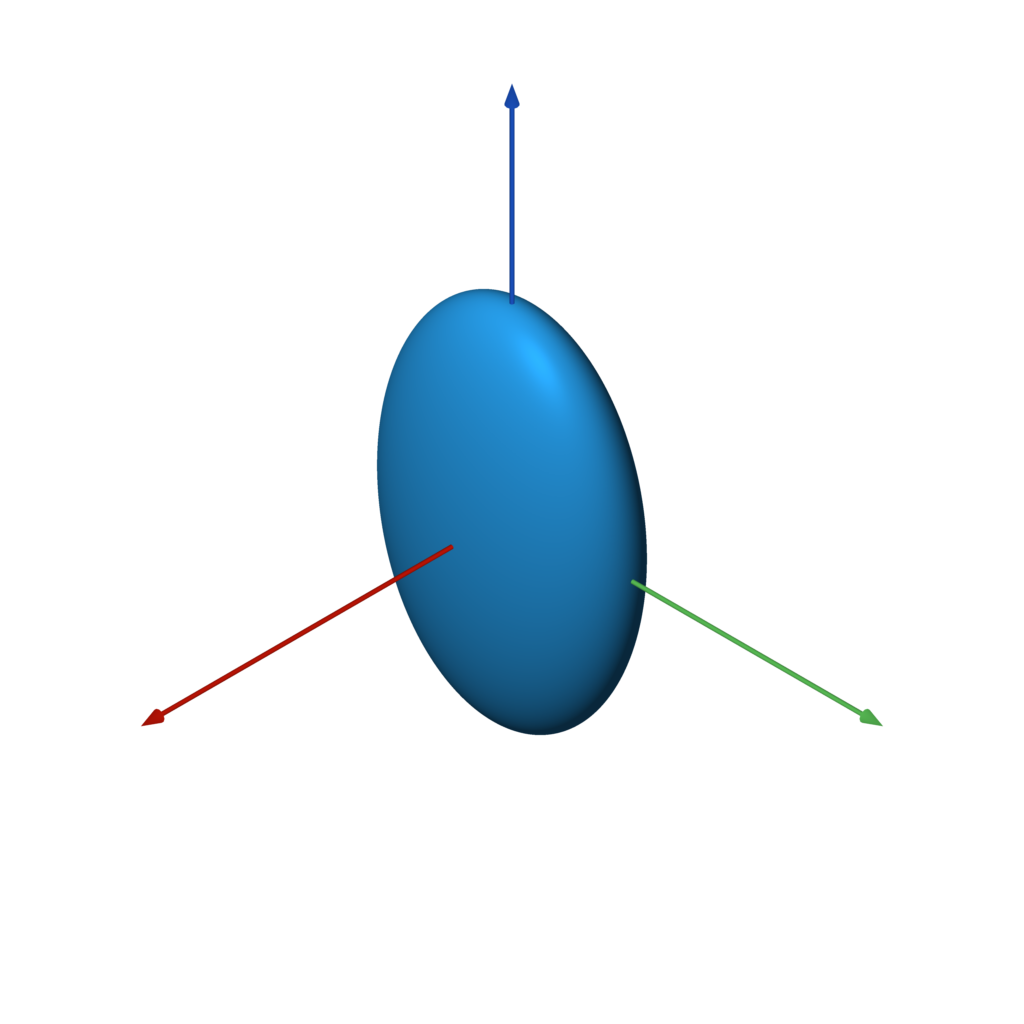
scale(other, factor)
Note that non-uniform scaling is an inexact SDF.
f = sphere().scale(2)
f = sphere().scale((1, 2, 3)) # non-uniform scaling
rotate
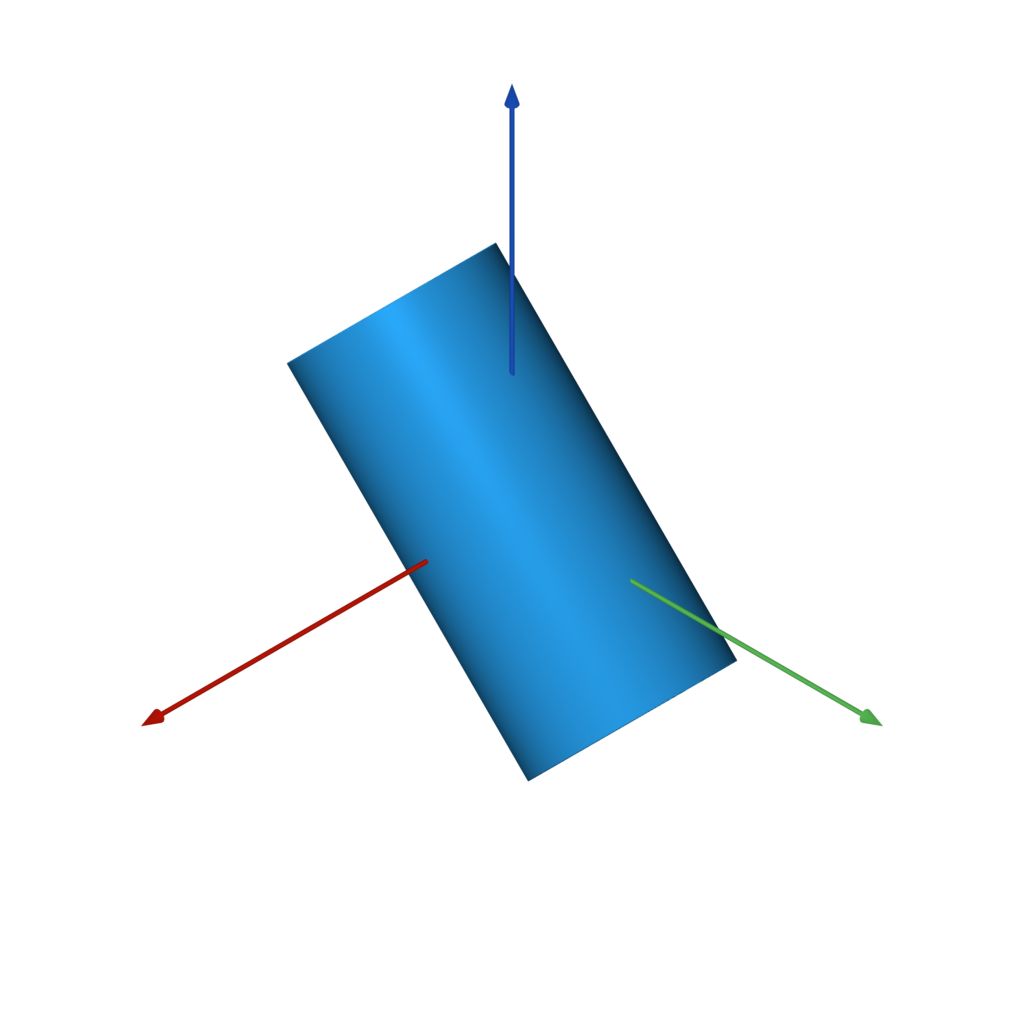
rotate(other, angle, vector=Z)
f = capped_cylinder(-Z, Z, 0.5).rotate(pi / 4, X)
orient
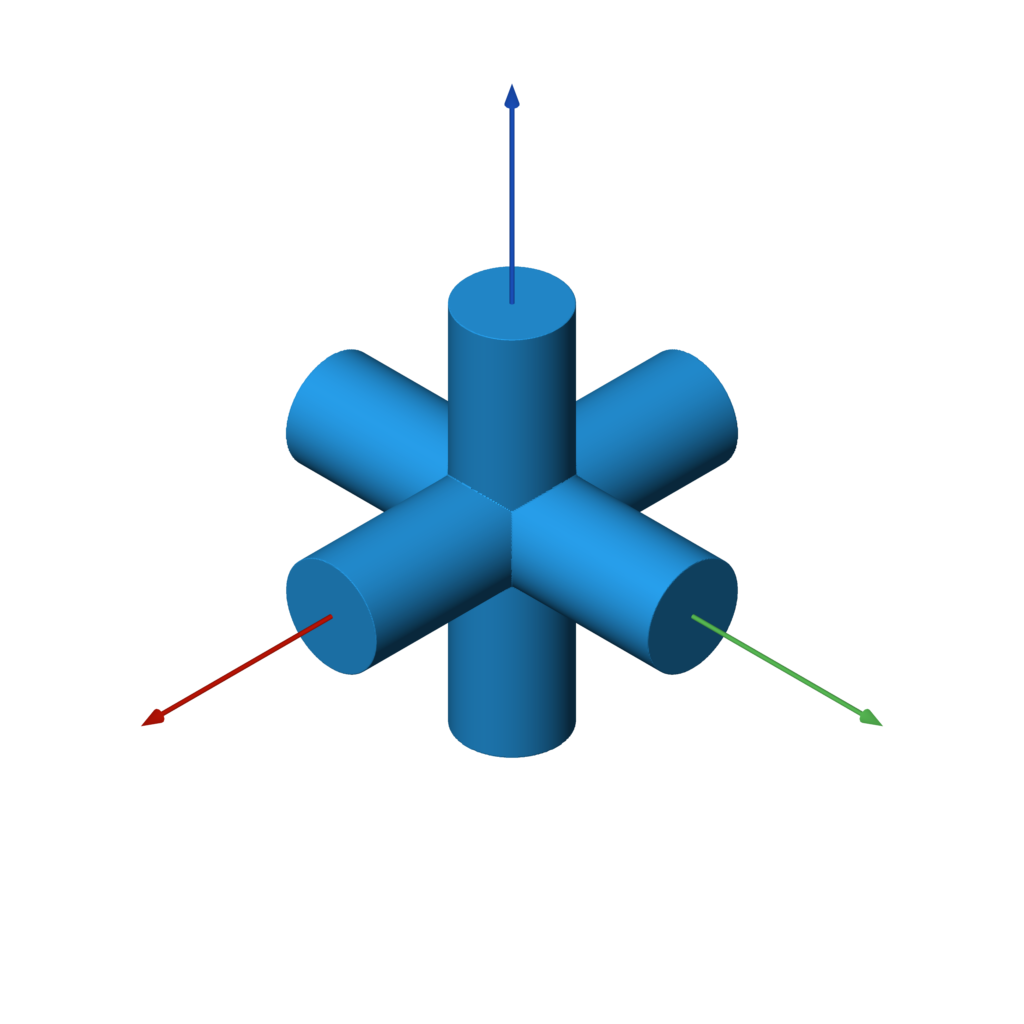
orient(other, axis)
orient rotates the shape such that whatever was pointing in the +Z direction
is now pointing in the specified direction.
c = capped_cylinder(-Z, Z, 0.25)
f = c.orient(X) | c.orient(Y) | c.orient(Z)
Boolean Operations
The following primitives a and b are used in all of the following
boolean operations.
a = box((3, 3, 0.5))
b = sphere()
The named versions (union, difference, intersection) can all take
one or more SDFs as input. They all take an optional radius (r) and
chamfer (c) parameter to define the amount of filleting/chamfering to apply. When
using operators (|, -, &) the smoothing can still be applied via the
.fillet(1) and .chamfer(3) functions.
union
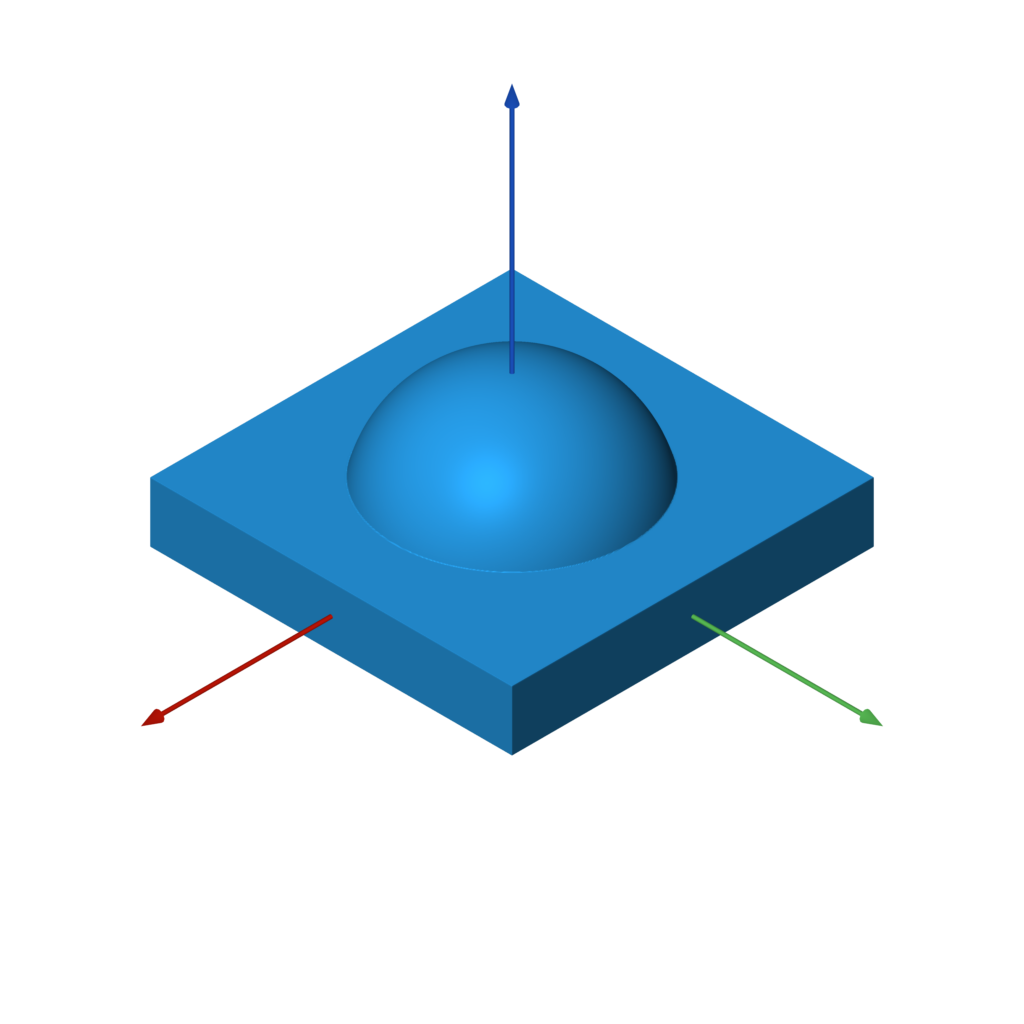
f = a | b
f = union(a, b) # equivalent
difference
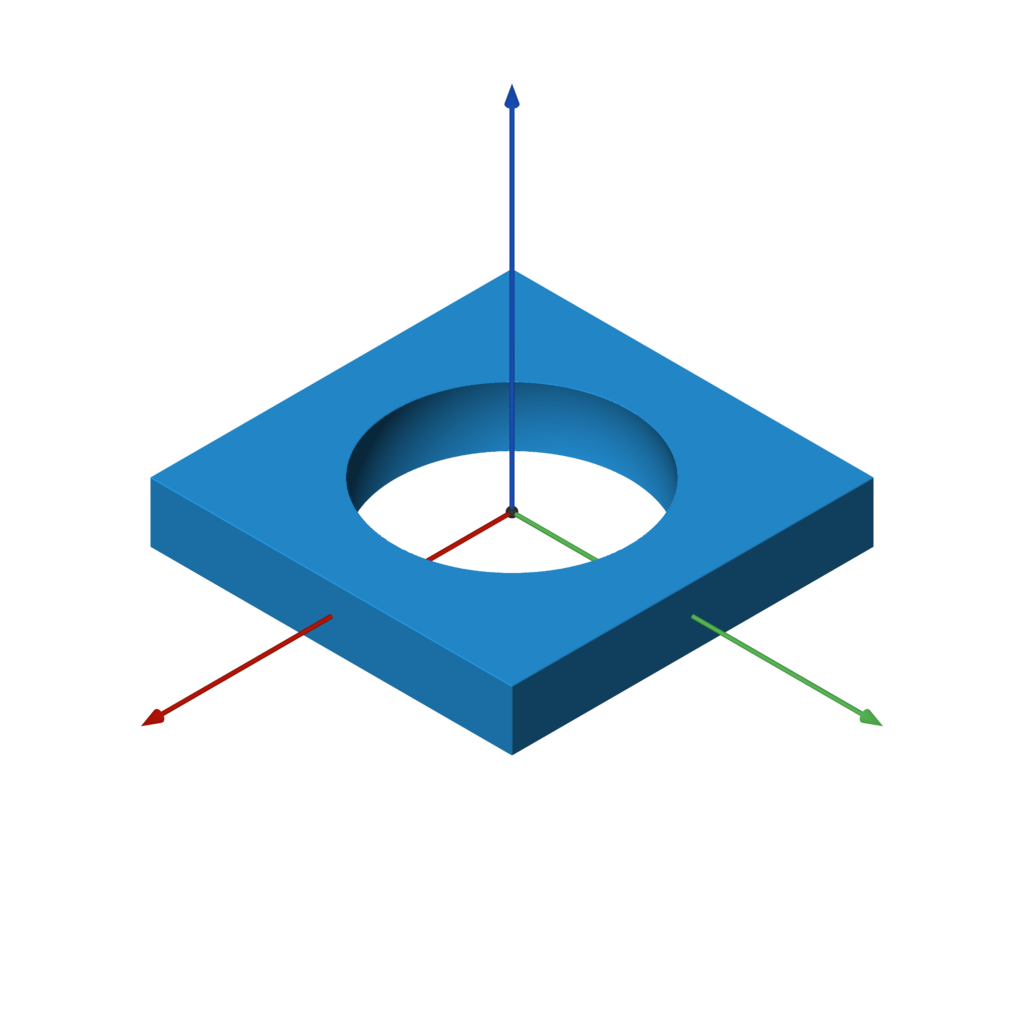
f = a - b
f = difference(a, b) # equivalent
intersection
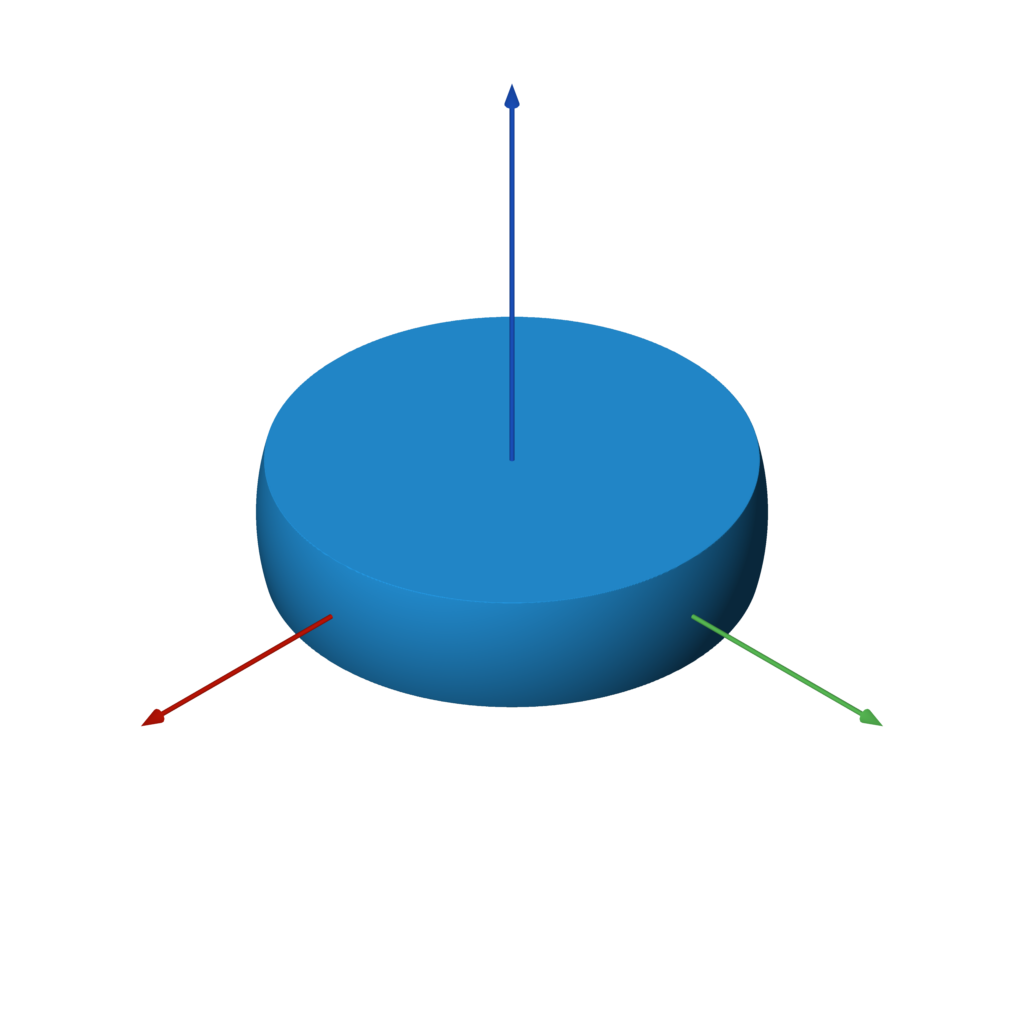
f = a & b
f = intersection(a, b) # equivalent
smooth_union
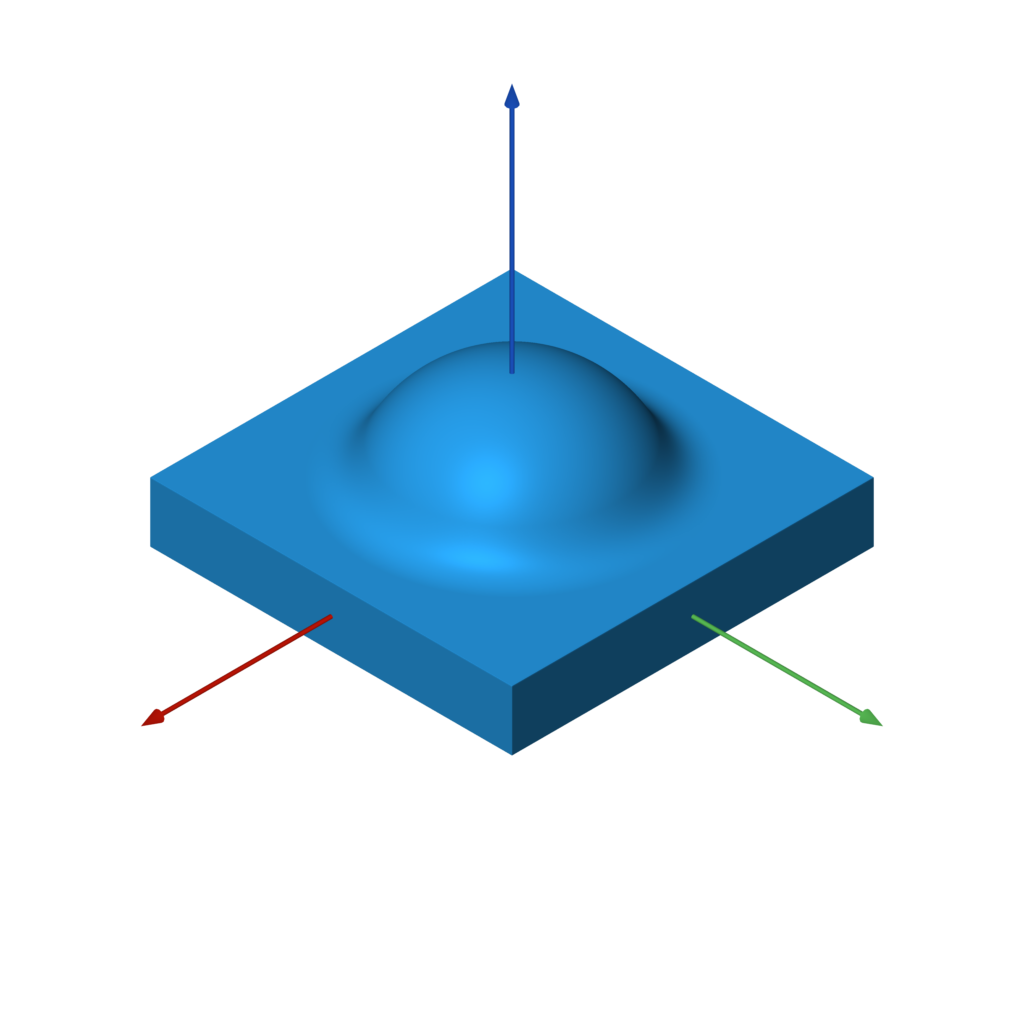
f = a | b.r(0.25)
f = union(a, b, r=0.25) # equivalent
smooth_difference
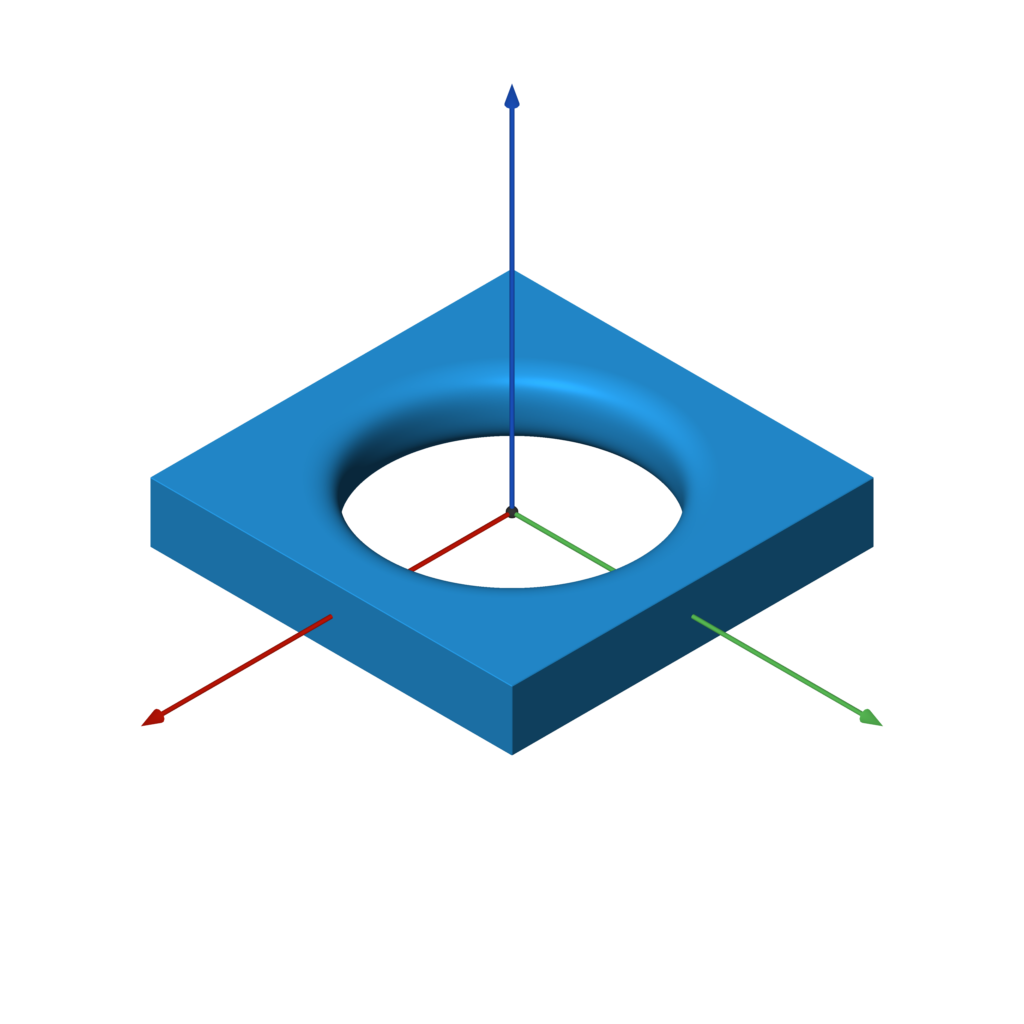
f = a - b.r(0.25)
f = difference(a, b, r=0.25) # equivalent
smooth_intersection
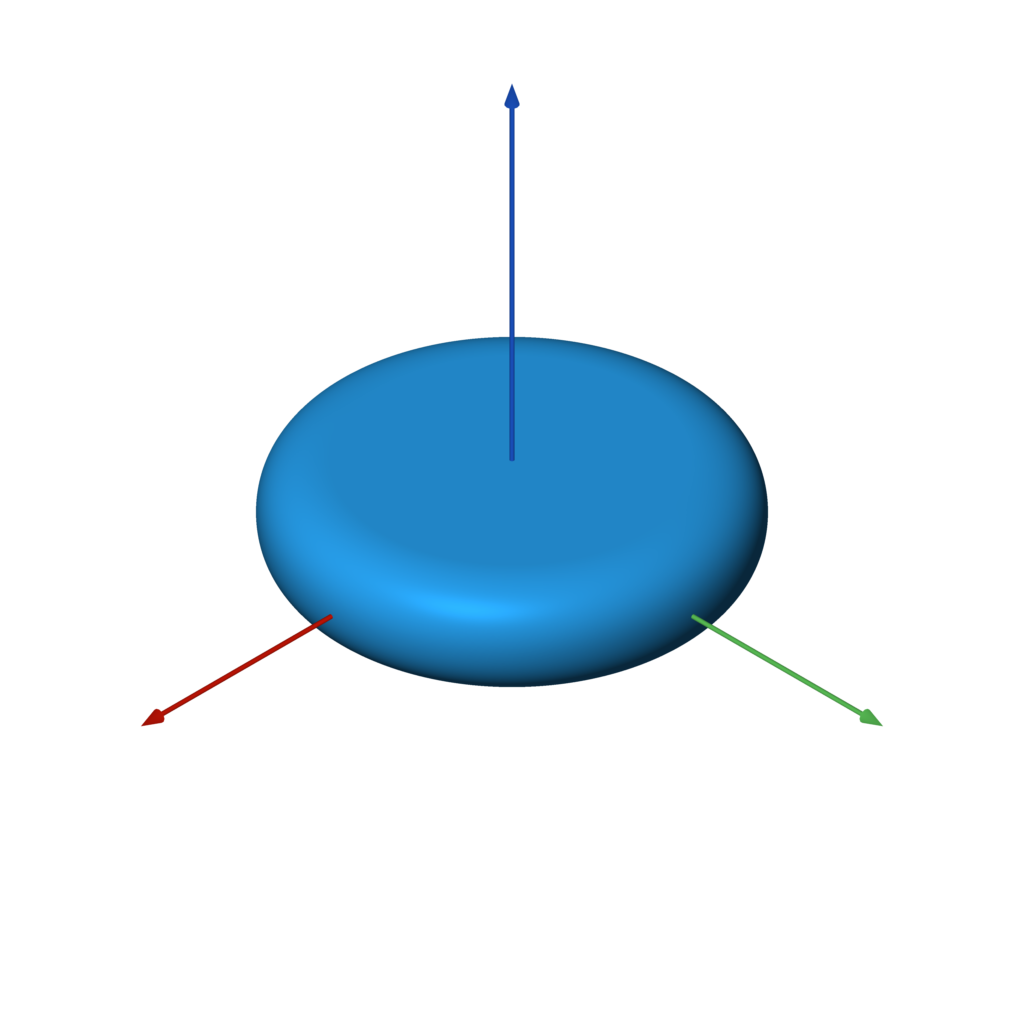
f = a & b.r(0.25)
f = intersection(a, b, r=0.25) # equivalent
Repetition
repeat
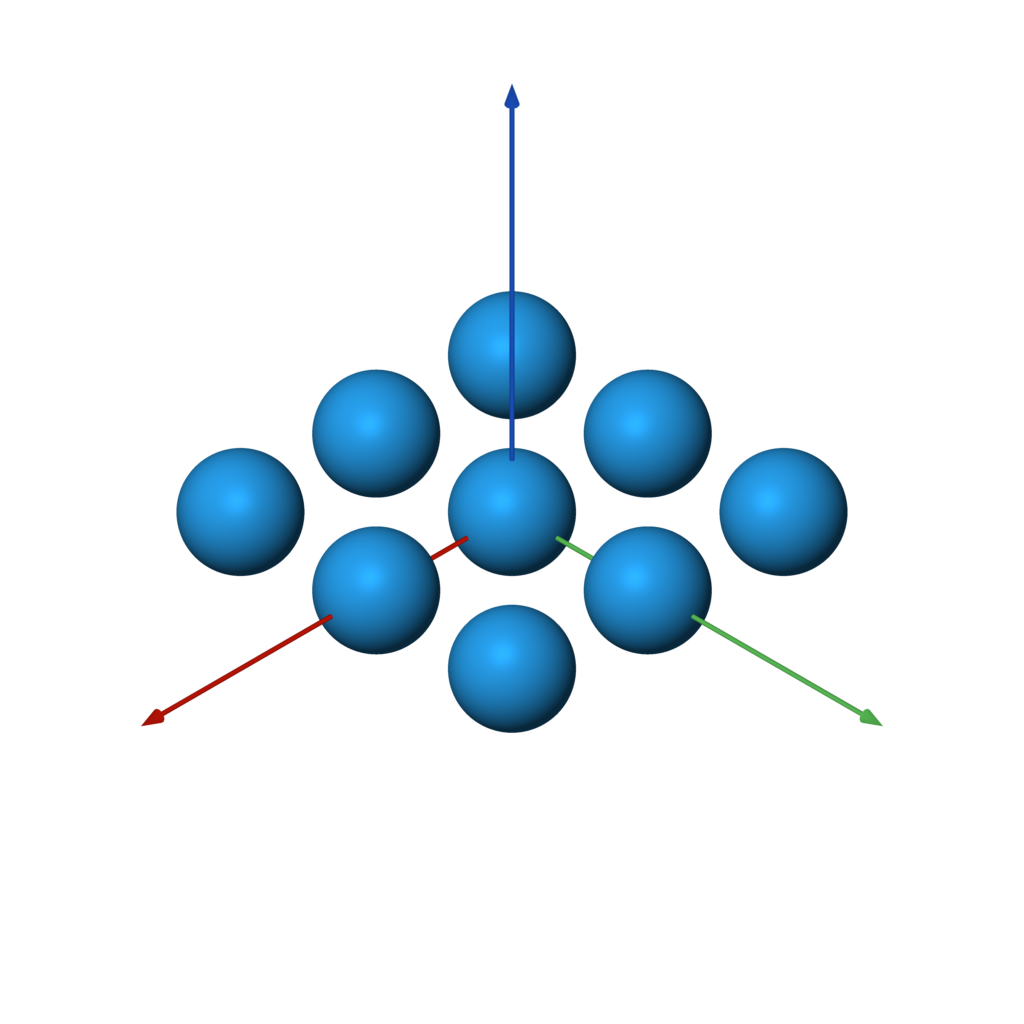
repeat(other, spacing, count=None, padding=0)
repeat can repeat the underlying SDF infinitely or a finite number of times.
If finite, the number of repetitions must be odd, because the count specifies
the number of copies to make on each side of the origin. If the repeated
elements overlap or come close together, you may need to specify a padding
greater than zero to compute a correct SDF.
f = sphere().repeat(3, (1, 1, 0))
circular_array
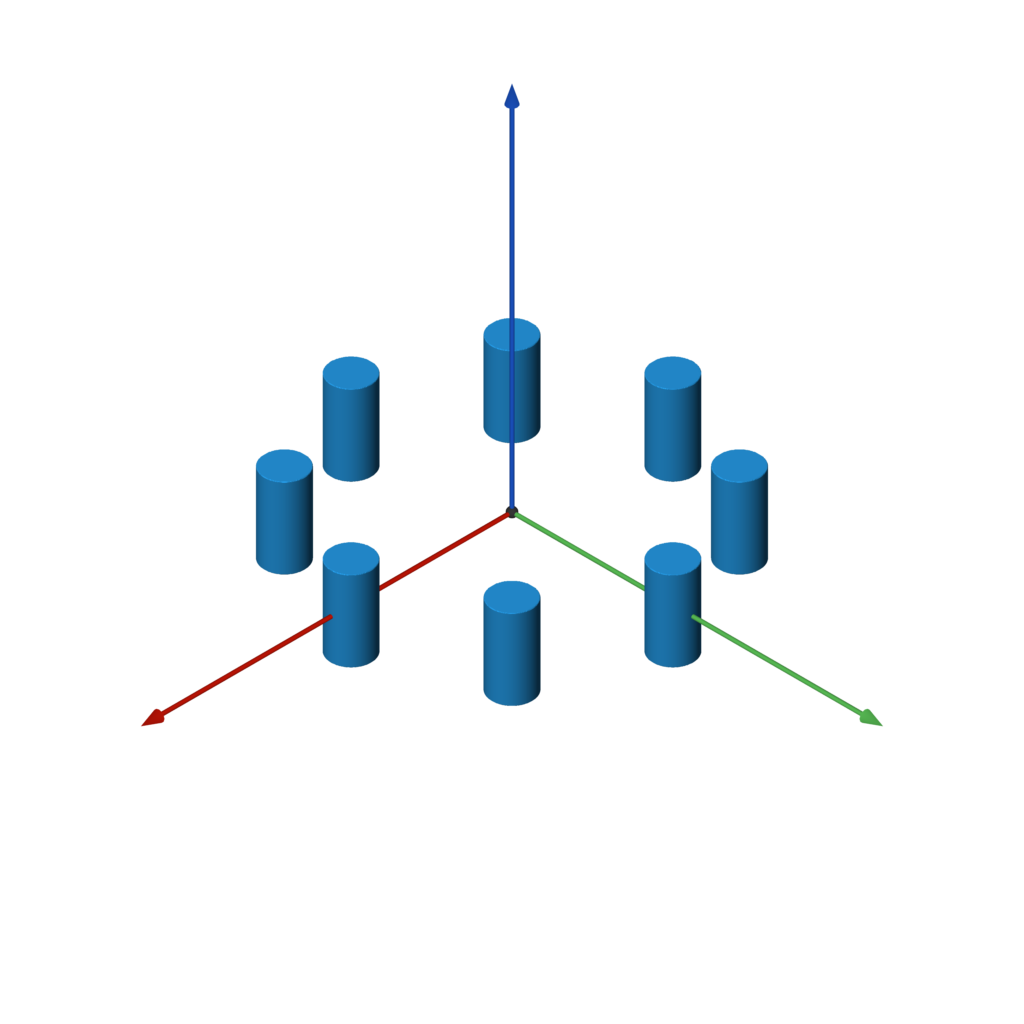
circular_array(other, count, offset)
circular_array makes count copies of the underlying SDF, arranged in a
circle around the Z axis. offset specifies how far to translate the shape
in X before arraying it. The underlying SDF is only evaluated twice (instead
of count times), so this is more performant than instantiating count copies
of a shape.
f = capped_cylinder(-Z, Z, 0.5).circular_array(8, 4)
Miscellaneous
blend
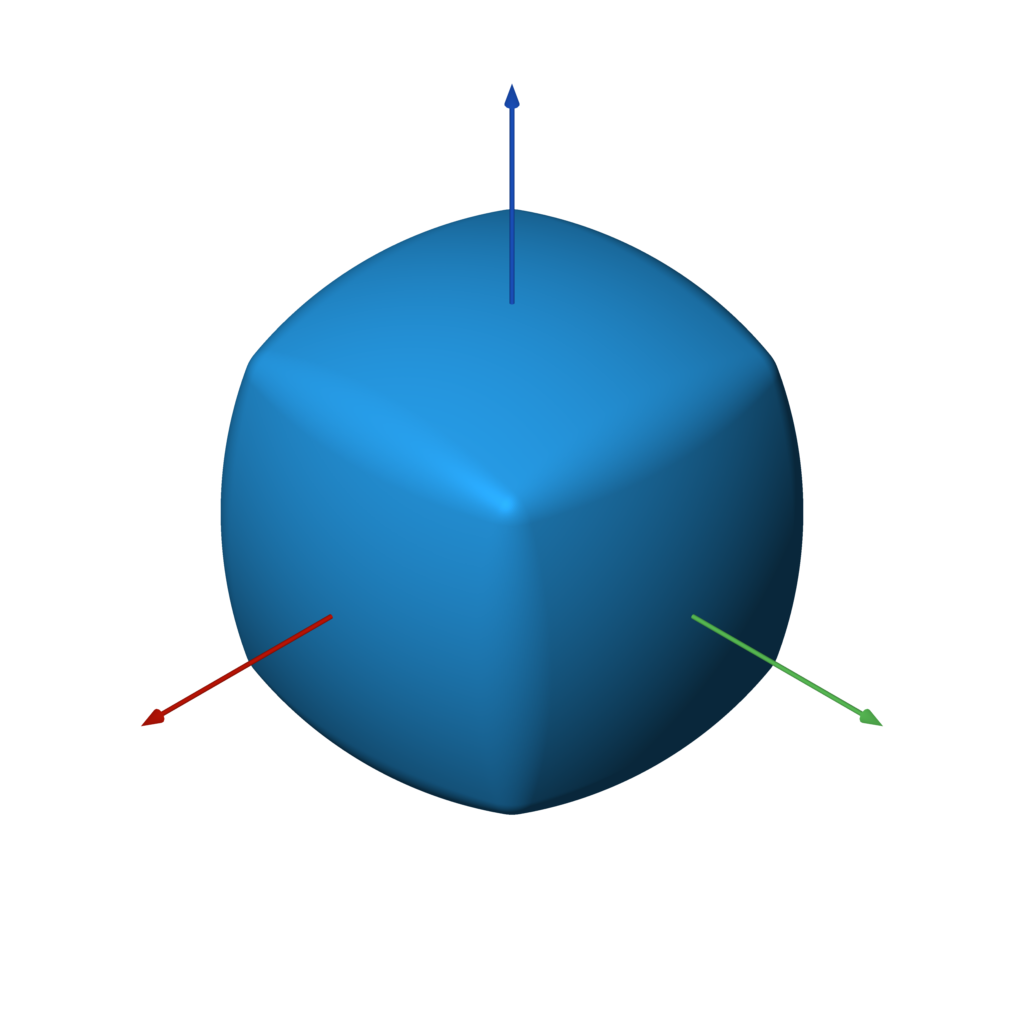
blend(a, *bs, r=0.5)
f = sphere().blend(box())
dilate
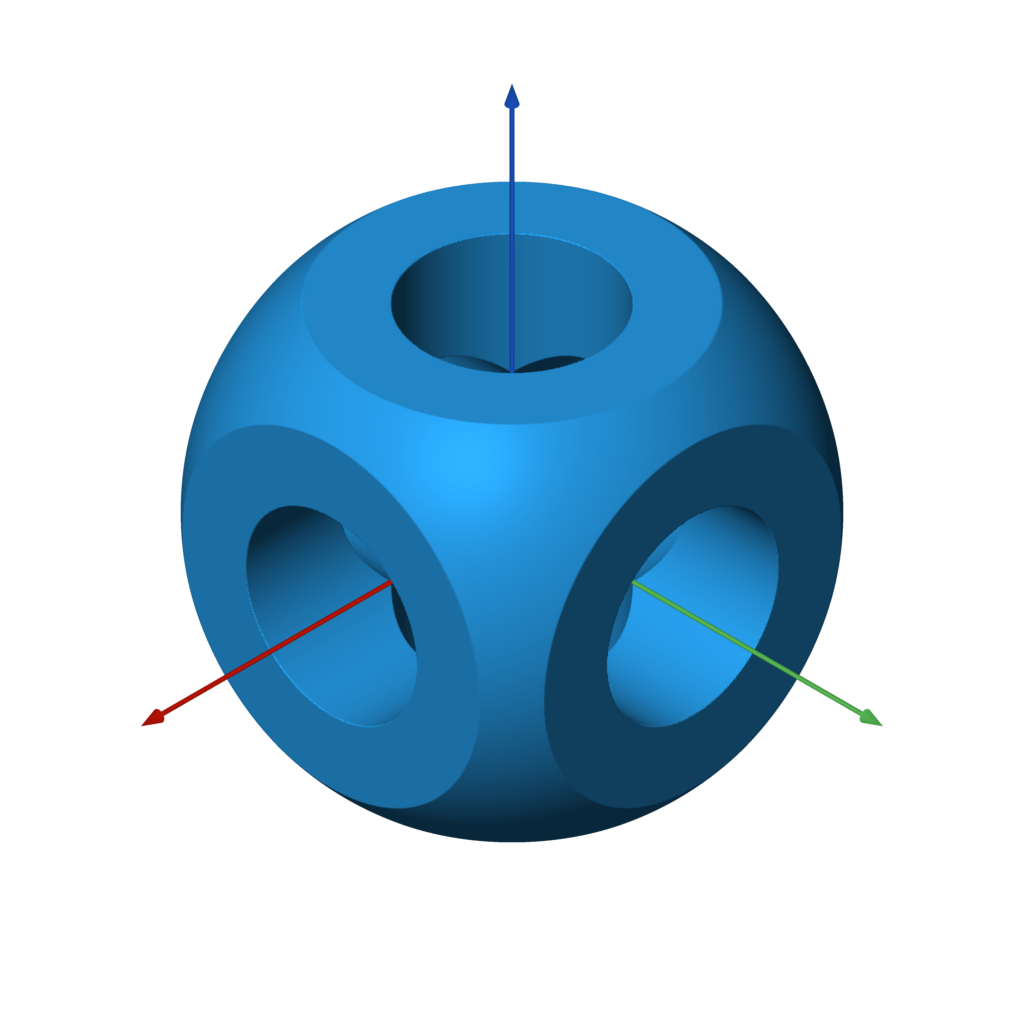
dilate(other, r)
f = example.dilate(0.1)
erode
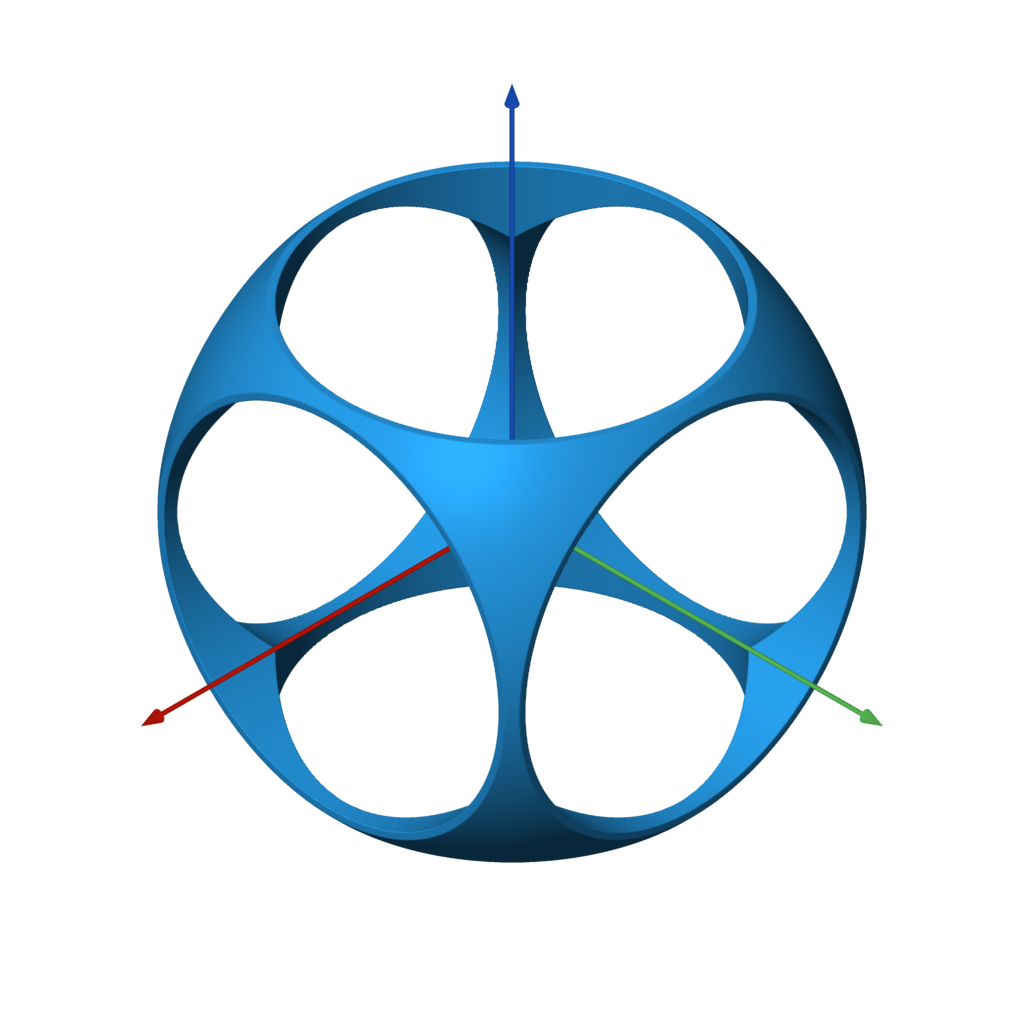
erode(other, r)
f = example.erode(0.1)
shell
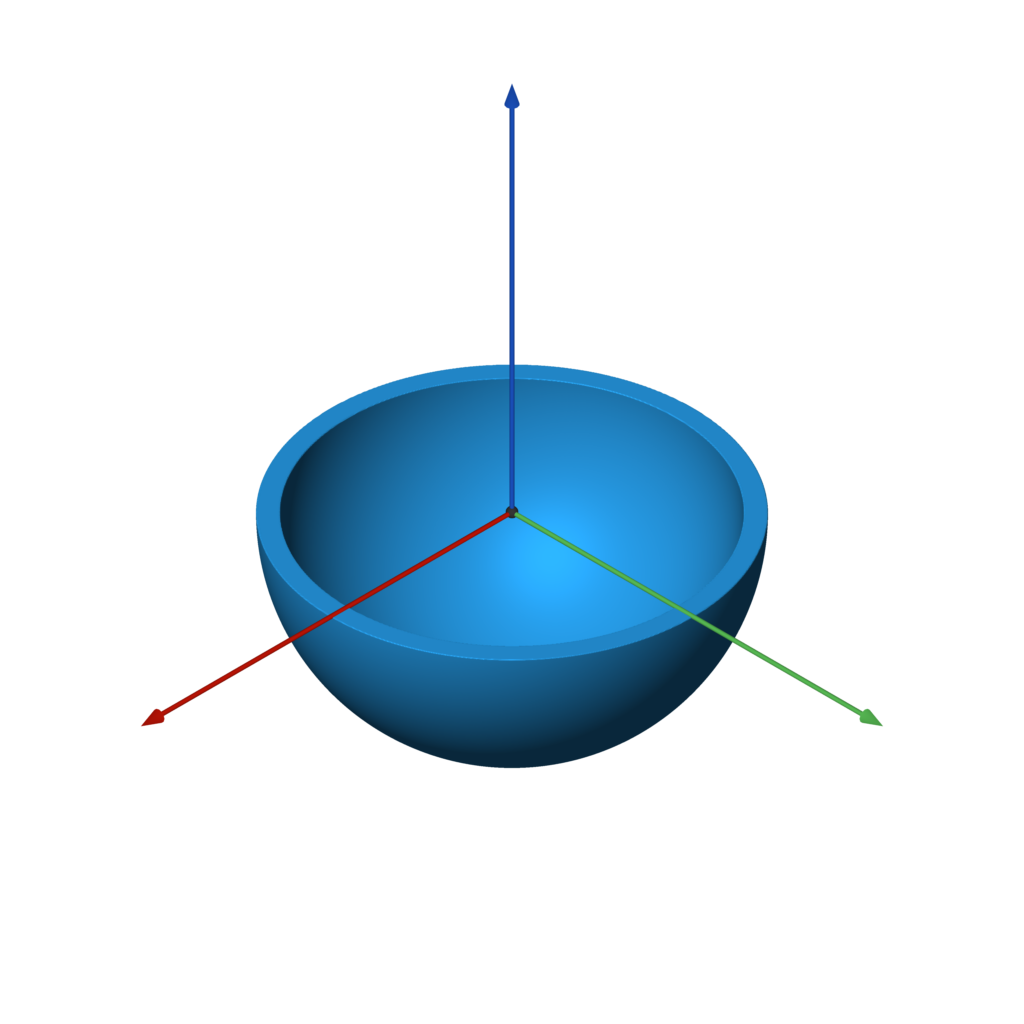
shell(other, thickness)
f = sphere().shell(0.05) & plane(-Z)
elongate
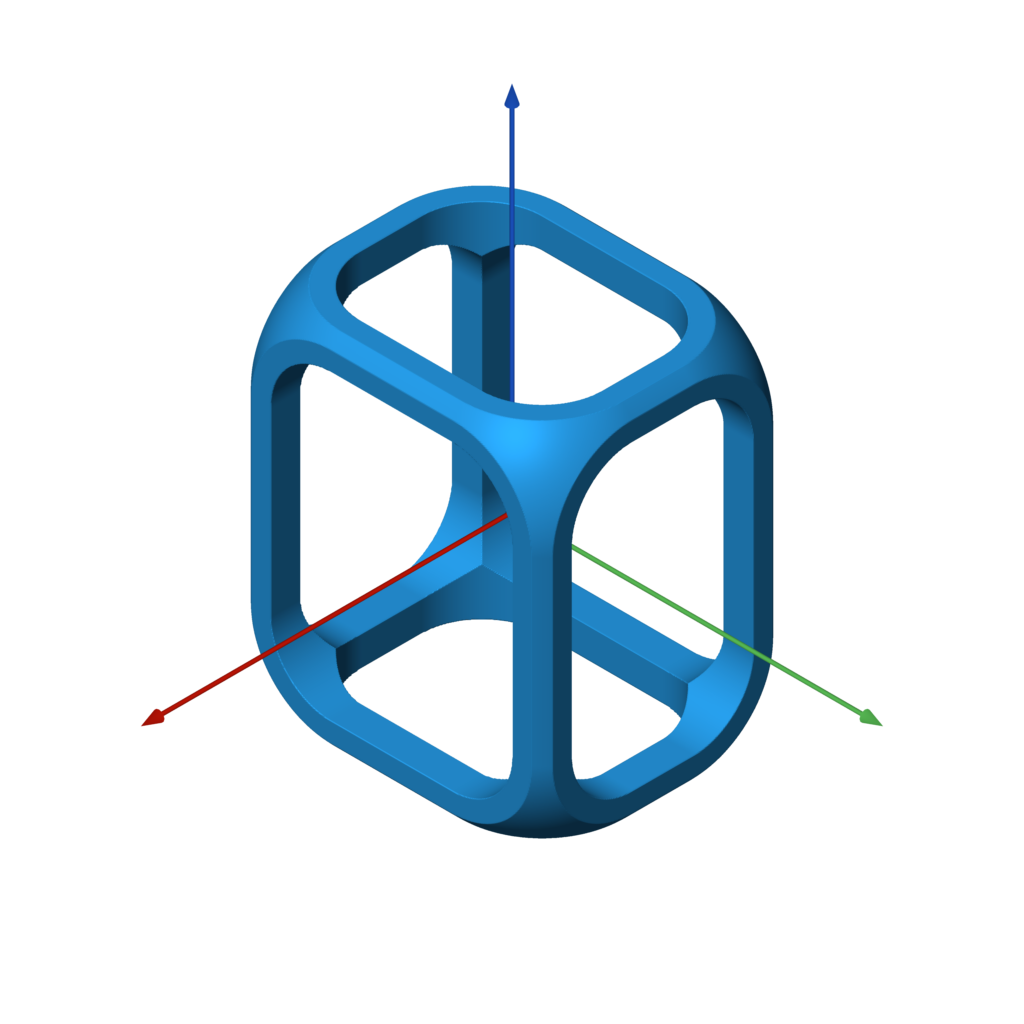
elongate(other, size)
f = example.elongate((0.25, 0.5, 0.75))
twist
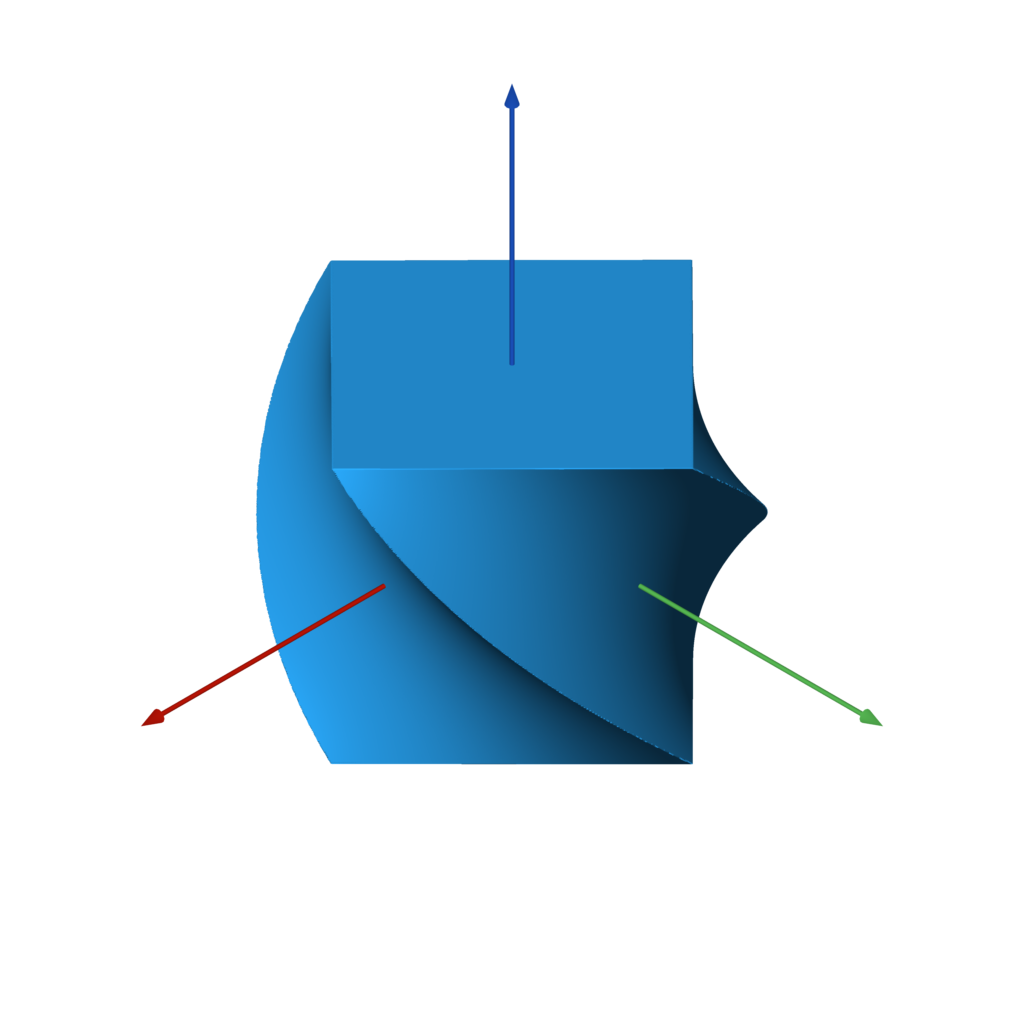
twist(other, k)
f = box().twist(pi / 2)
twist_between
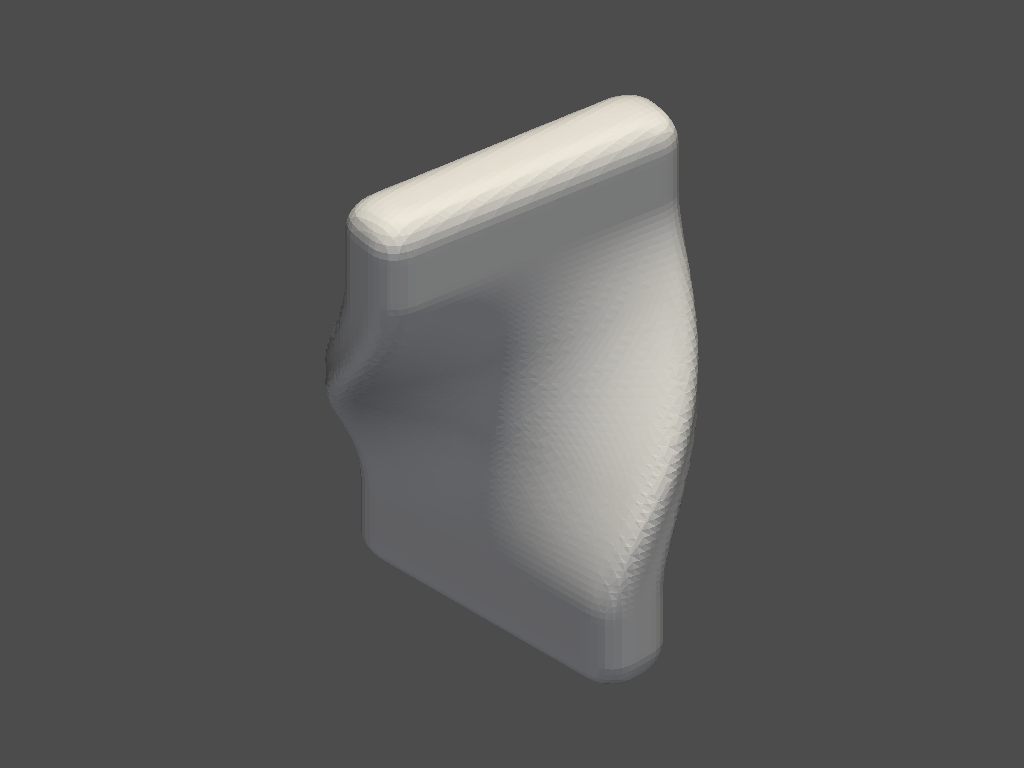
slab(z0=0, dx=5, dy=20, z1=30,r=2).twist_between(
a = 5*Z, # start to twist here
b = 25 * Z, # stop twisting here
# smoothstep funtion between 0° and 80°
e=units("80°").to("radians").m * ease.smoothstep
).save()
stretch
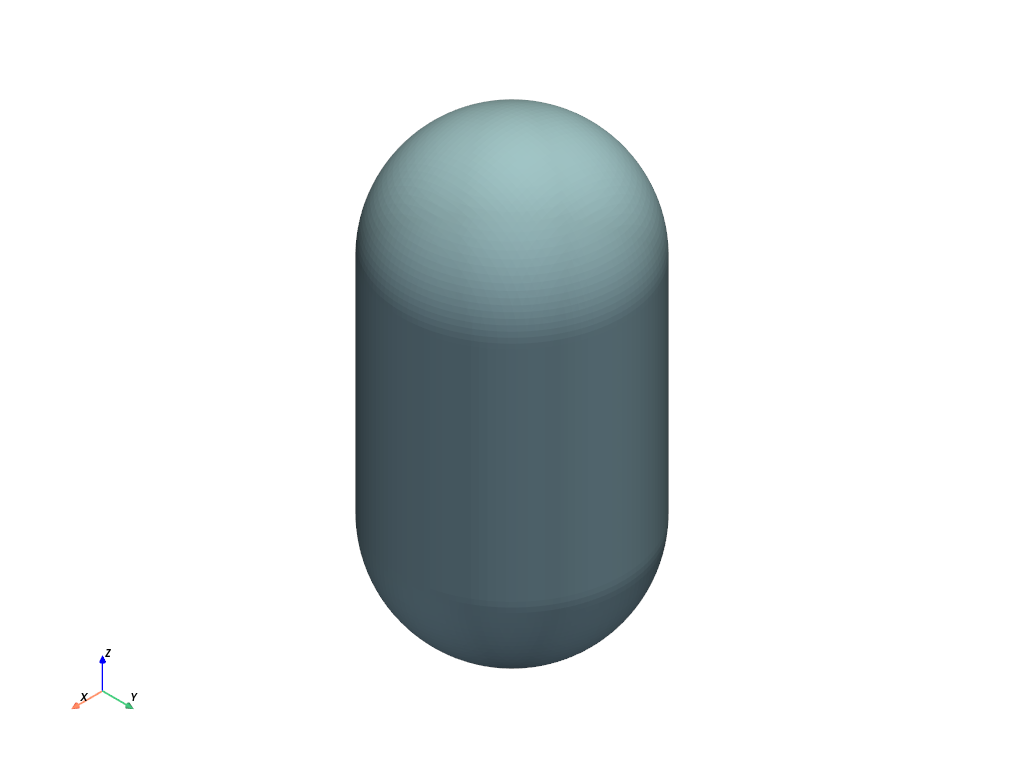
Stretch an object from here to there.
# stretch a sphere vertically to make a capsule
sphere(10).stretch(ORIGIN, 20*Z).save()
# specify symmetric=True to stretch equally in the opposite direction
rotate_stretch
Do a kind of rotary sweep like stretch(), but for rotation.
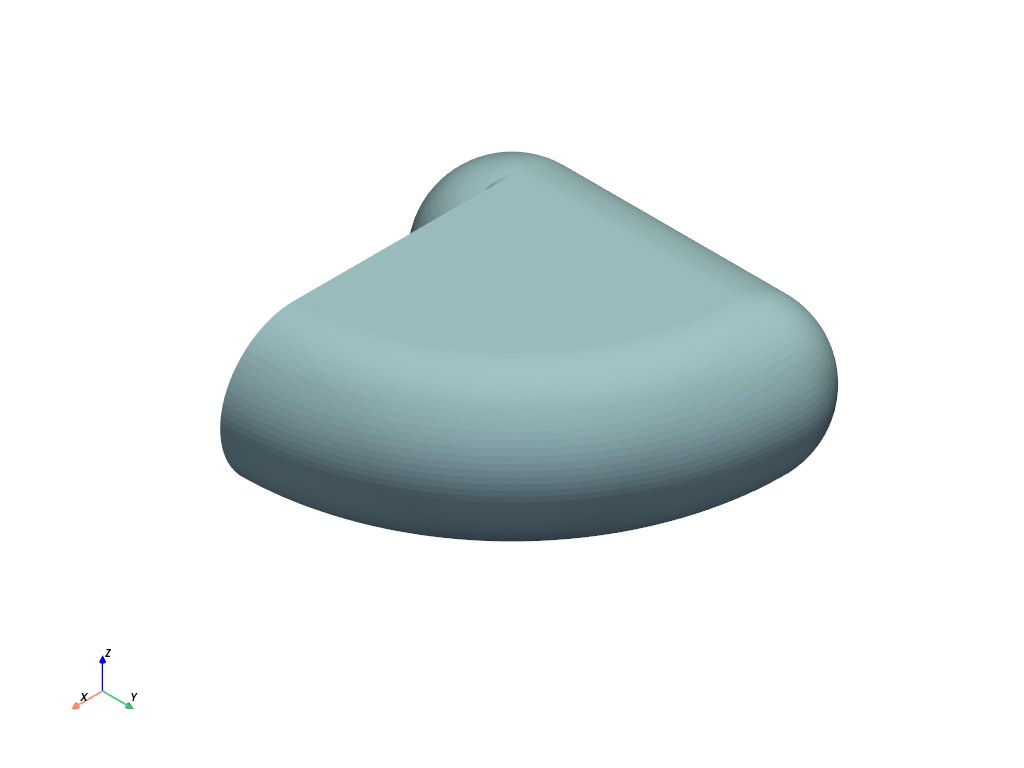
# make a quarter capsule sweep
# (”grab X, stretch it around origin to Y”)
capsule(ORIGIN,30*X,10).rotate_stretch(X,Y).save()
# the same with angle, Z is default rotation axis
capsule(ORIGIN,30*X,10).rotate_stretch(angle=units("90°")).save()
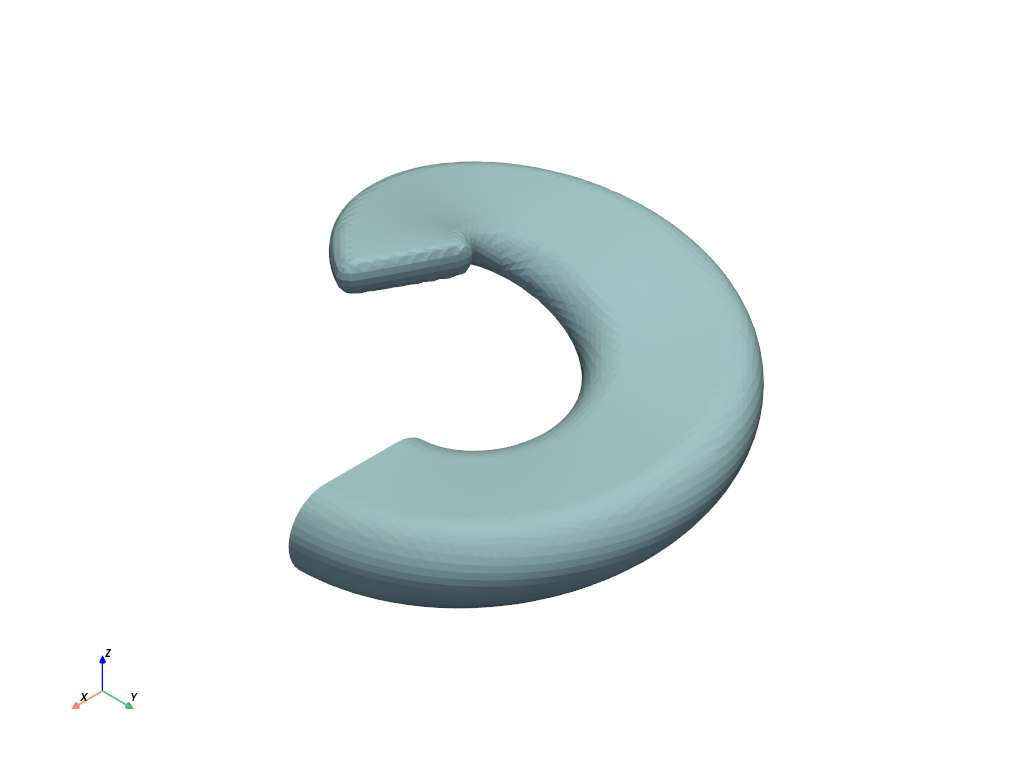
Along the way, one can move along the rotation axis, outwards or modulate the thickness:
# sweep a capsule around
capsule(30*X, 50*X, 10).rotate_stretch(
angle=units("330°"),
shear=40*ease.smoothstep, # move smoothly up along rotation axis while rotating
thicken=-6*ease.smoothstep, # gradually get thinner along the way
fling=-20*ease.smoothstep, # gradually move closer to rotation axis
).save(sparse=False)
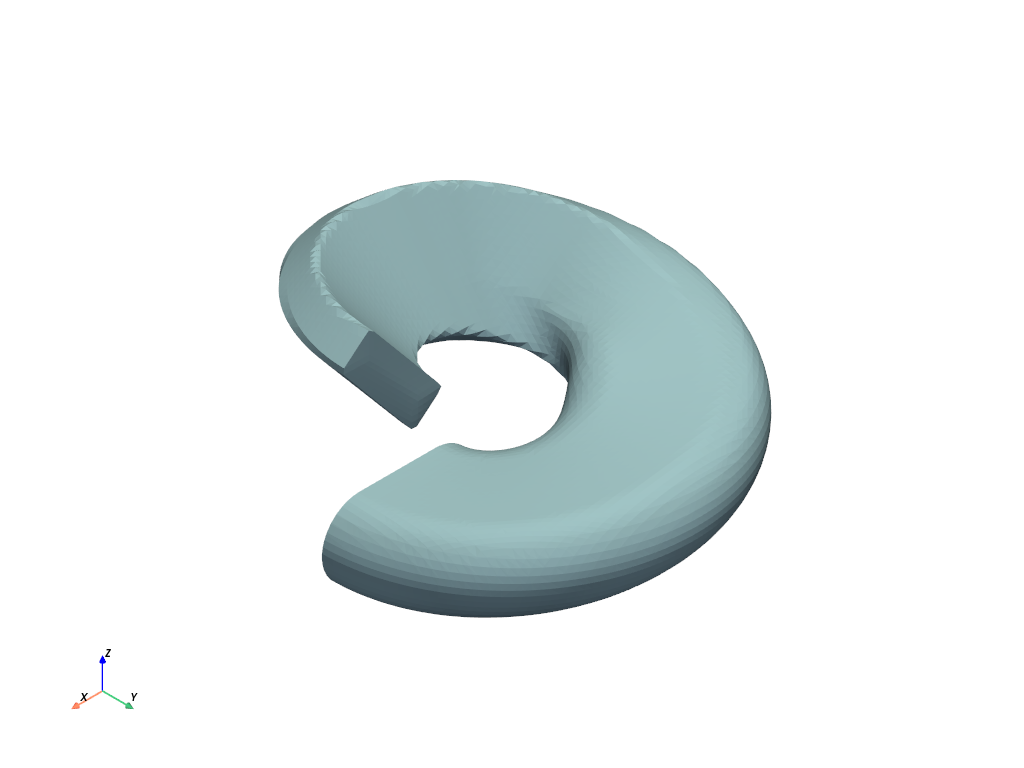
Changing shape along the way is also possible:
# sweep a capsule around
capsule(20 * X, 40 * X, 10).rotate_stretch(
shear=30 * ease.smoothstep, # spiral upwards
# transition to a slightly rotated box
transition=slab(dx=30,dy=10,dz=10,r=1).rotate(-units("50°"),Y).translate(30*X),
transition_ease=ease.smoothstep.chain().chain(), # transition smoothly to box
).save(sparse=False)
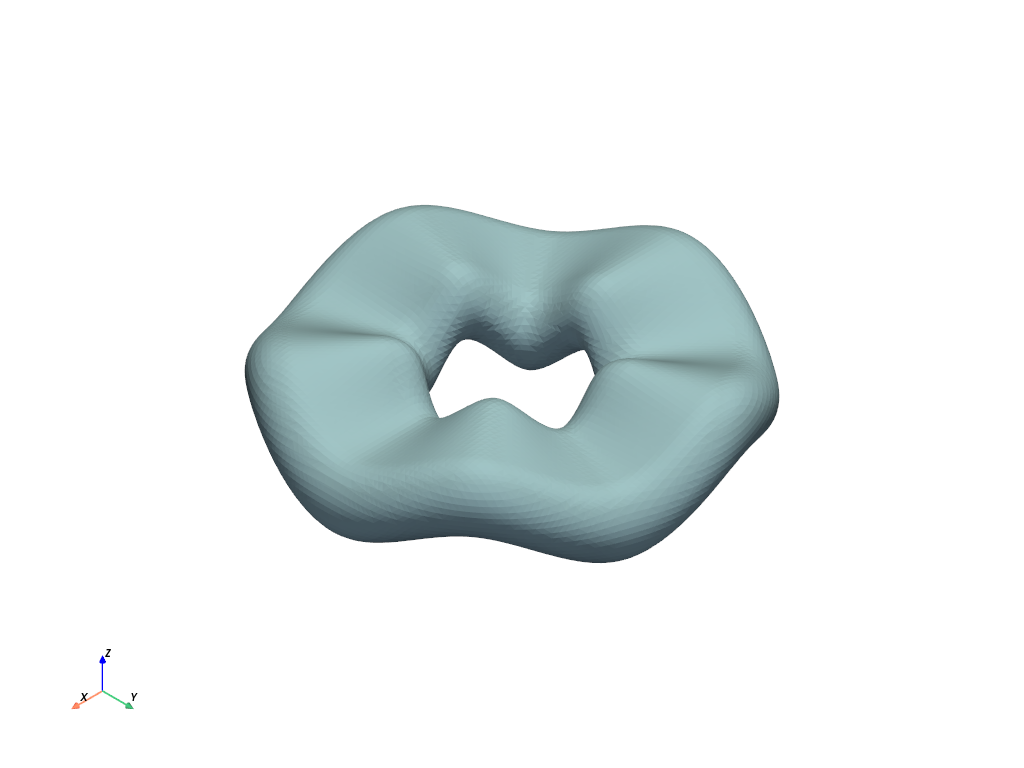
# sweep a capsule around
capsule(30 * X, 50 * X, 10).rotate_stretch(
shear=10 * (ease.smoothstep.symmetric-0.5).repeat(5), # up and down along the way
).save(sparse=False)
shear
Grab a point and move it into a direction, keeping another point fix. This can be used to perform a shearing operation.
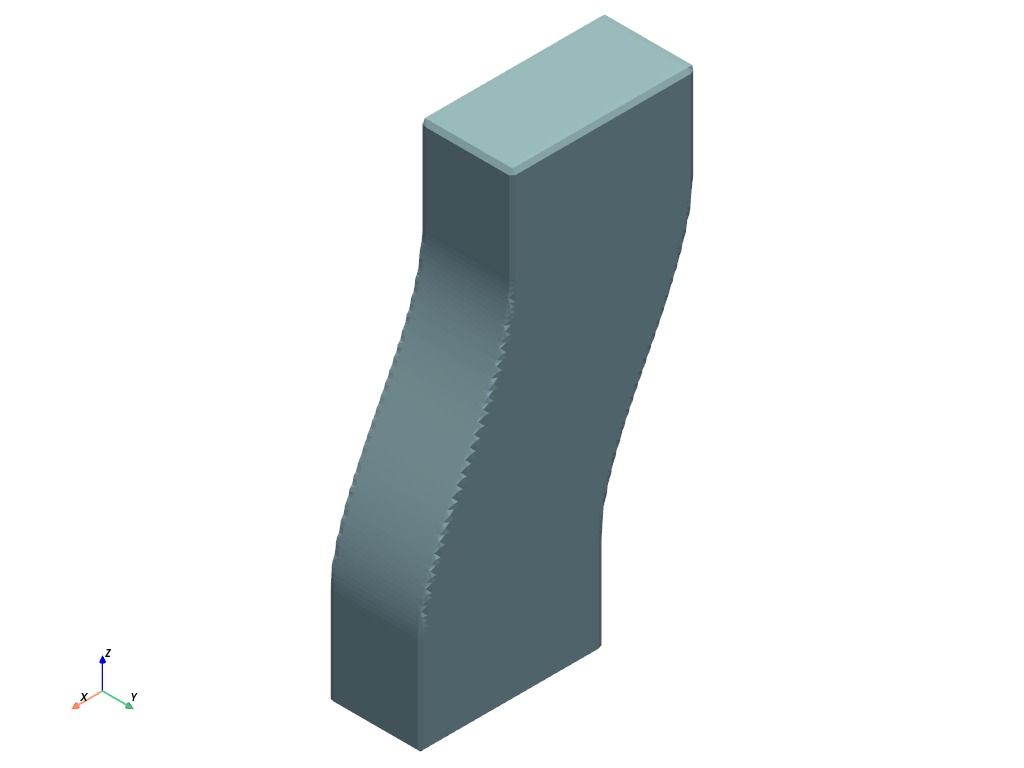
box([20,10,50]).shear(fix=-15*Z, grab=15*Z, move=-10*X, e=ease.smoothstep).save()
The easing function can be used to scale the movement along the way, e.g. to make a notch.
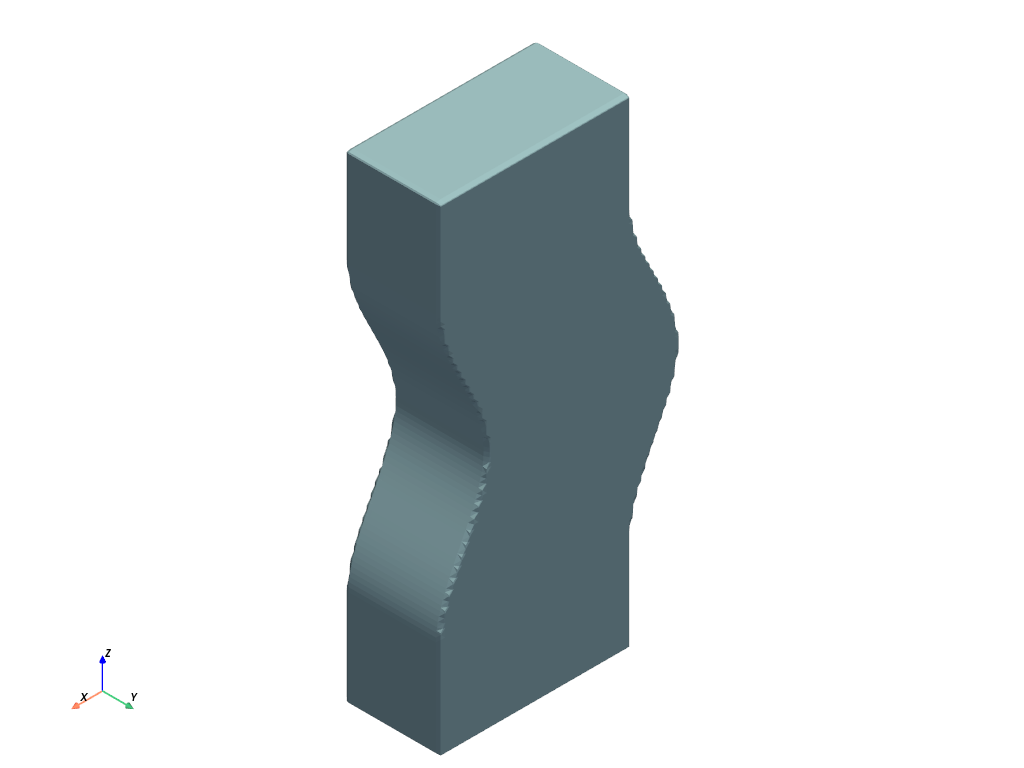
box([20,10,50]).shear(-15*Z, 15*Z, -5*X, e=ease.smoothstep.symmetric).save()
modulate_between
Modulate the thickness between two points.
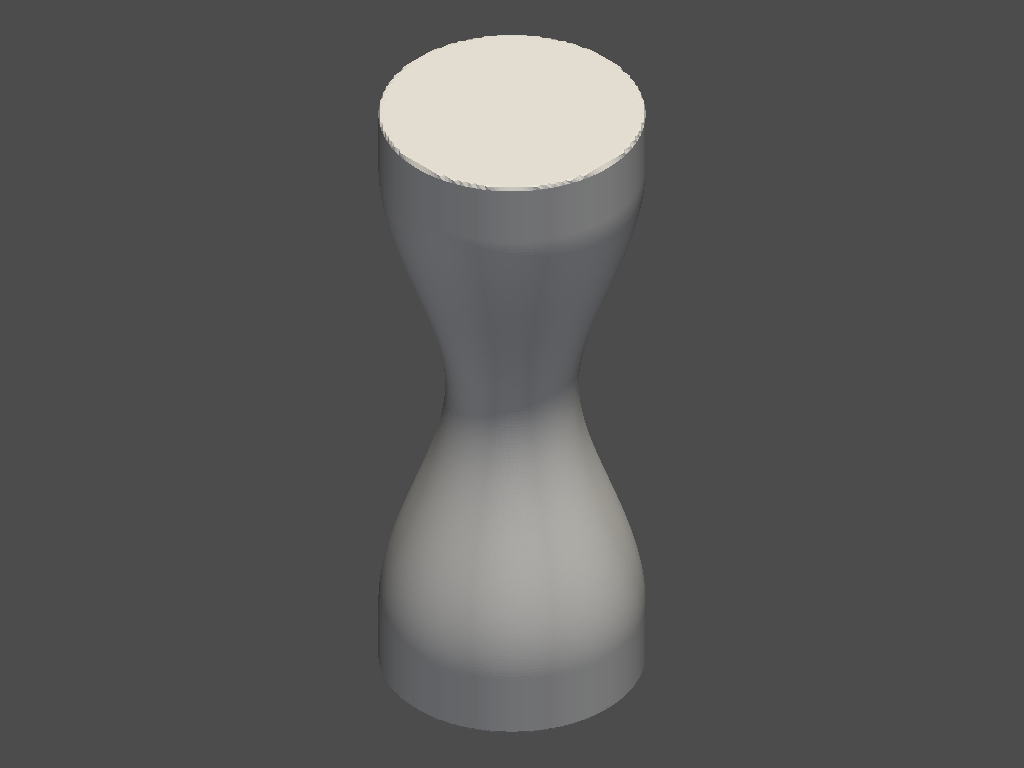
# make a cylinder
(cylinder(10) & slab(dz=50)).modulate_between(
-20 * Z, # start modulating here
20 * Z, # stop modulating here
# easing to apply.
# symmetric smoothstep function for negative dip.
e=-5 * ease.smoothstep.symmetric,
).save()
chamfer
This is a wrapper around stretch() and modulate_between() to facilitate a chamfer cut along a plane.
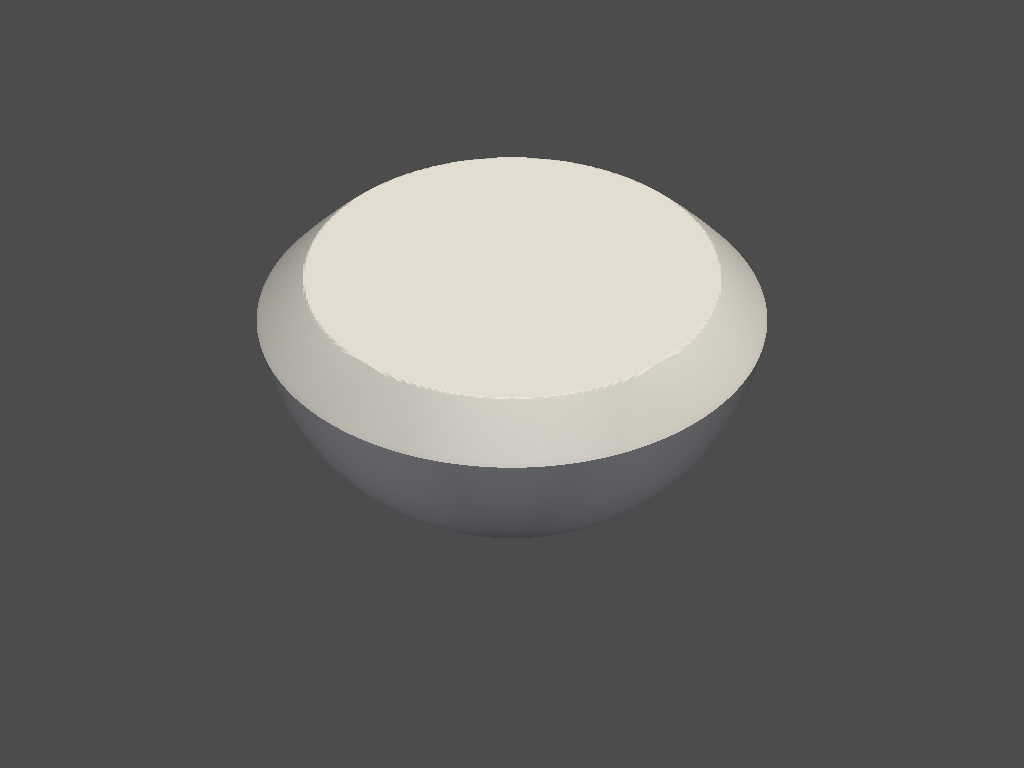
sphere(10).chamfercut(2,at=ORIGIN, direction=-Z).save()
bend
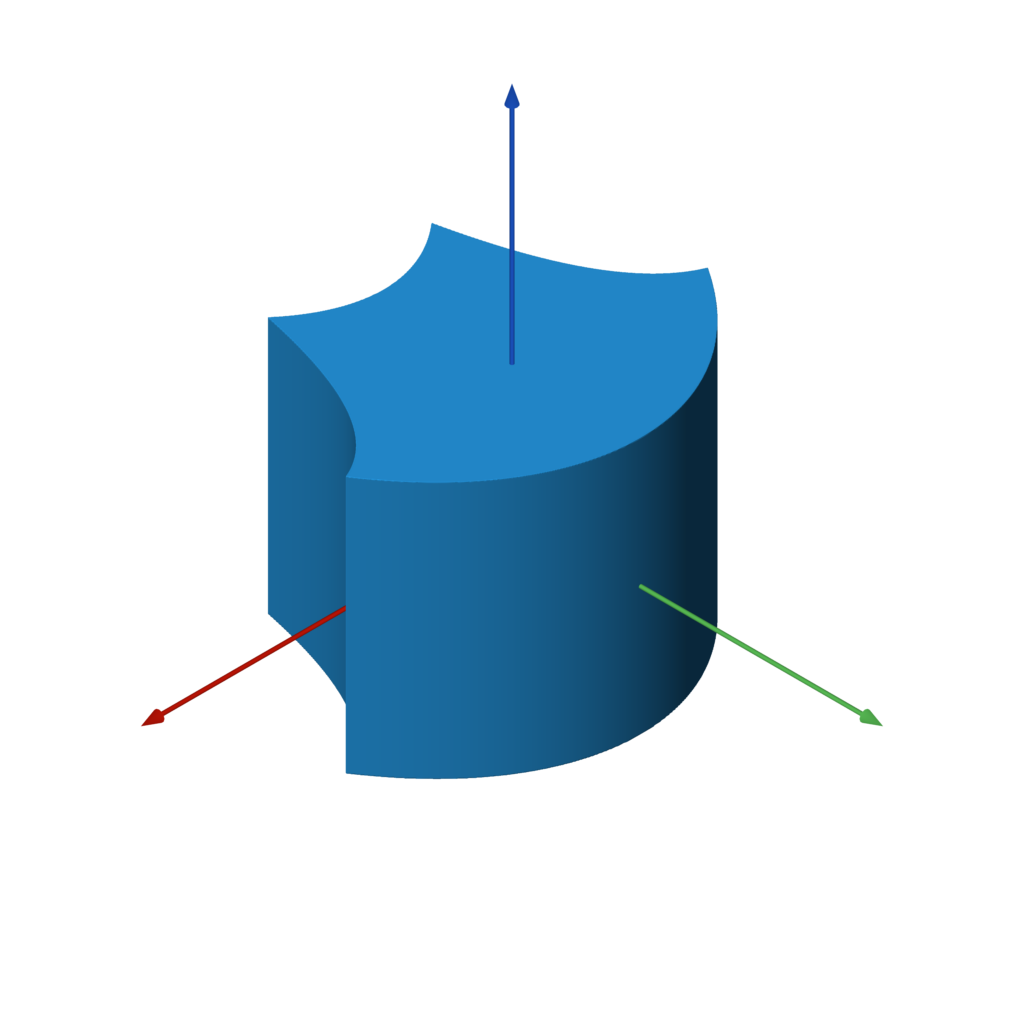
bend(other, k)
f = box().bend(1)
bend_linear
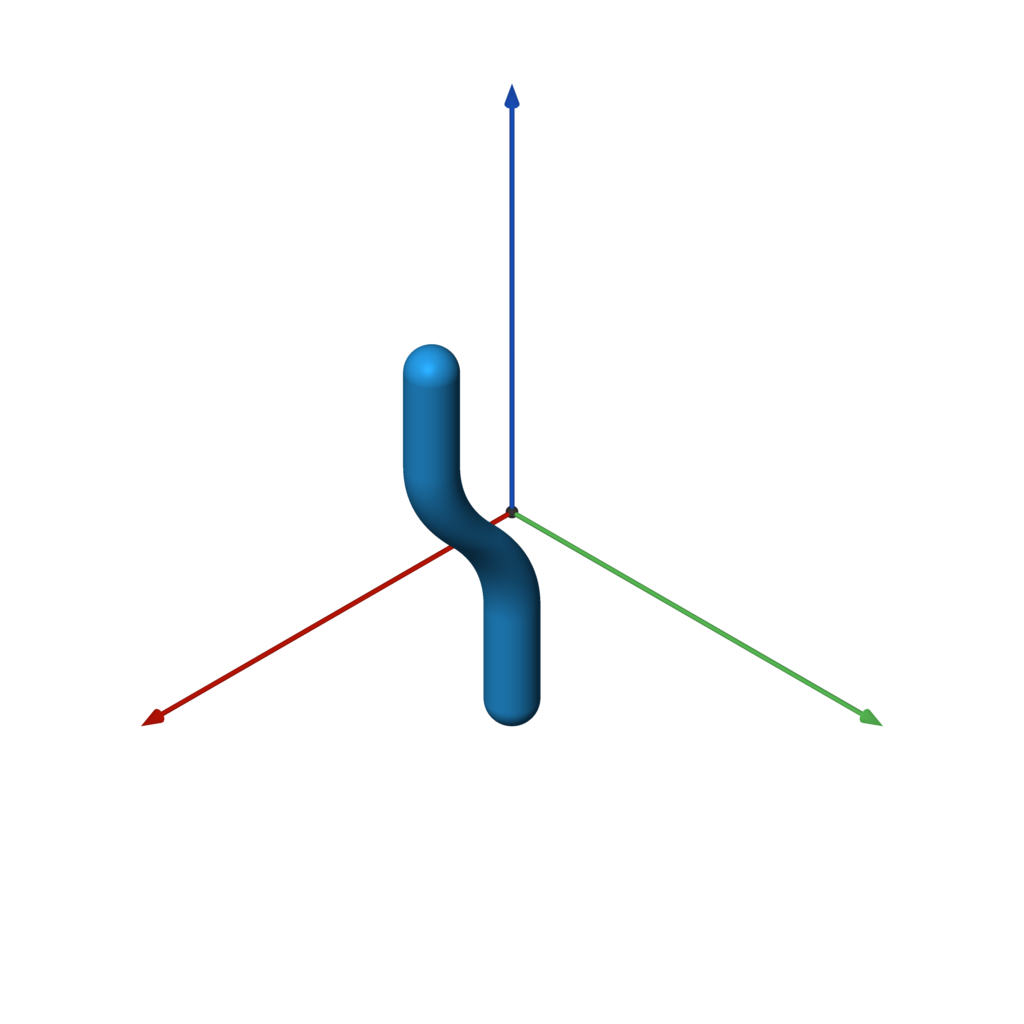
bend_linear(other, p0, p1, v, e=ease.linear)
f = capsule(-Z * 2, Z * 2, 0.25).bend_linear(-Z, Z, X, ease.in_out_quad)
bend_radial
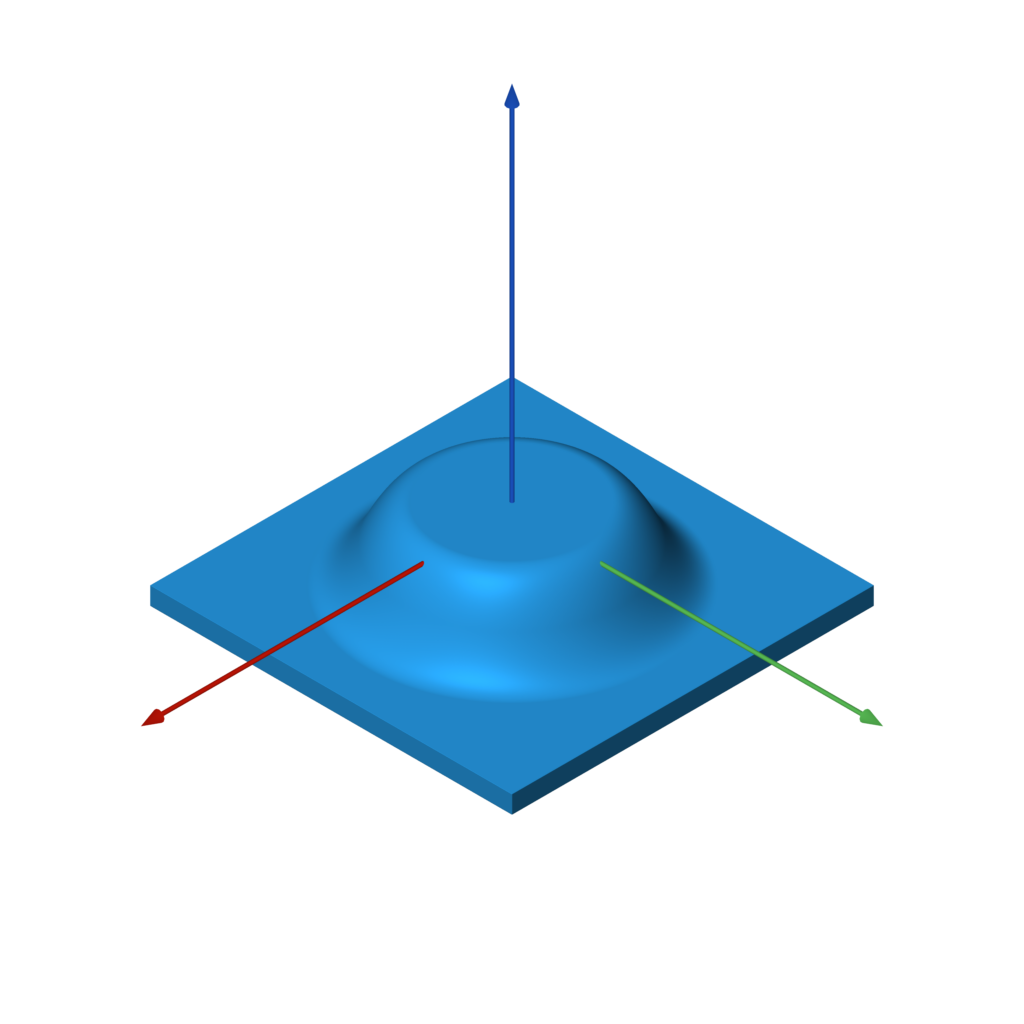
bend_radial(other, r0, r1, dz, e=ease.linear)
f = box((5, 5, 0.25)).bend_radial(1, 2, -1, ease.in_out_quad)
transition_linear
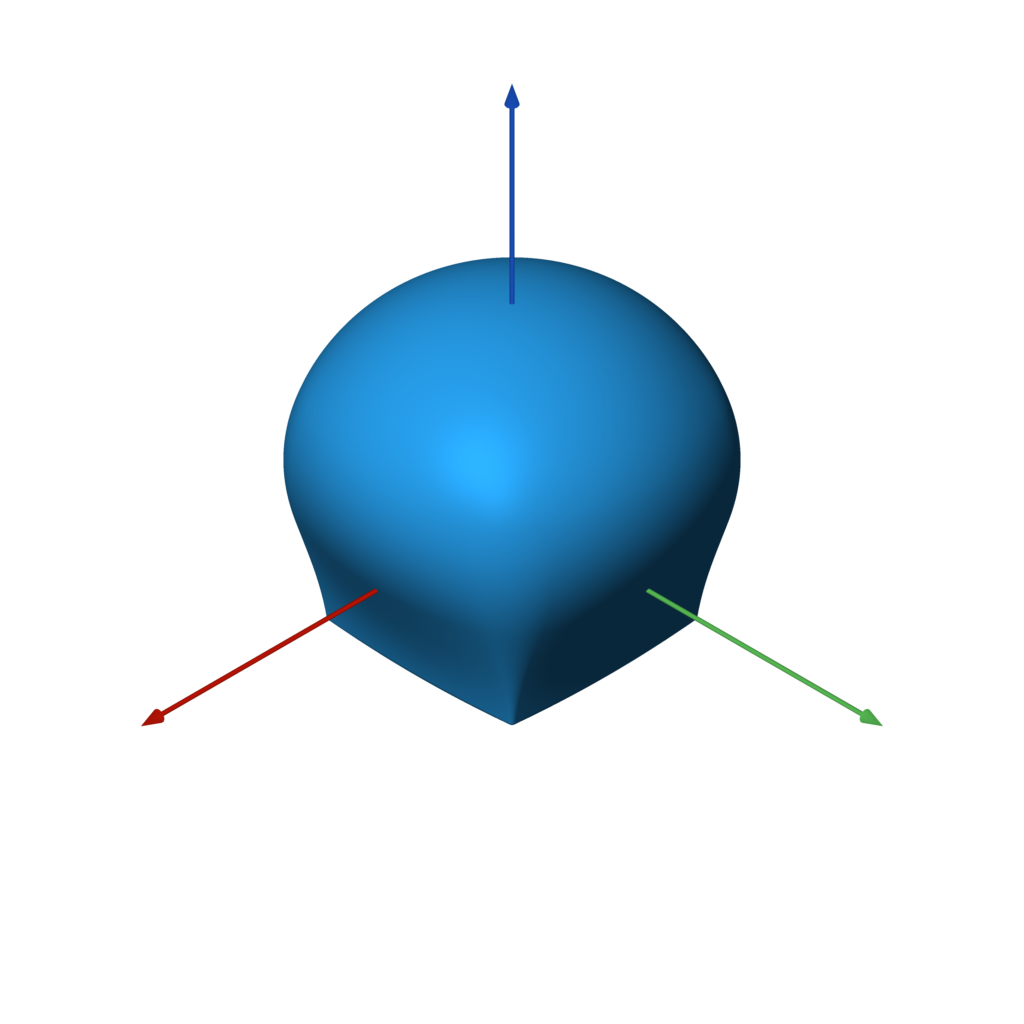
transition_linear(f0, f1, p0=-Z, p1=Z, e=ease.linear)
f = box().transition_linear(sphere(), e=ease.in_out_quad)
transition_radial
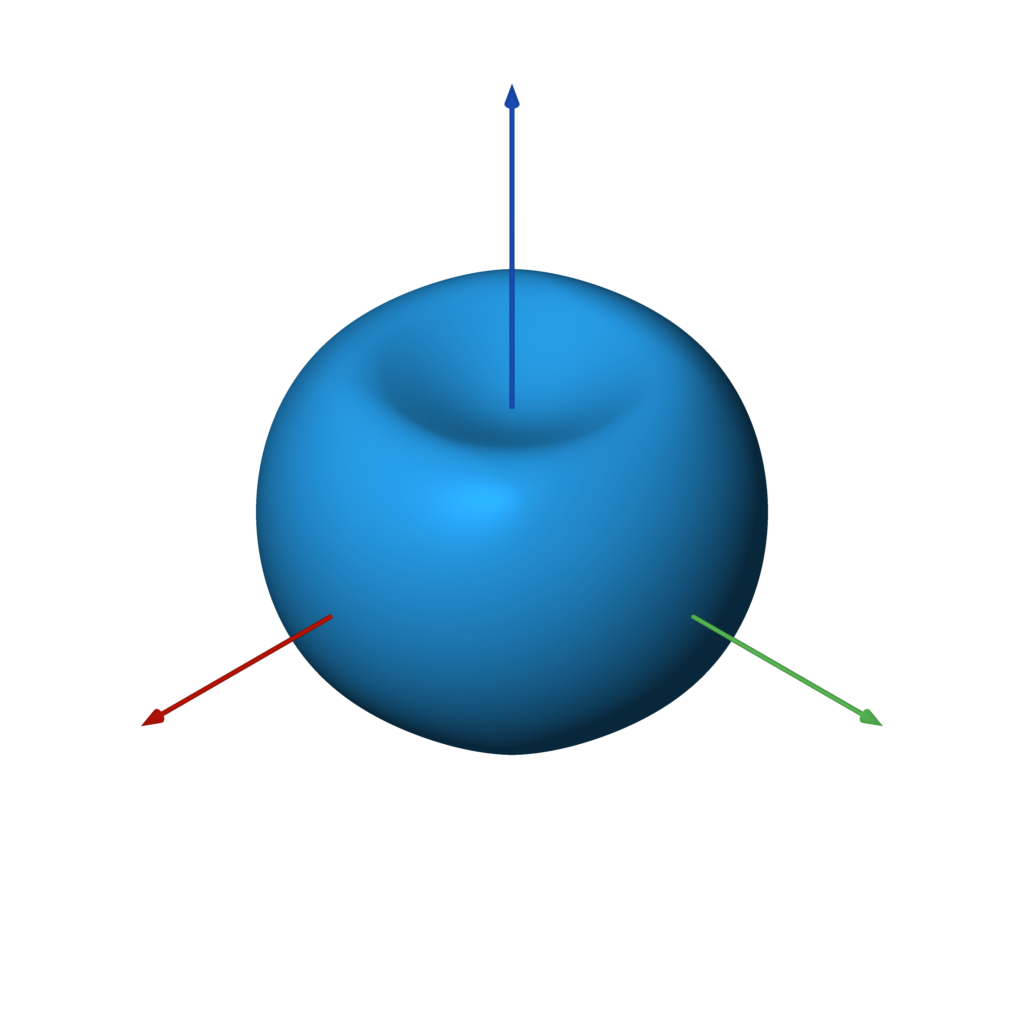
transition_radial(f0, f1, r0=0, r1=1, e=ease.linear)
f = box().transition_radial(sphere(), e=ease.in_out_quad)
wrap_around
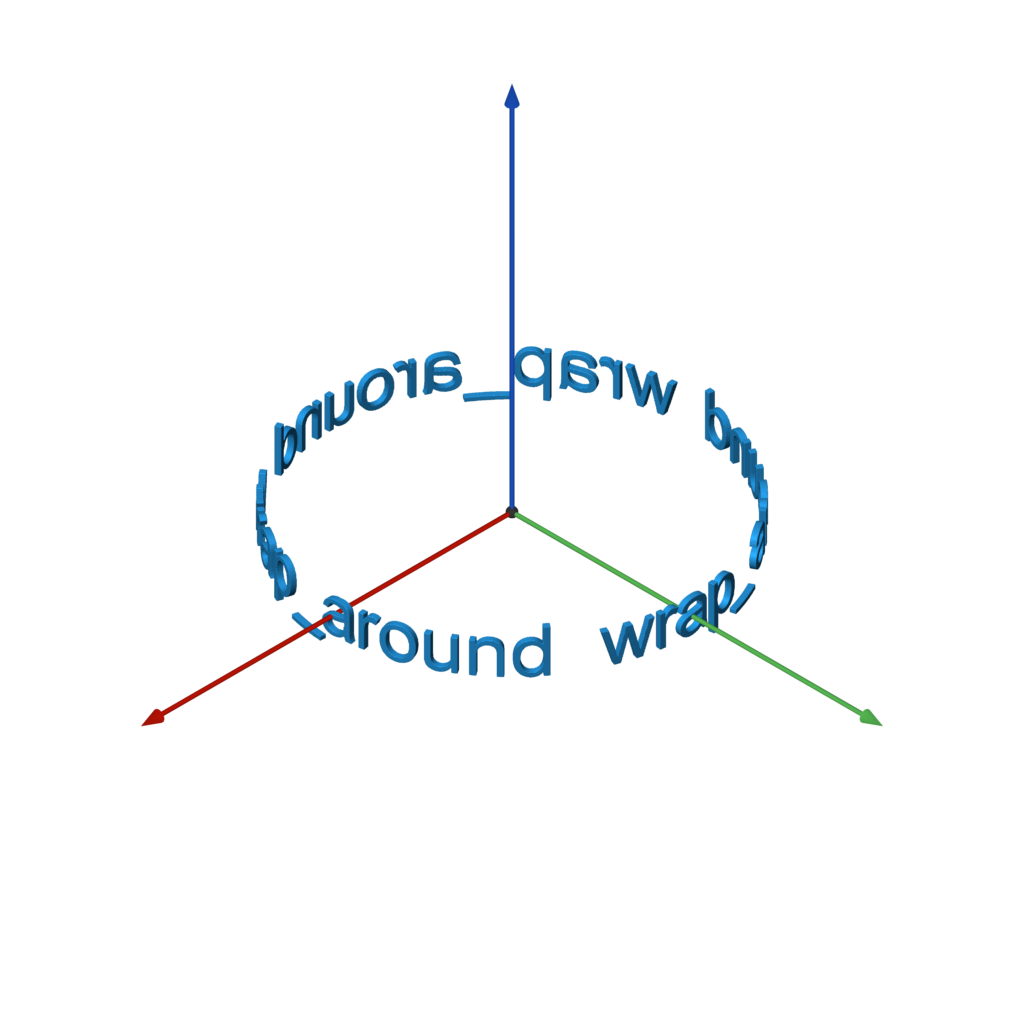
wrap_around(other, x0, x1, r=None, e=ease.linear)
FONT = 'Arial'
TEXT = ' wrap_around ' * 3
w, h = measure_text(FONT, TEXT)
f = text(FONT, TEXT).extrude(0.1).orient(Y).wrap_around(-w / 2, w / 2)
2D to 3D Operations
extrude
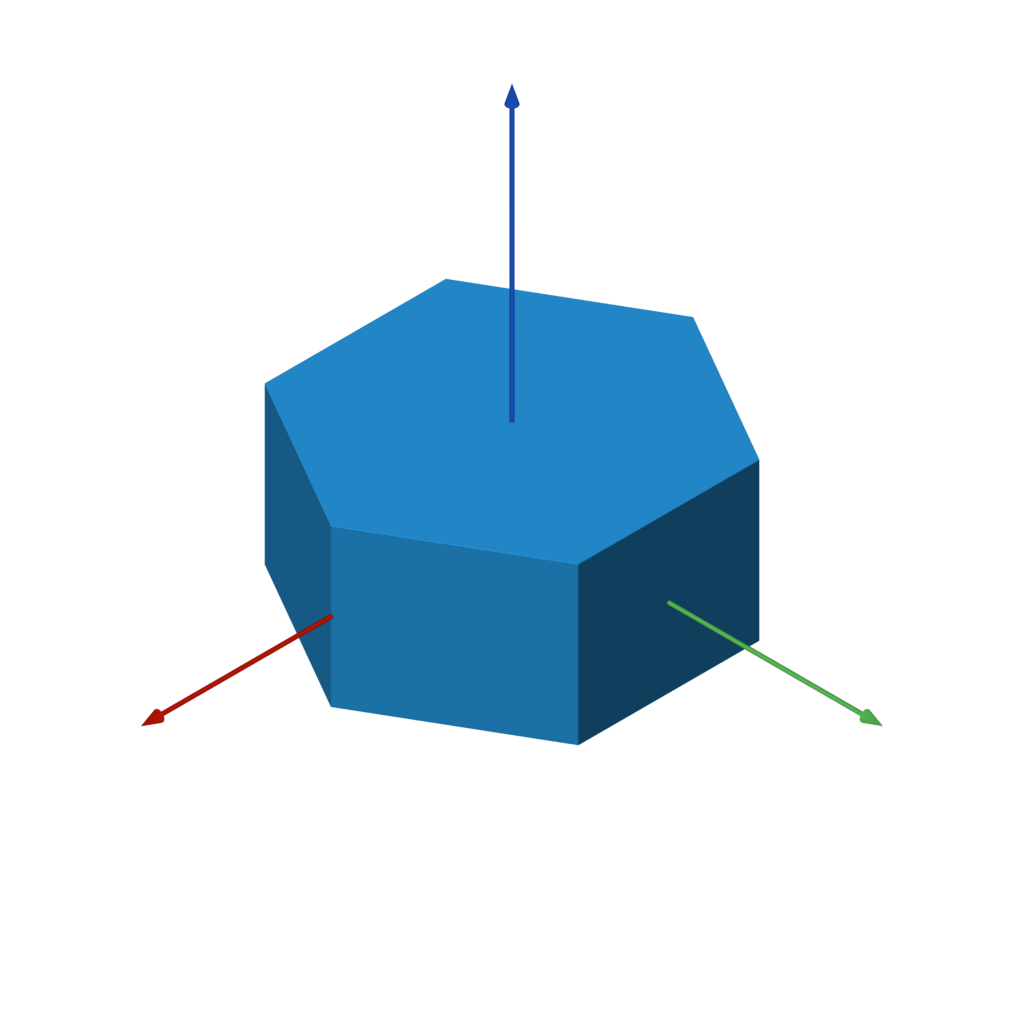
extrude(other, h)
f = hexagon(1).extrude(1)
extrude_to
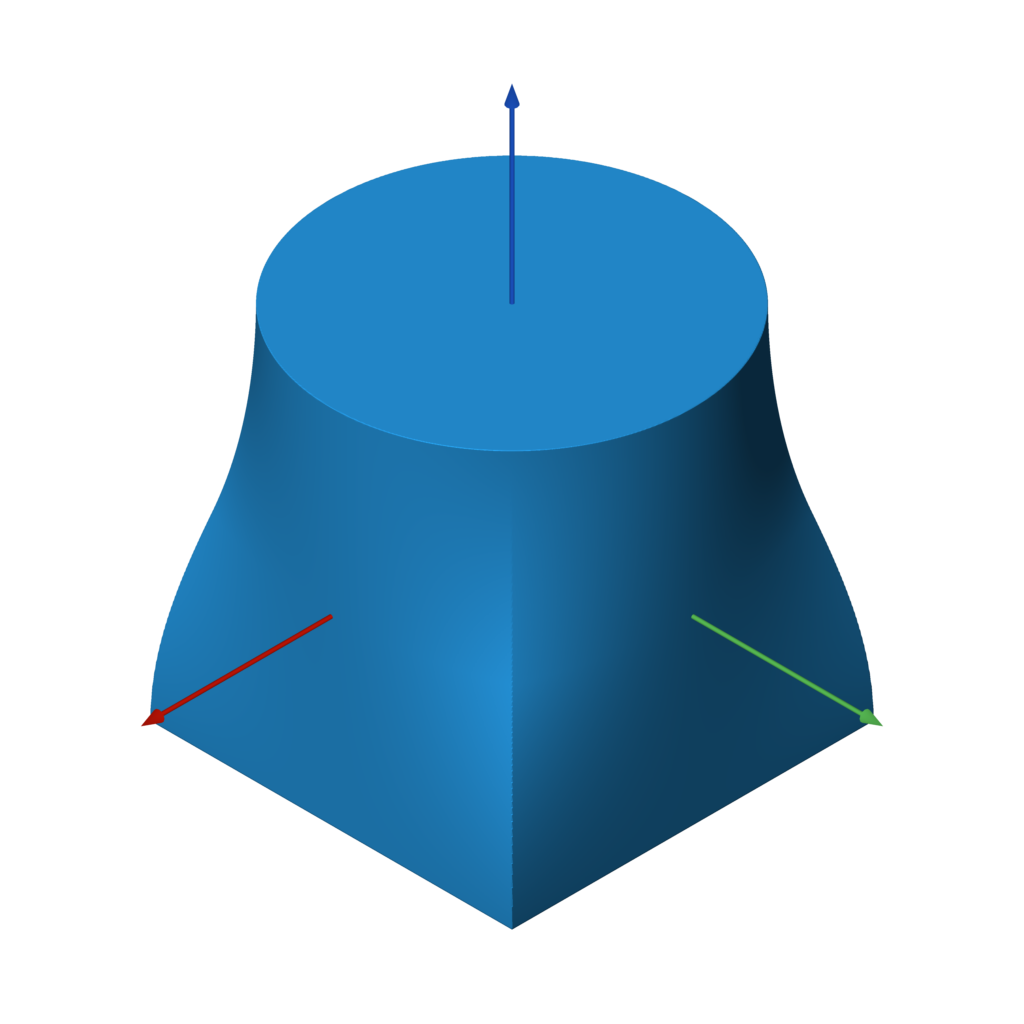
extrude_to(a, b, h, e=ease.linear)
f = rectangle(2).extrude_to(circle(1), 2, ease.in_out_quad)
revolve
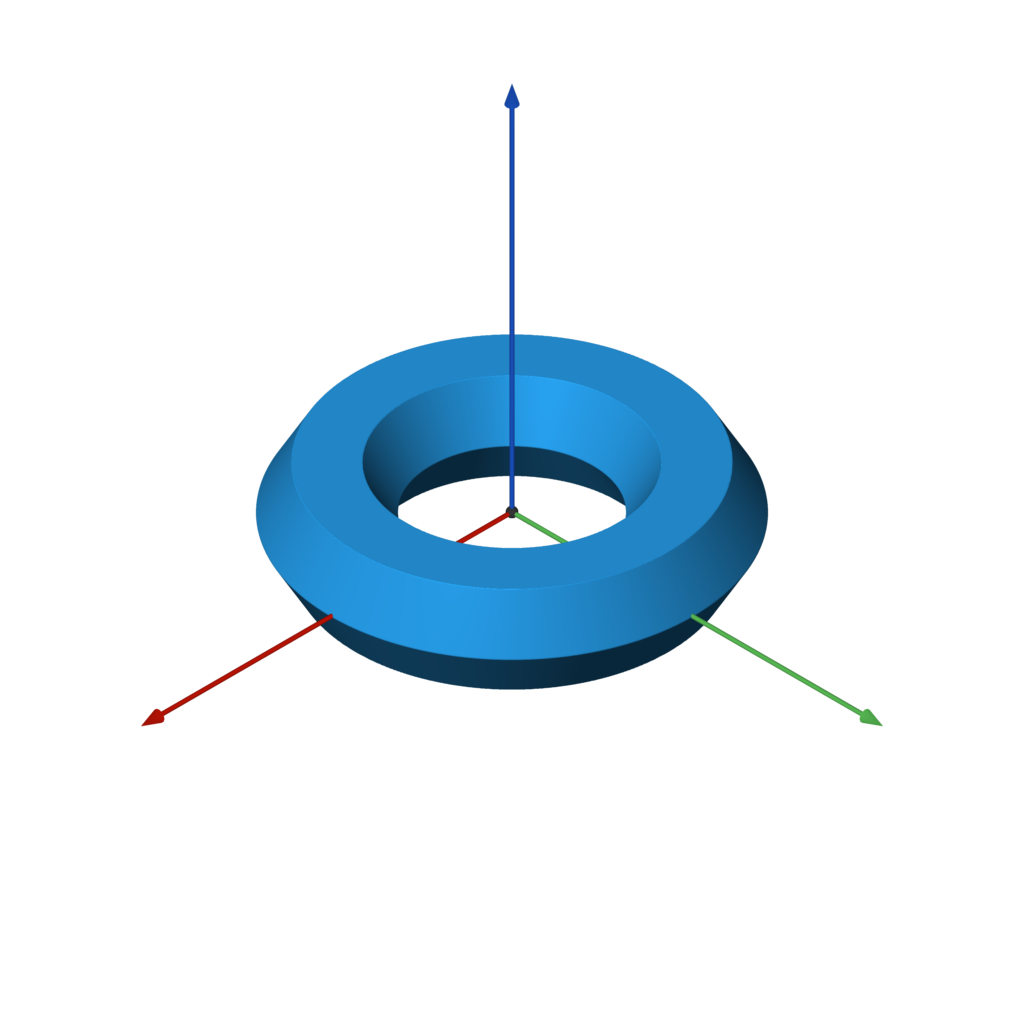
revolve(other, offset=0)
f = hexagon(1).revolve(3)
3D to 2D Operations
slice
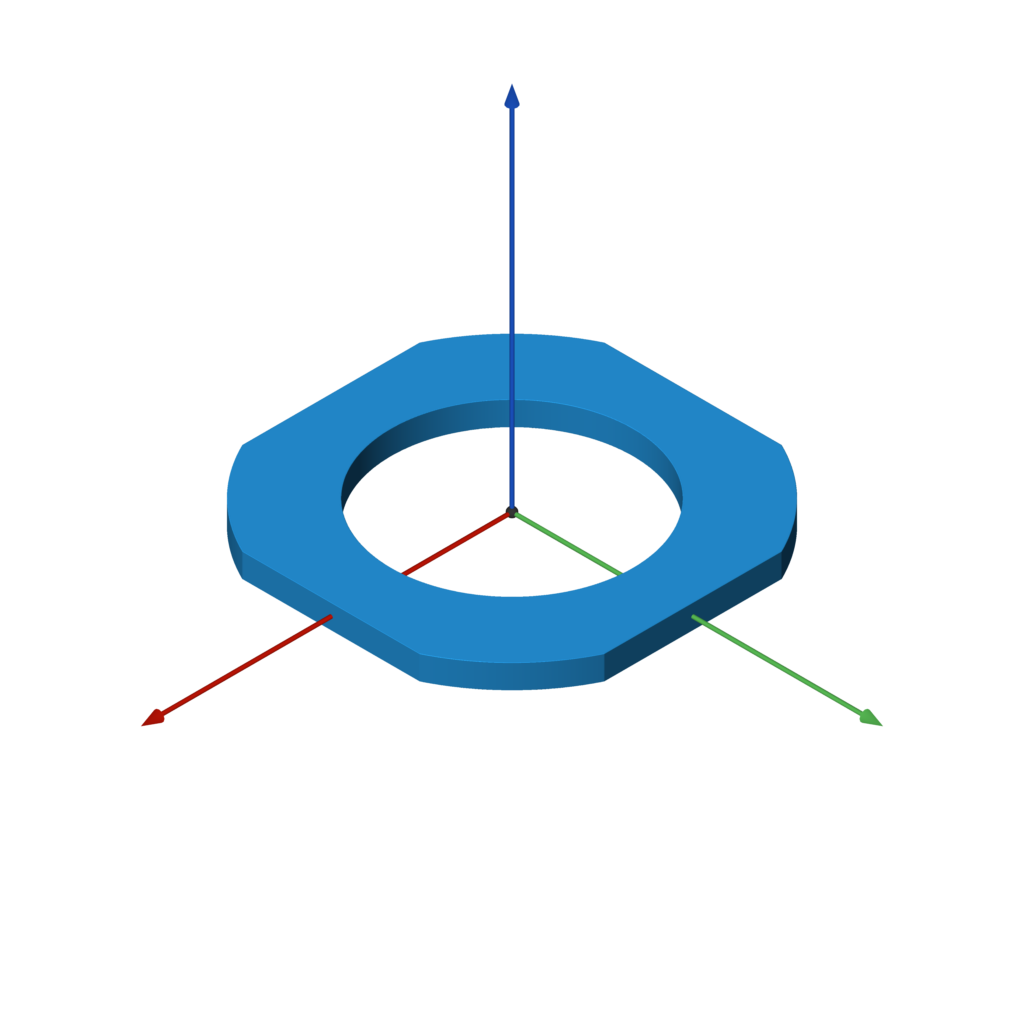
slice(other)
f = example.translate((0, 0, 0.55)).slice().extrude(0.1)
2D Primitives
circle
line
rectangle
rounded_rectangle
equilateral_triangle
hexagon
rounded_x
polygon
Project details
Download files
Download the file for your platform. If you're not sure which to choose, learn more about installing packages.





